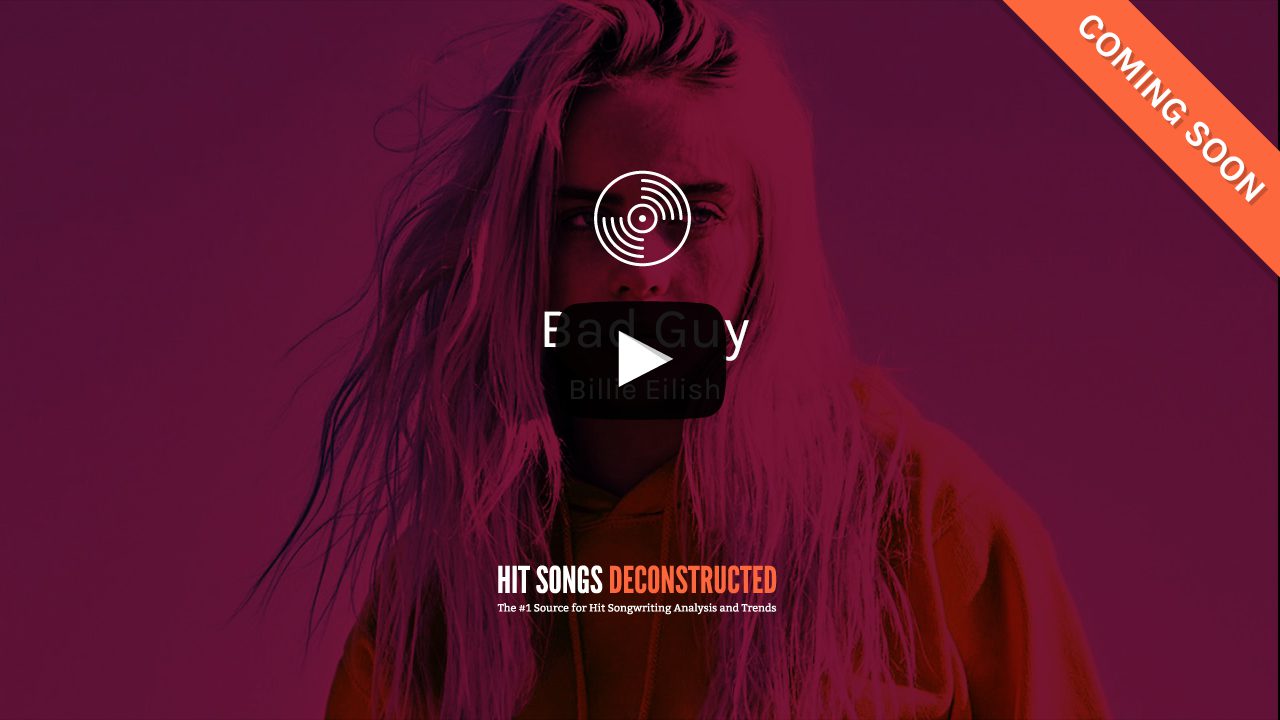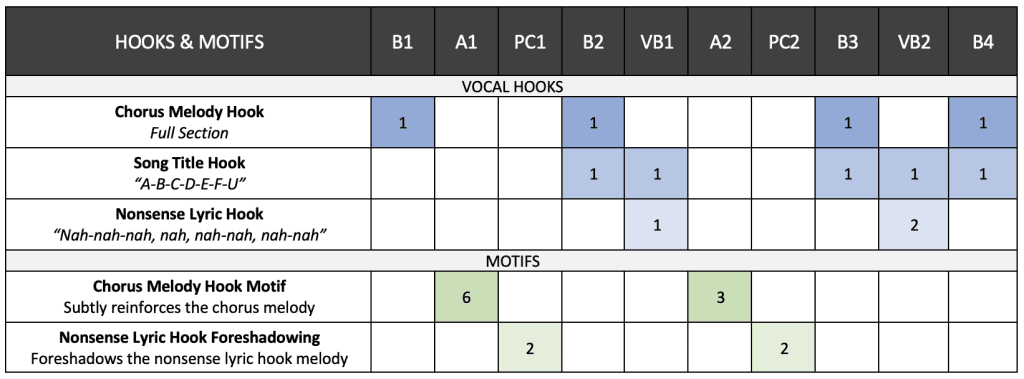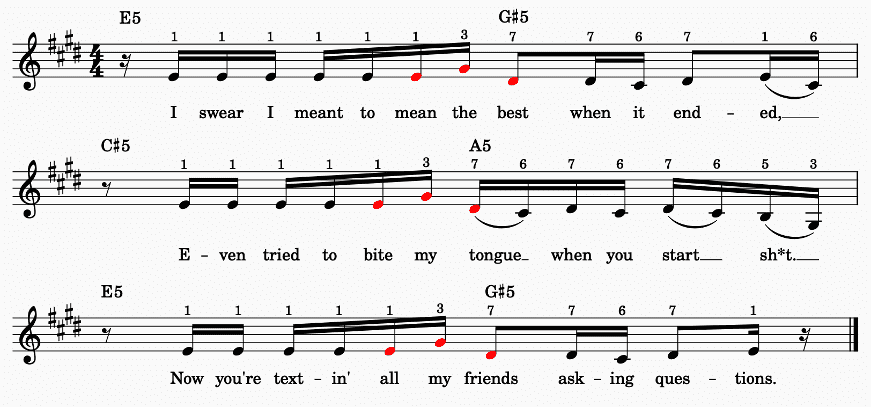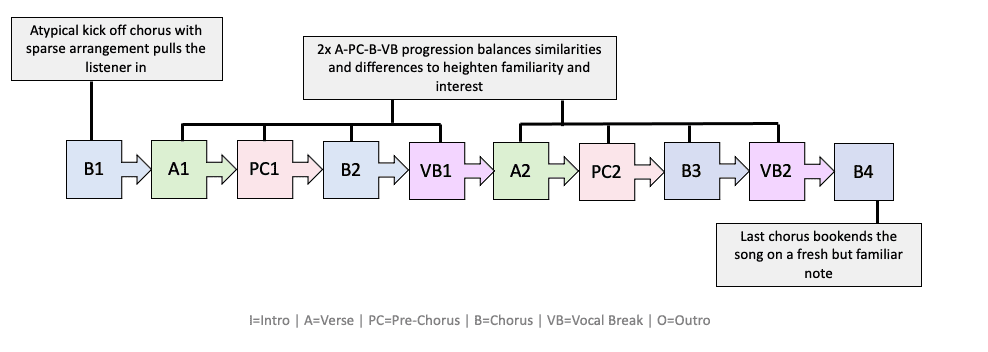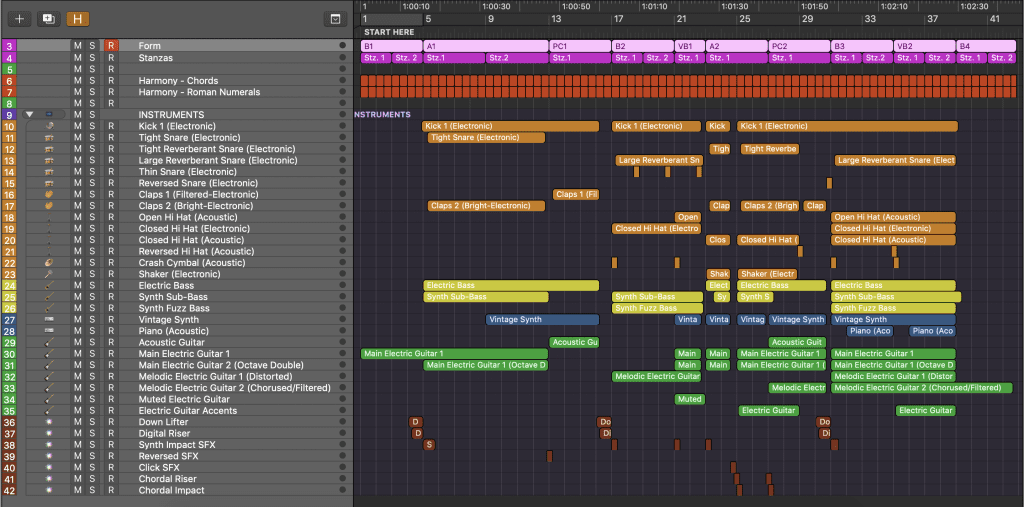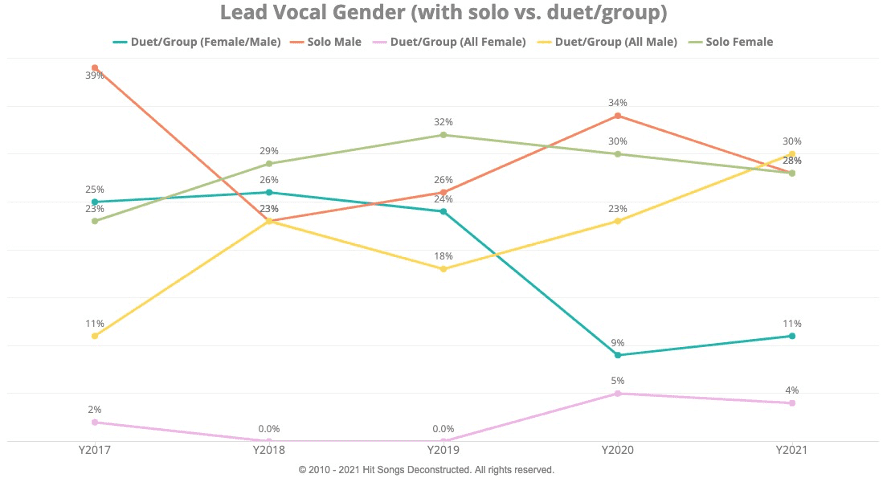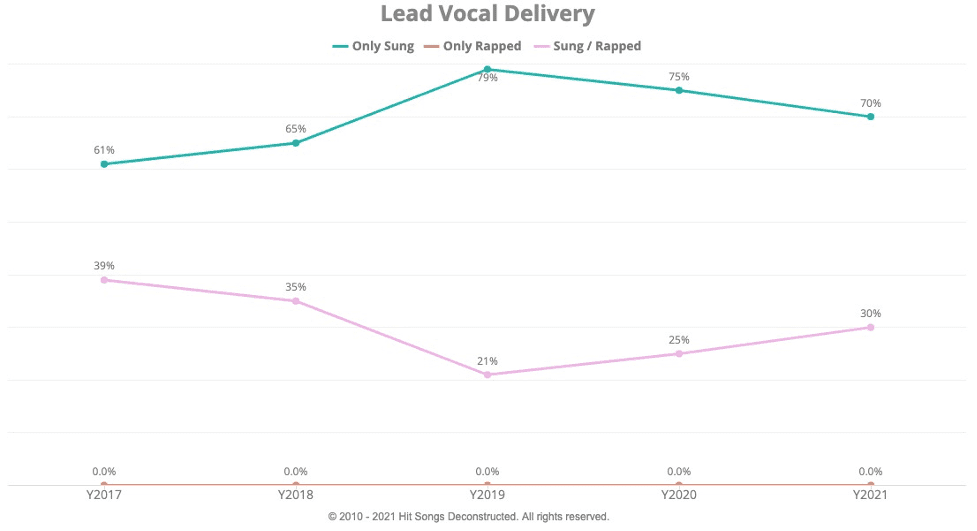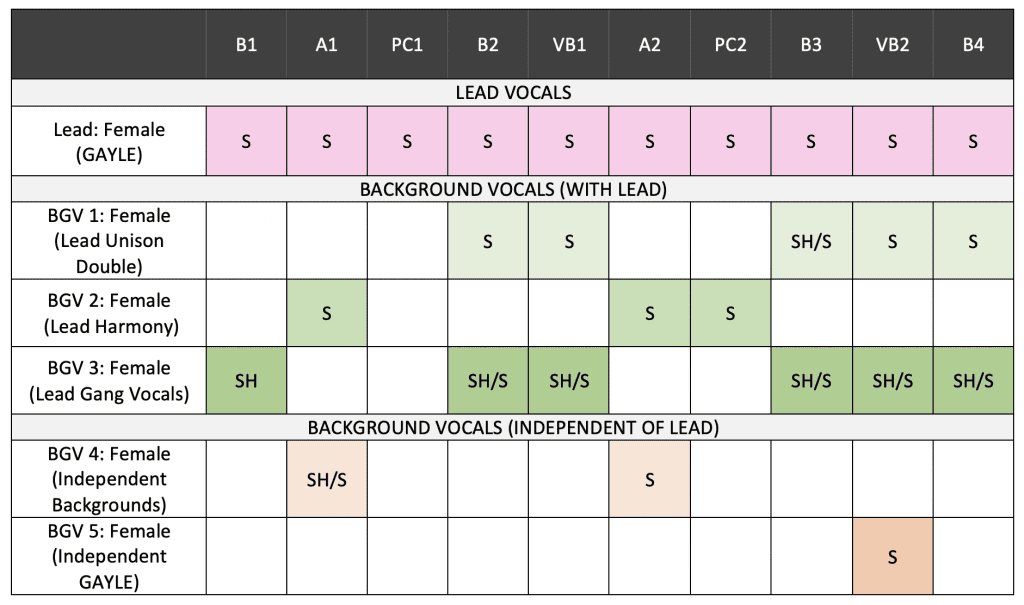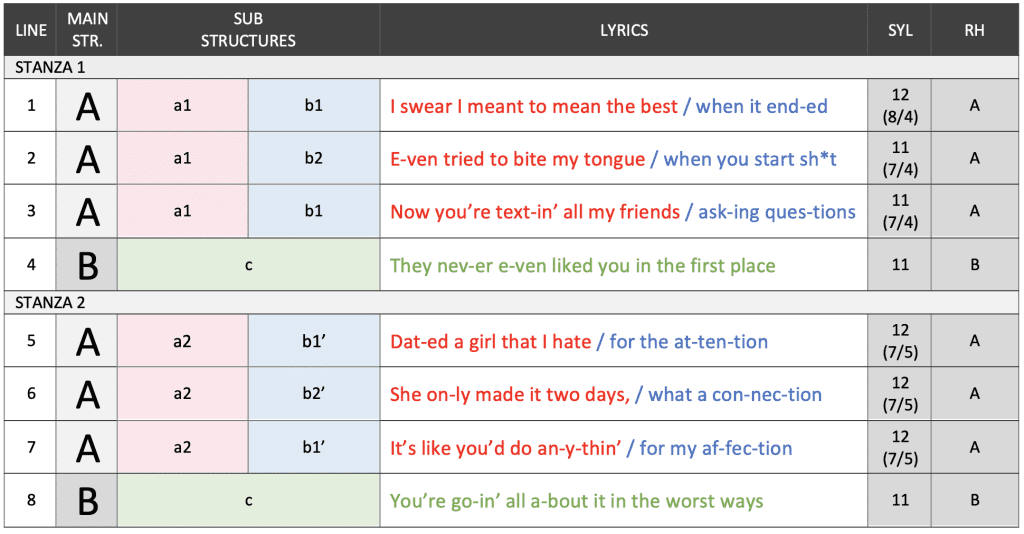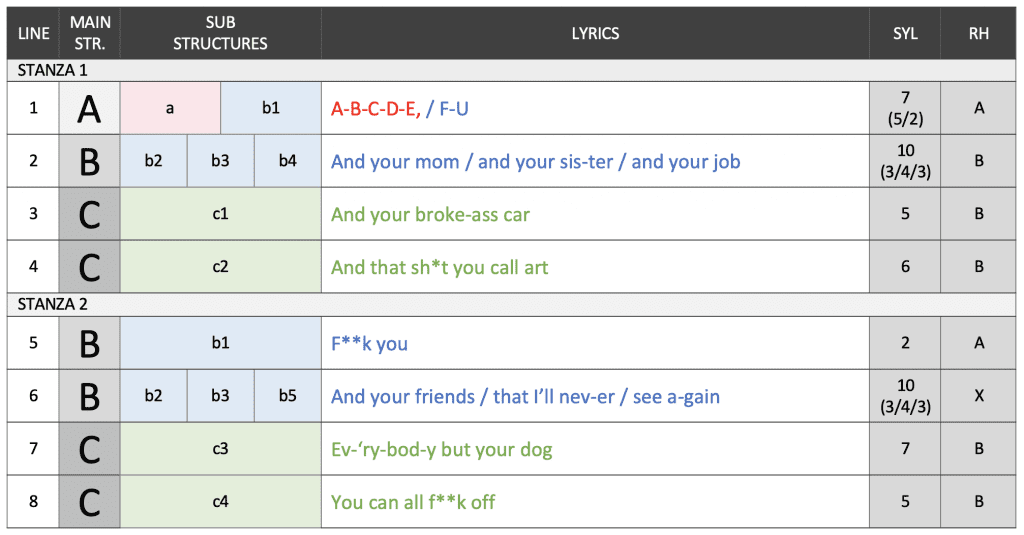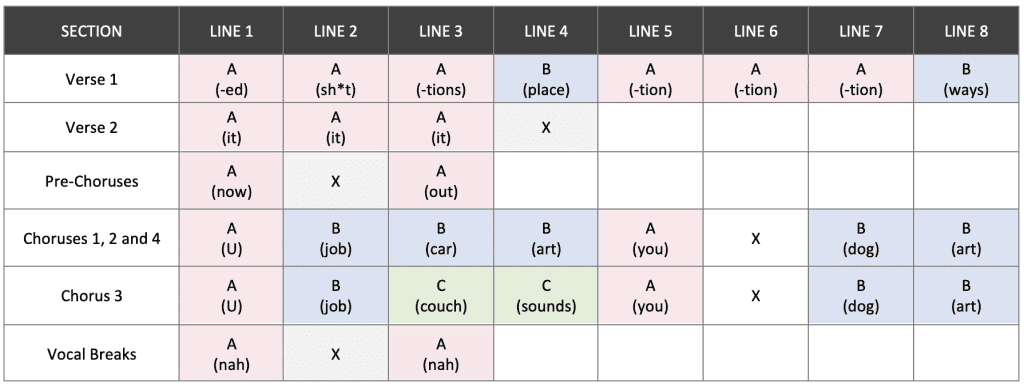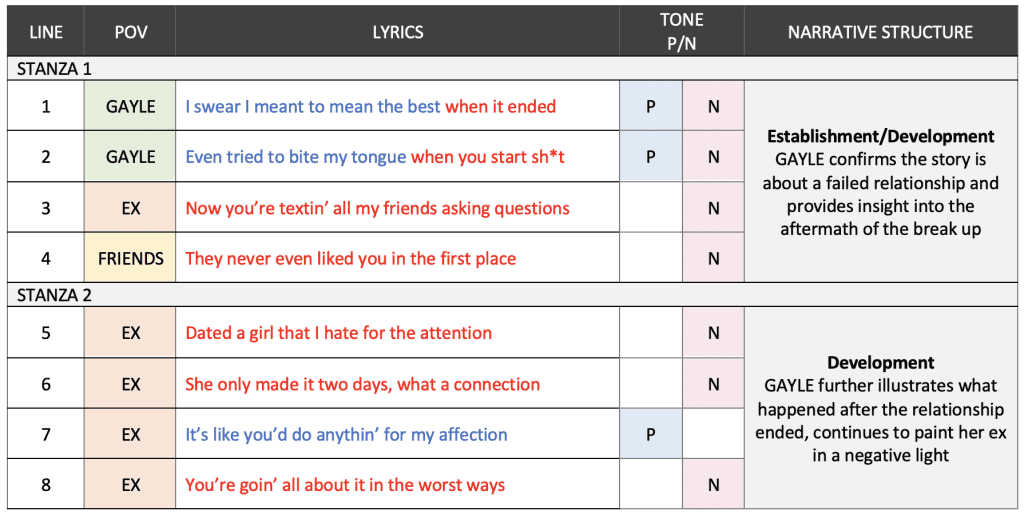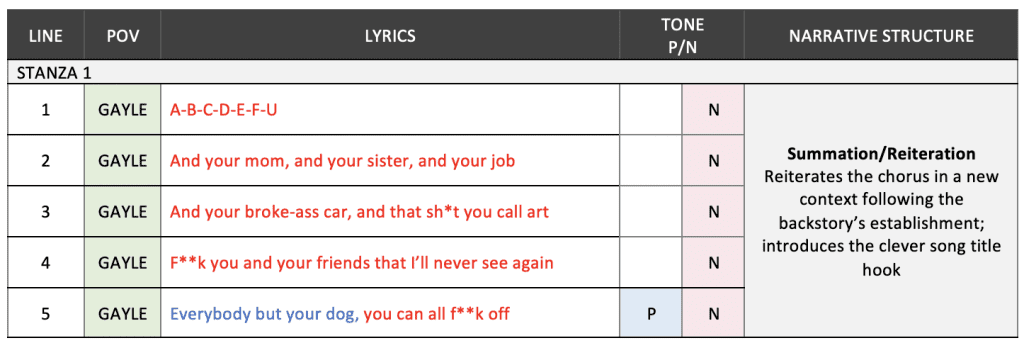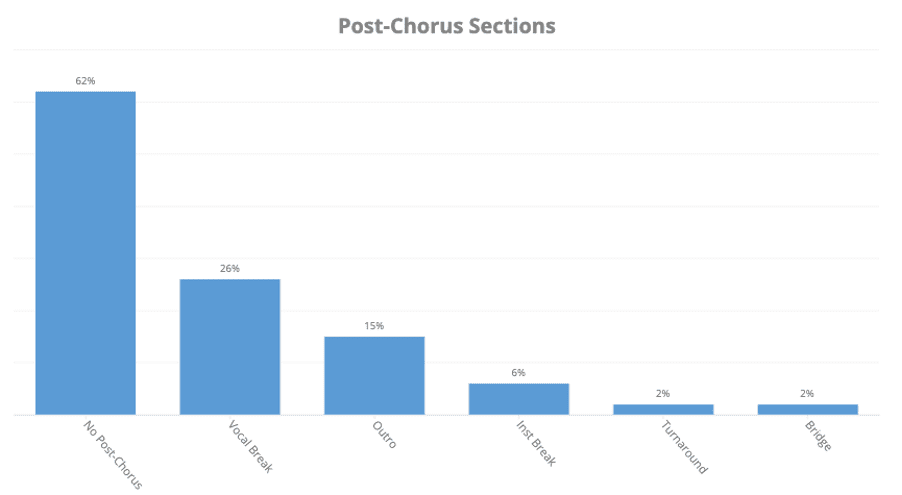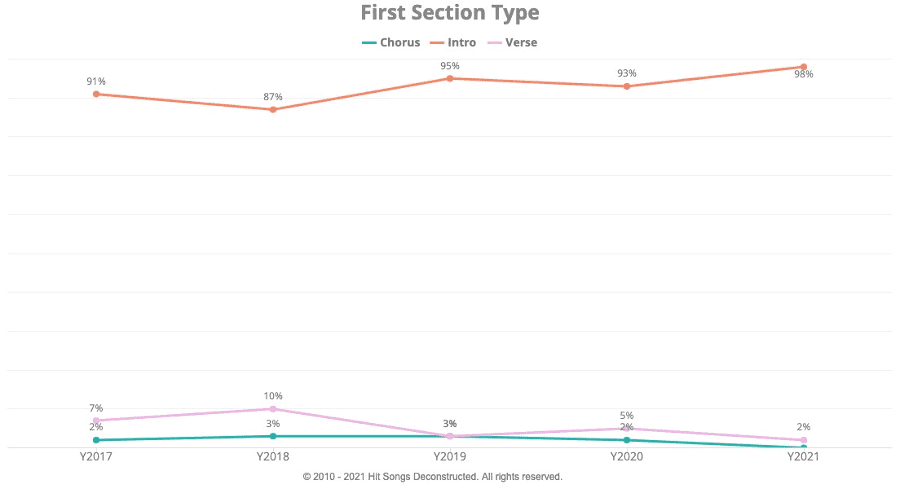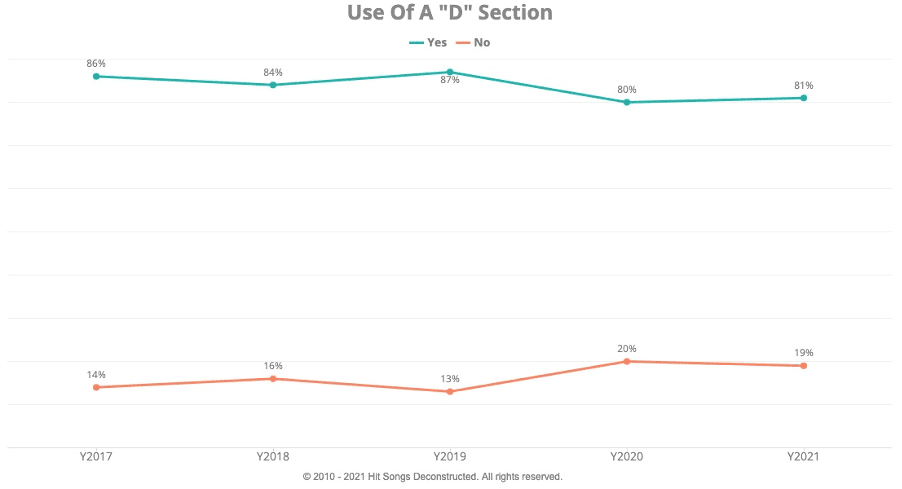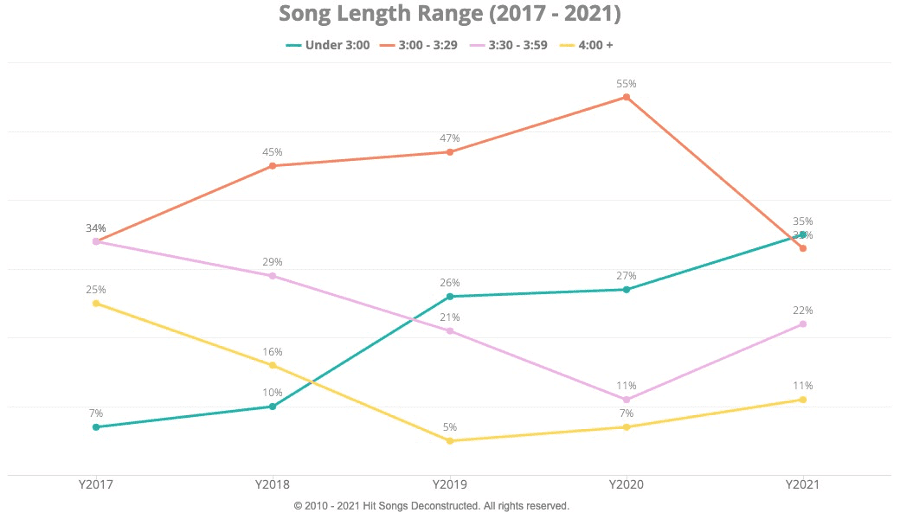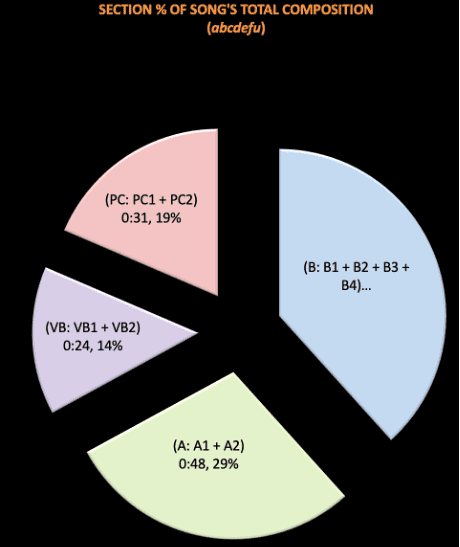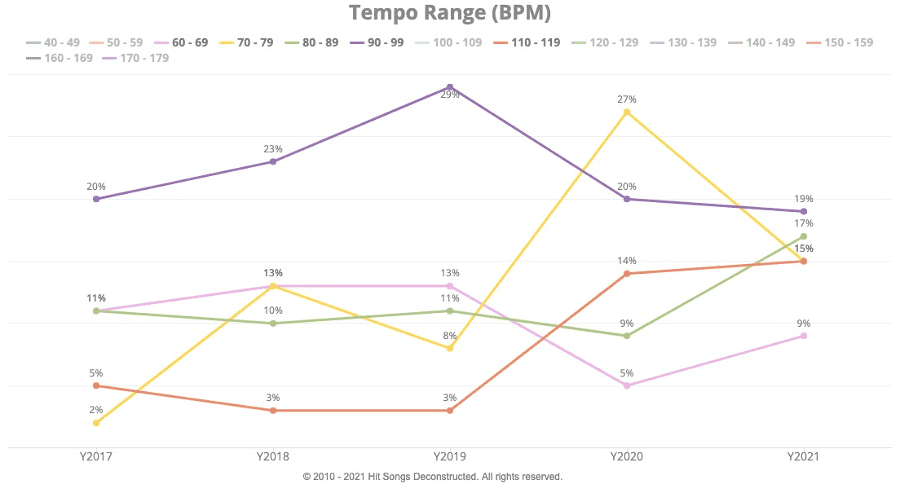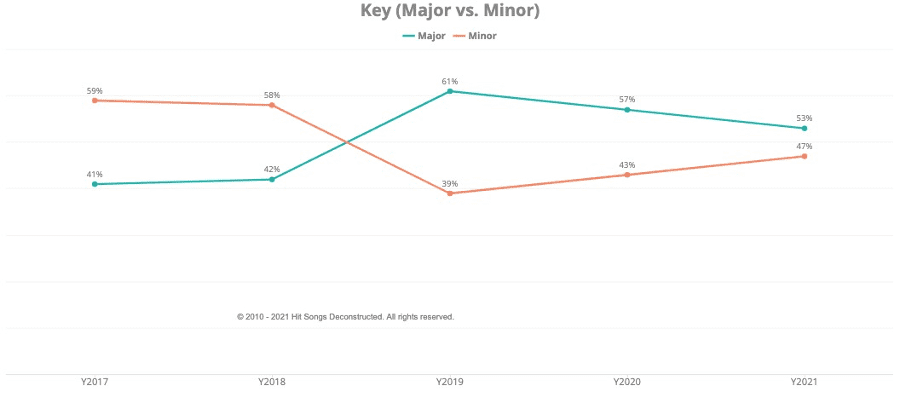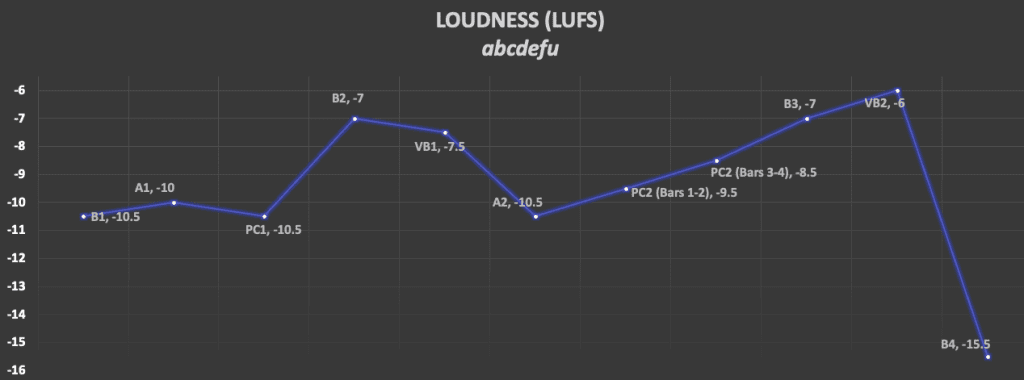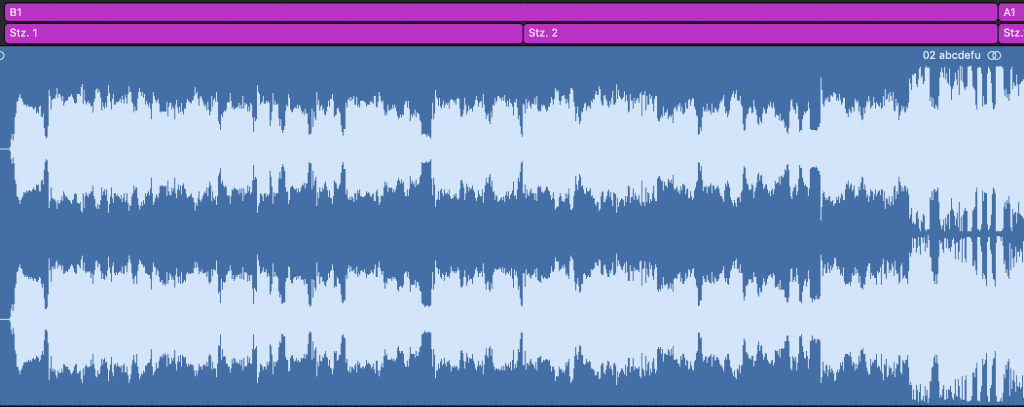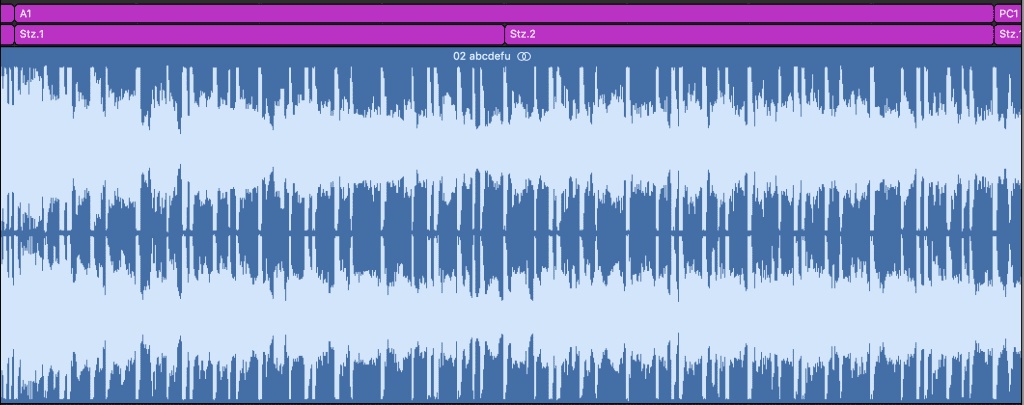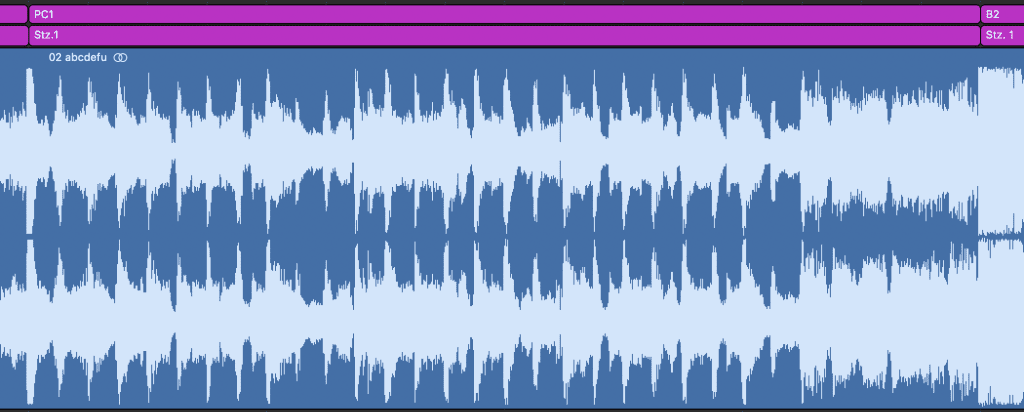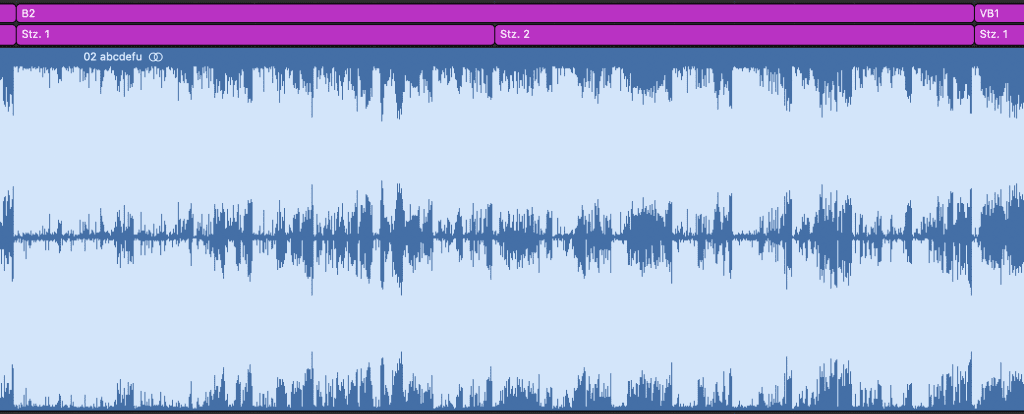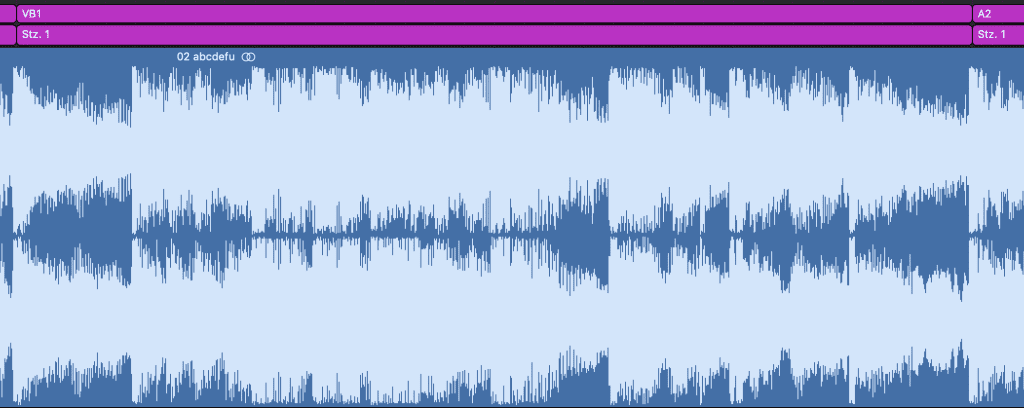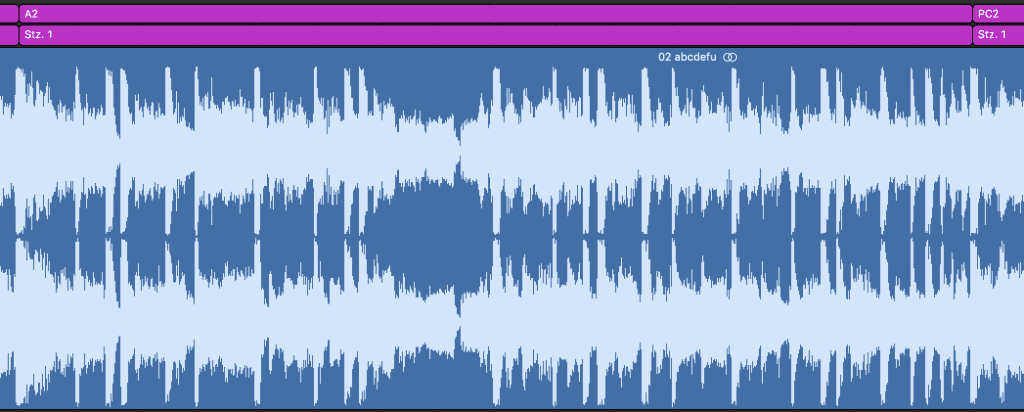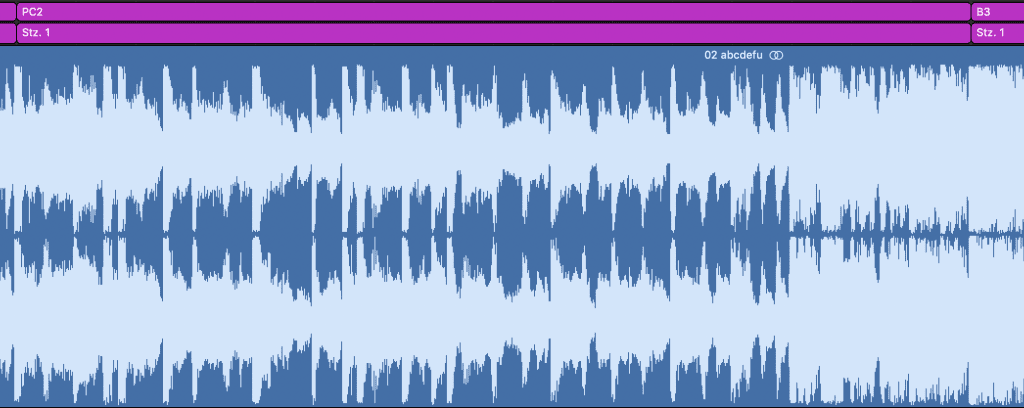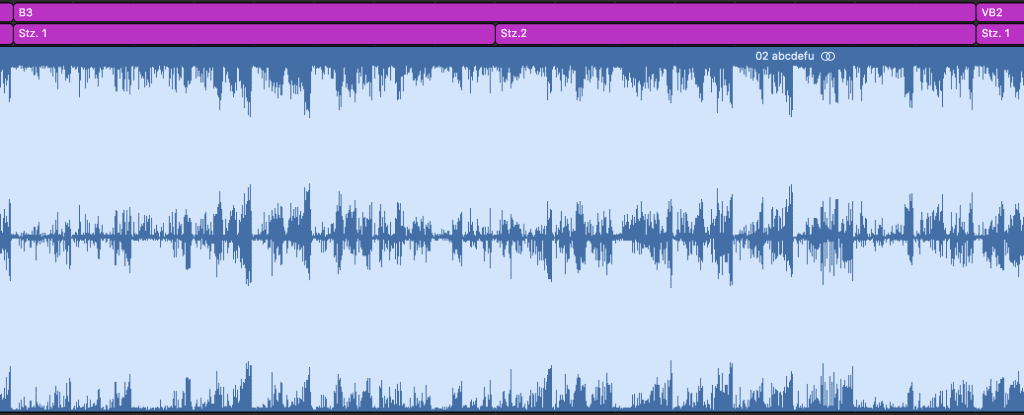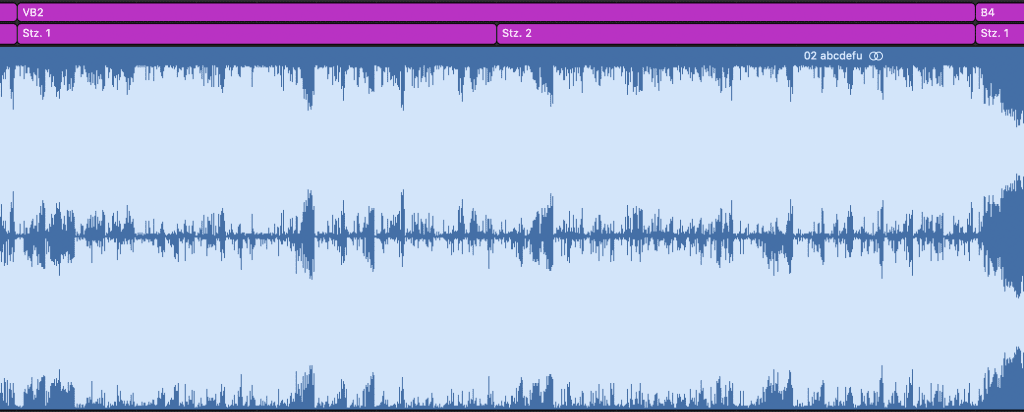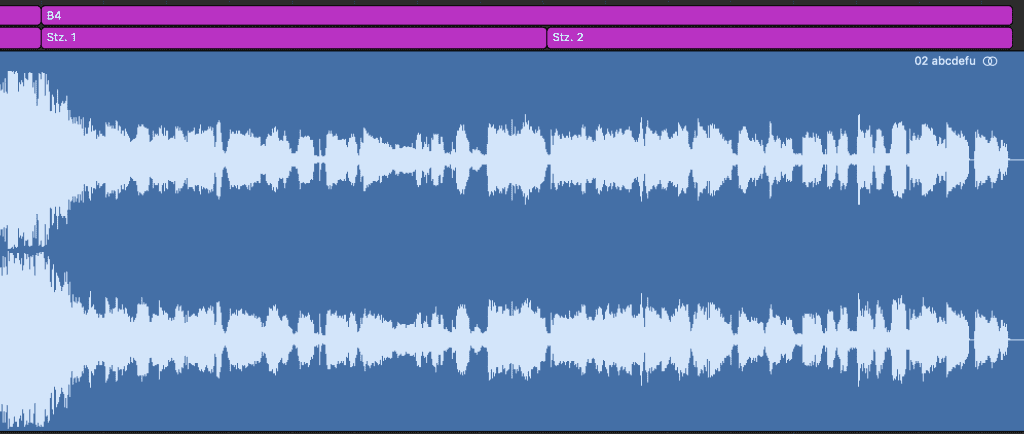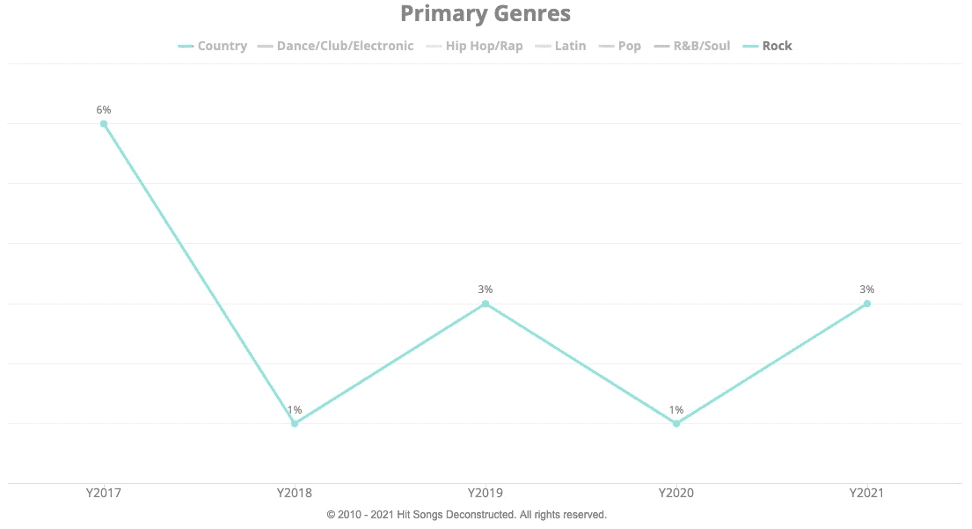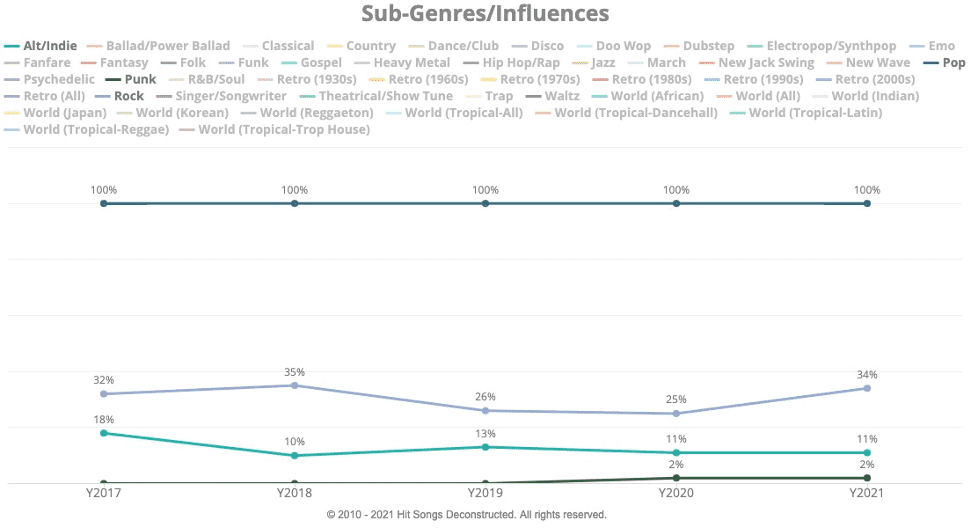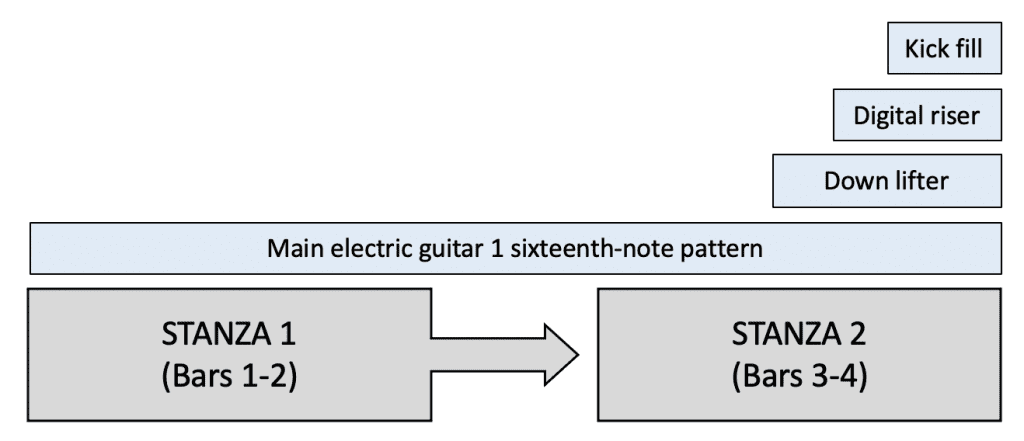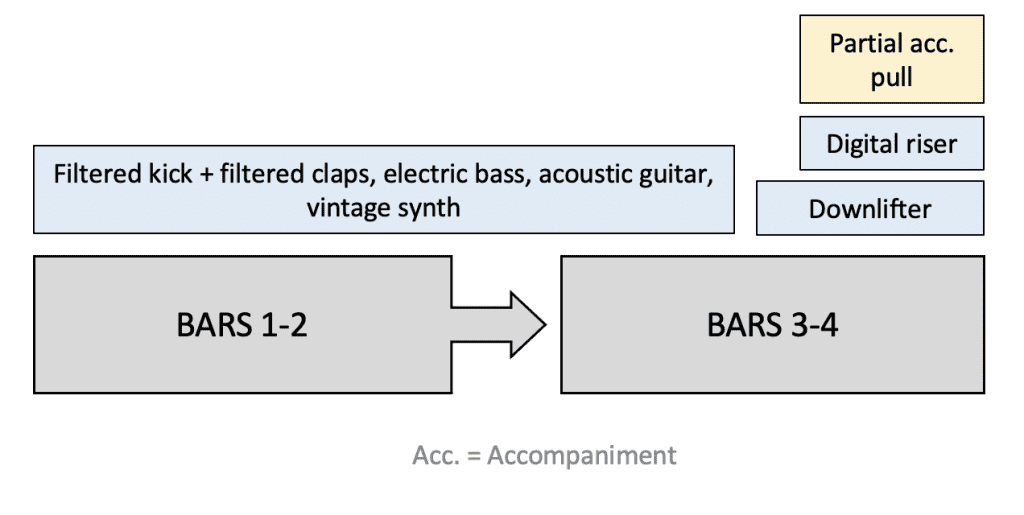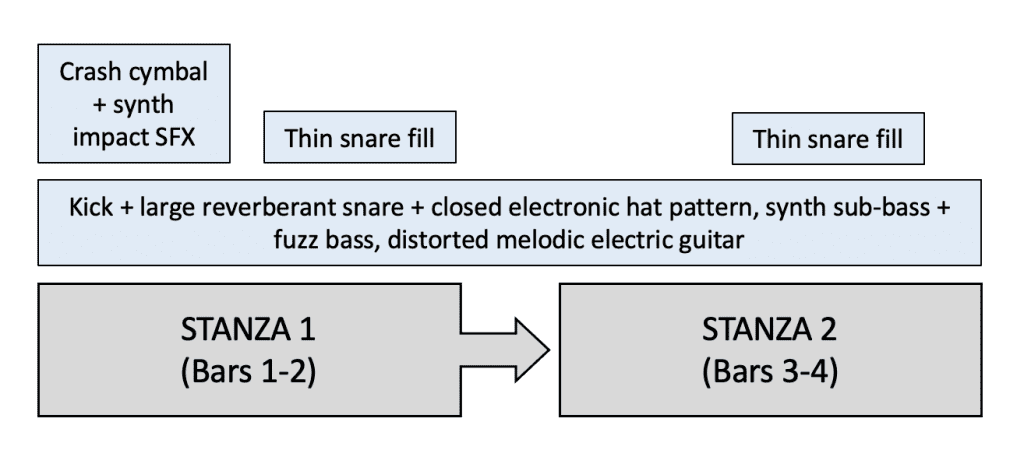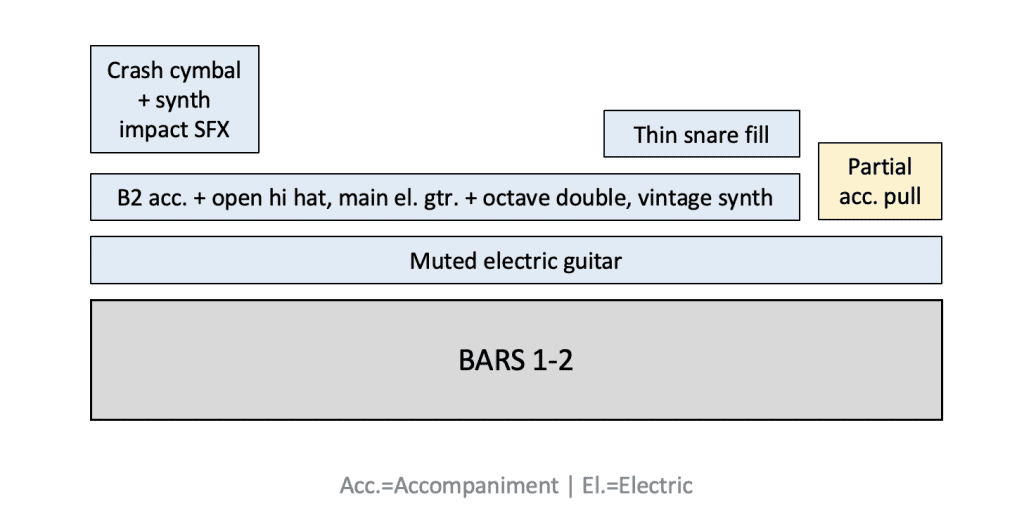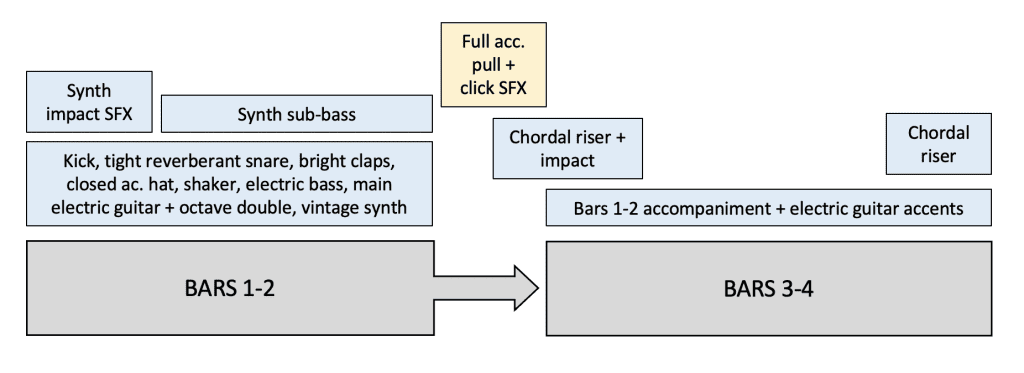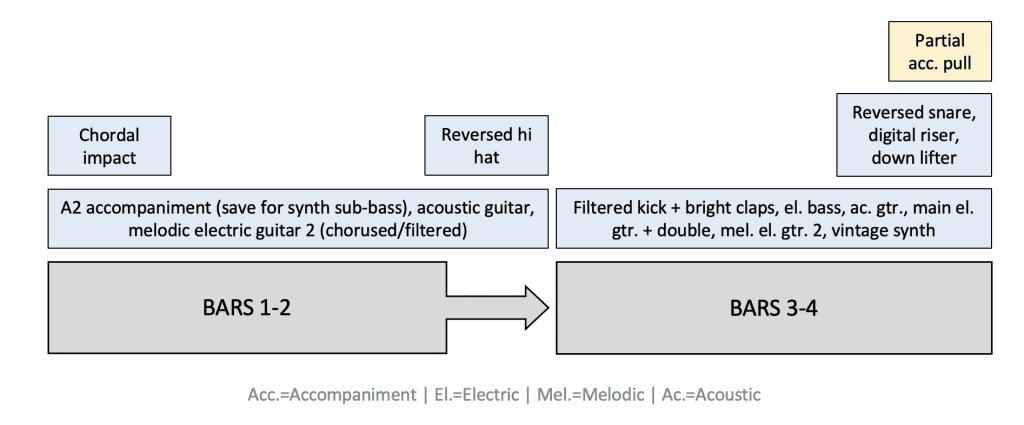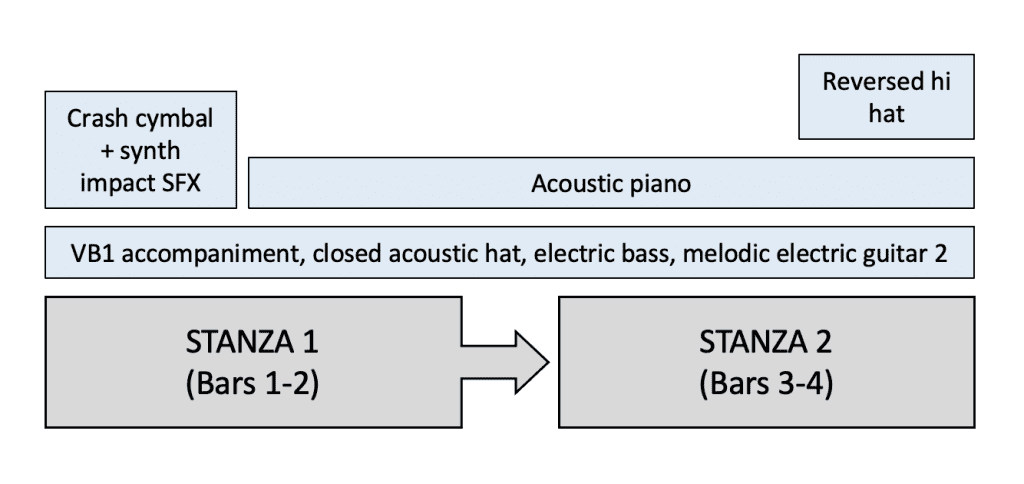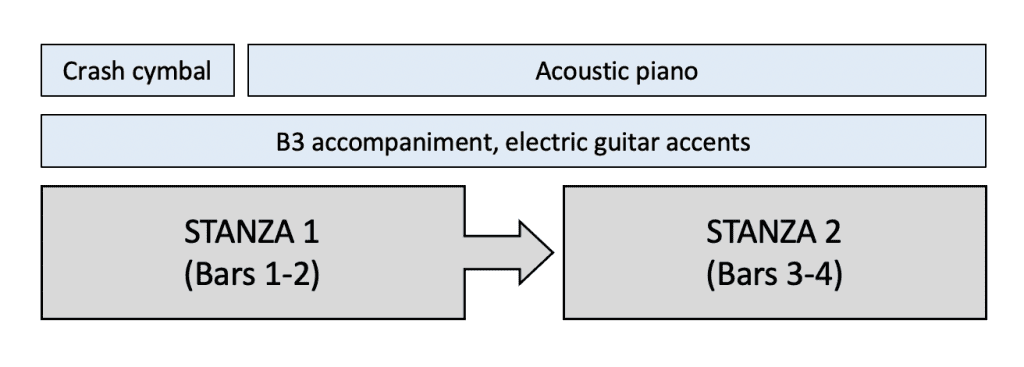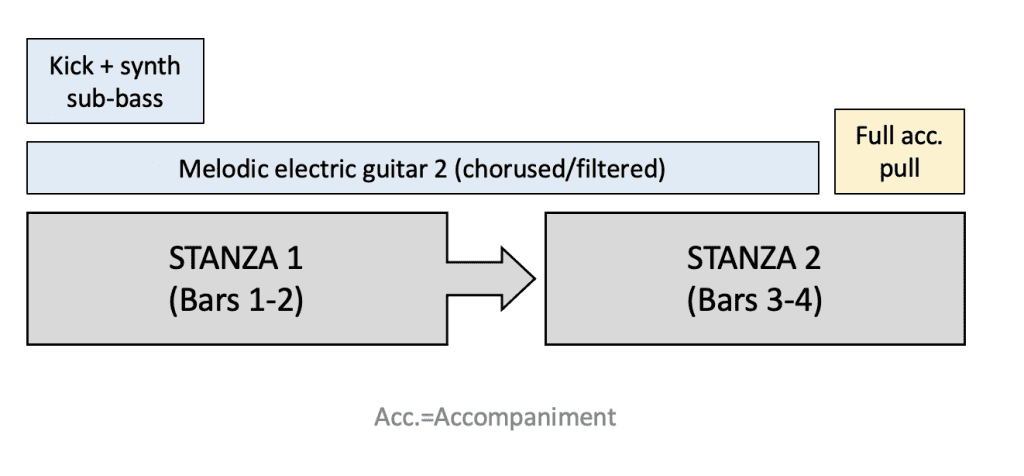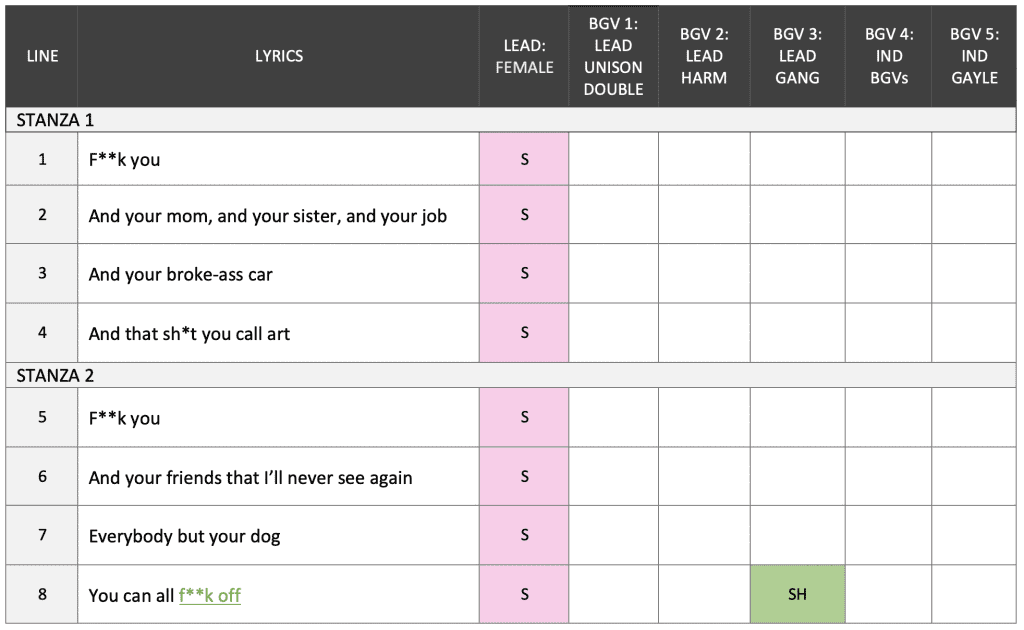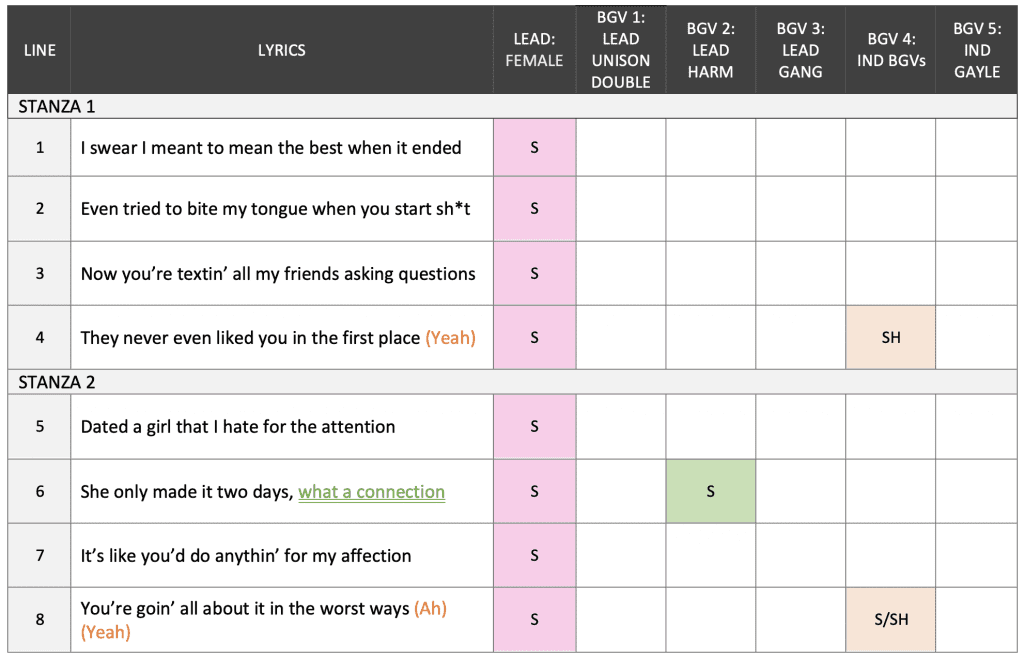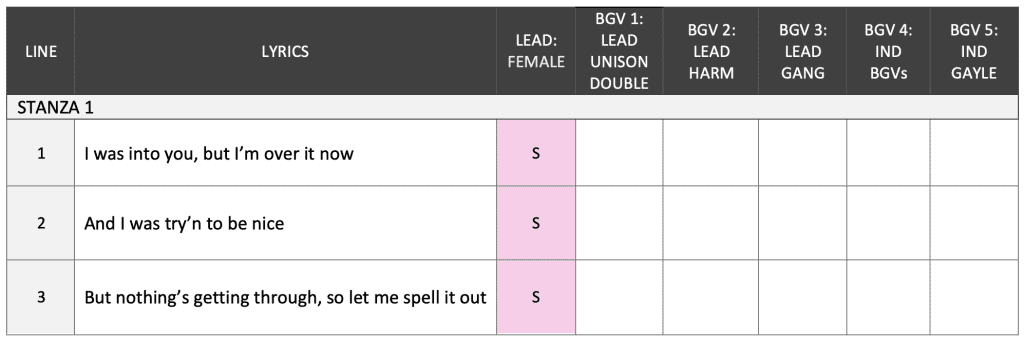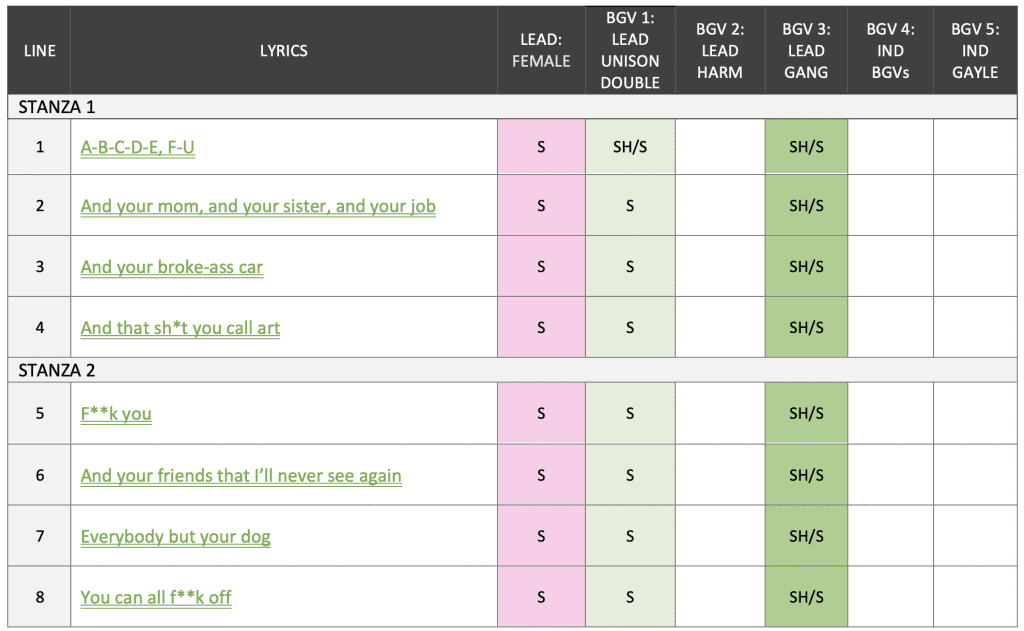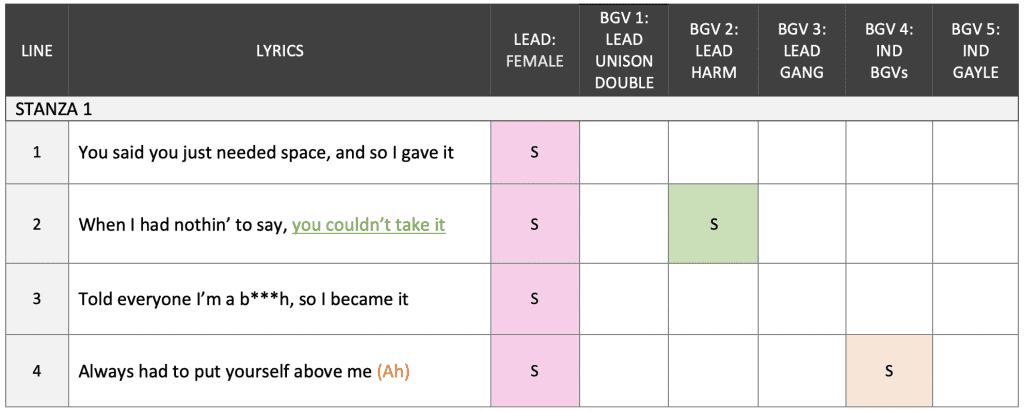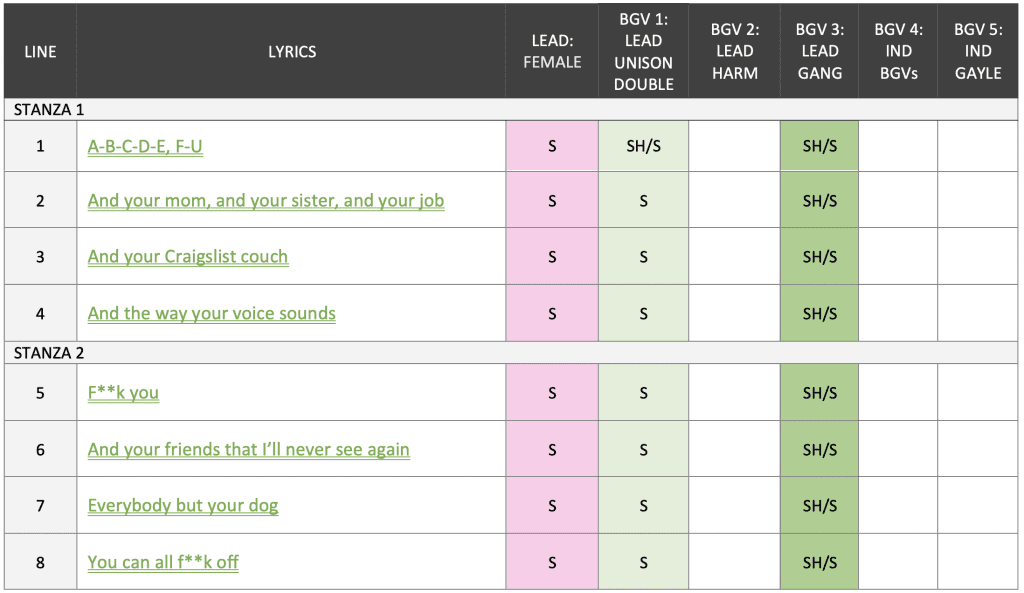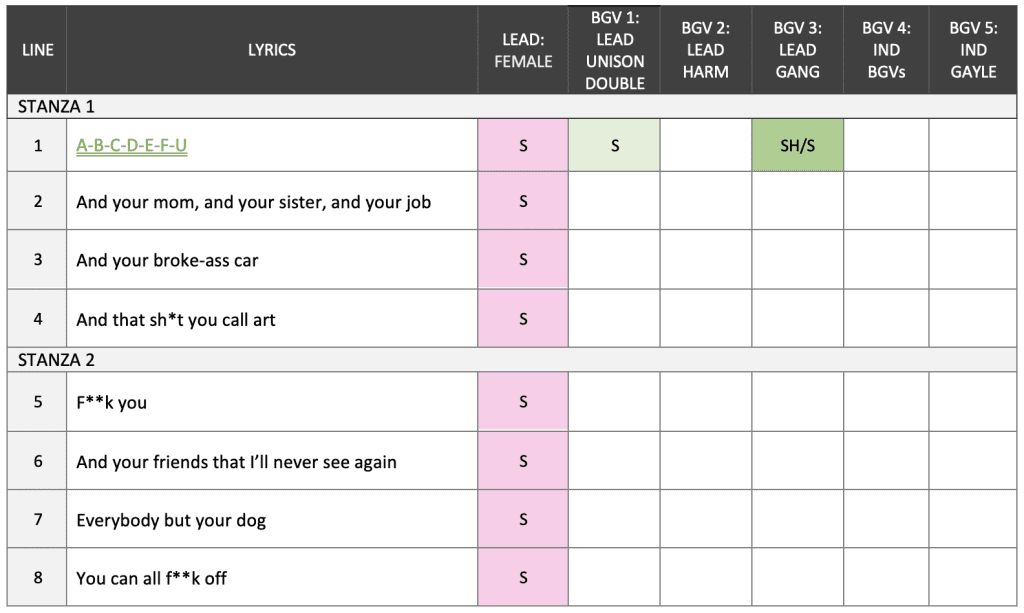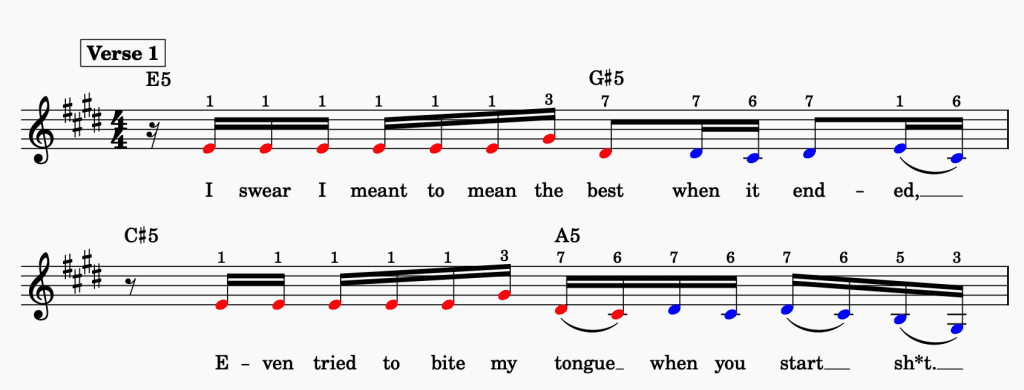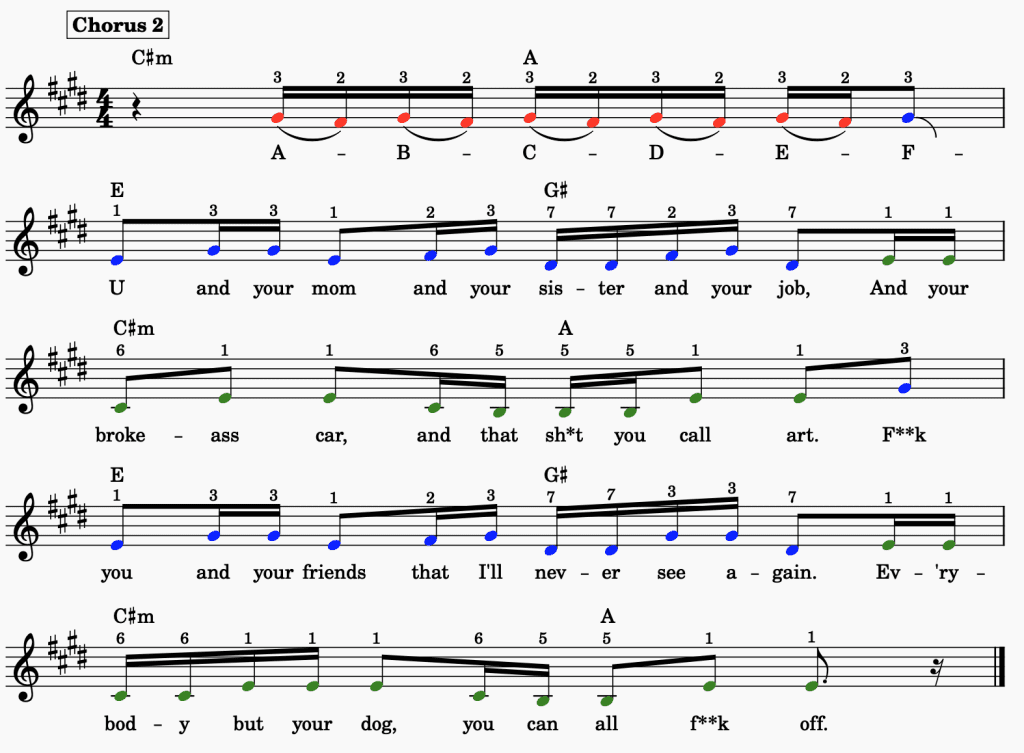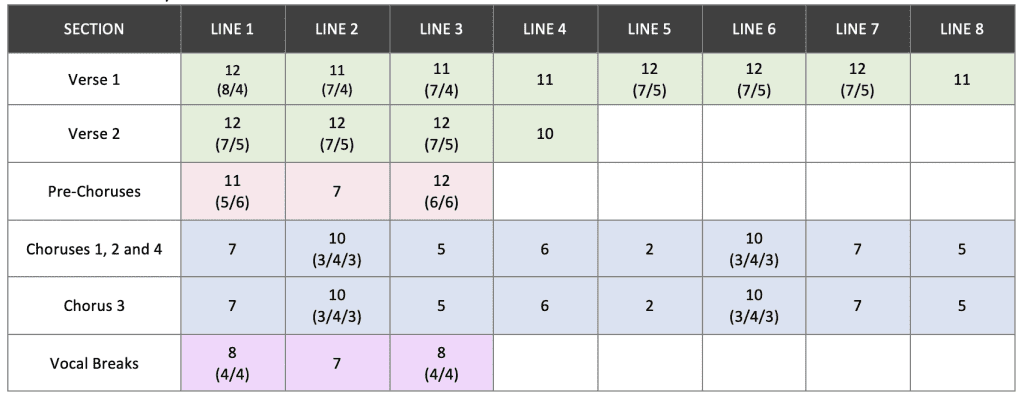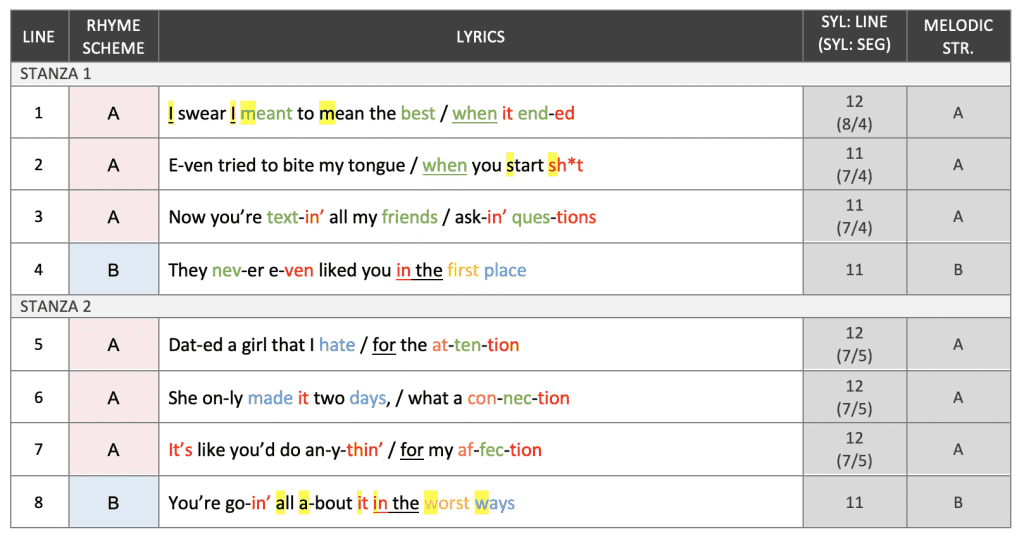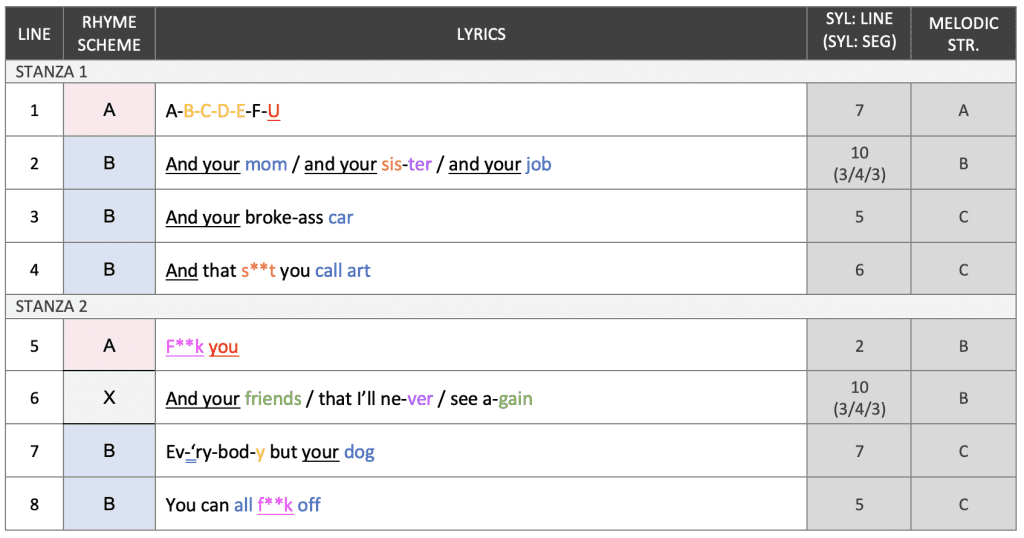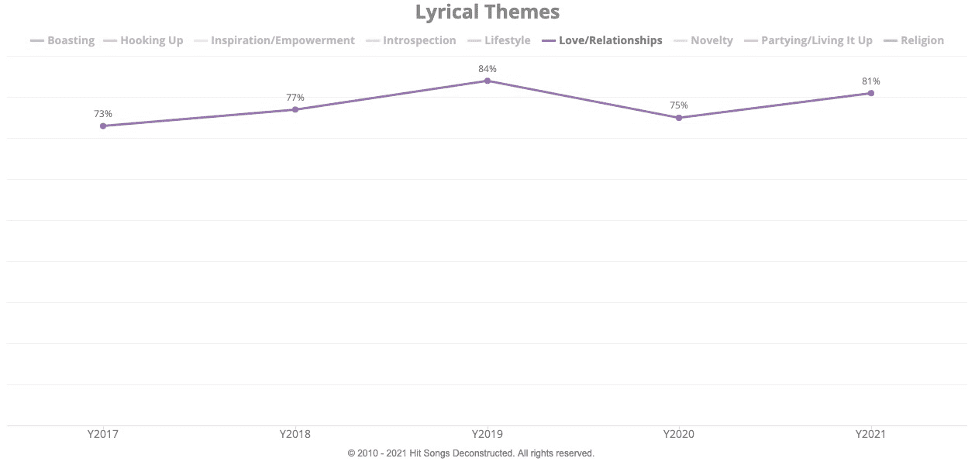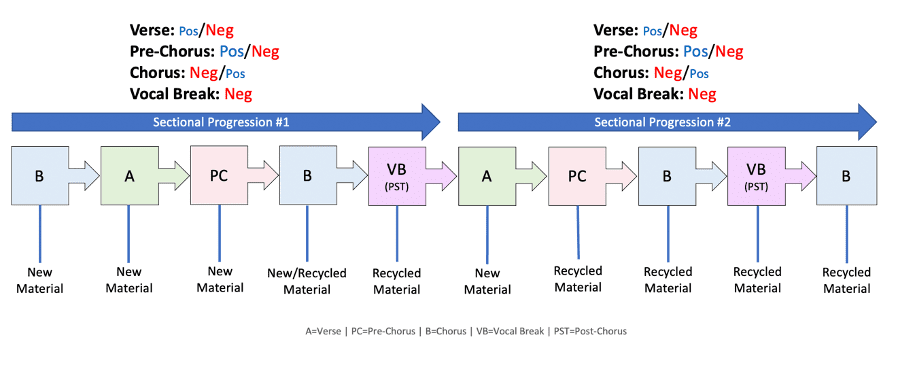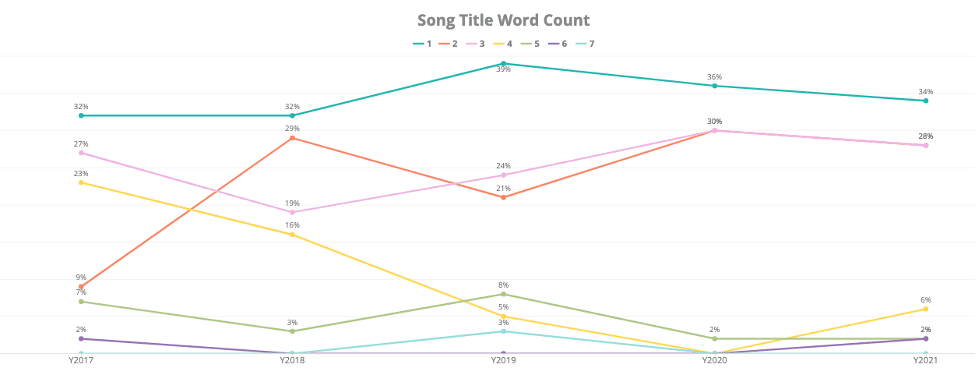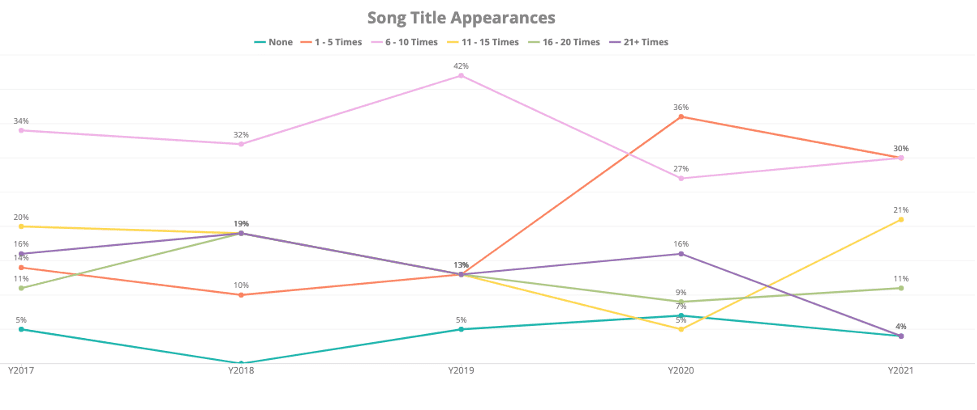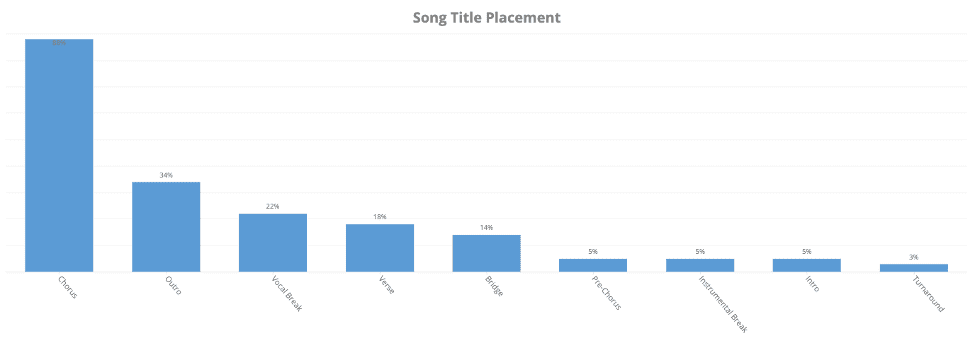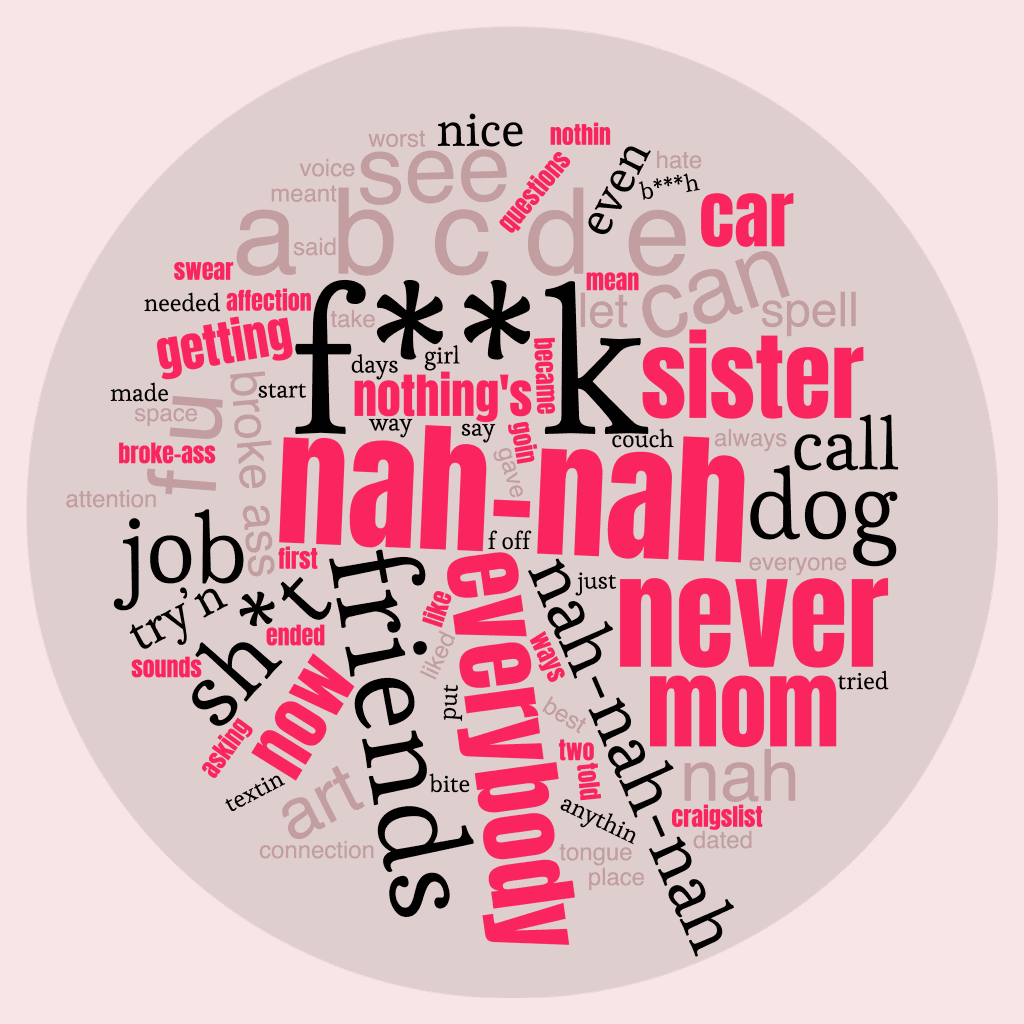

Taylor Swift
Since then, Swift began embracing her pop side once again, both with her Taylor’s Version reissues and the 2022 electropop/synthpop heavy, retro 1980s-tinged album, Midnights. These releases collectively paved the way for the resurgence of "Cruel Summer,” which gained further visibility as the sophomore song in her Eras Tour set list, resulting in increased traction on streaming platforms. With fan interest high, the song was finally, and strategically, released as a single in the summer of 2023 (June), subsequently hitting the top 10 of the Billboard Hot 100 in July.
Written by Swift, Jack Antonoff and St. Vincent, “Cruel Summer” embodies the hallmark qualities of a chart-topping pop hit. Vocally, the song adheres to the K.I.S.S. ME principle (keep it simple, singable and memorable), possesses expert vocal production and features a captivating vocal performance from Swift. Adding to the song’s catchiness are its three distinct vocal hooks: a recurring vocoder-infused "yeah” that is featured at three strategic points in the song, the “down below” song title hook and accompanying nonsense vocal in the chorus, and the shouted vocals in the bridge that struck Olivia Rodrigo to such a degree that she incorporated the bridge’s essence in her 2021 hit, “déjà vu,” resulting in additional writing credits.
Structurally, "Cruel Summer" seamlessly blends contemporary pop trends with discernible deviations that underscore its uniqueness. Notable among these differentiating qualities is the presence of two bridges, a departure from the conventional single bridge format, and its significantly shorter-than-average verses, which helped put the song in line with mainstream music’s gravitation towards shorter runtimes.
The expertly crafted, retro-tinged, synth-heavy instrumental arrangement creates a highly engaging musical backdrop that keeps the listener engaged from start to finish and complements the narrative. Furthermore, the song imparts a sense of familiarity to the listener through its incorporation of electropop/synthpop elements and a nostalgic touch of the retro 1980s within its sonic palette. These musical nuances align with micro trends that played a role in shaping notable Hot 100 Top 10 hits both in 2019 and 2023.
"Cruel Summer" by Taylor Swift stands as a testament to the timeless power of exceptional music. Its journey from initial creation to eventual prominence encapsulates the fusion of strategic timing, musical prowess, and an unswerving connection with a devoted audience.
Since its release, “Cruel Summer” has attained global charting success. In the US, it peaked at #1 in the Billboard Hot 100 and topped the Mainstream Top 40 and Adult Top 40 charts. Abroad, it cracked the top 10 on numerous charts, hitting the top spot in Canada, the Philippines and Singapore.
At-A-Glance
Artist: Taylor Swift
Song: "Cruel Summer"
Songwriters: Jack Antonoff, St. Vincent, Taylor Swift
Producers: Jack Antonoff, Taylor Swift
Mastering Engineer: Randy Merrill
Mixer: Serban Ghenea
Record Label: Republic
Primary Genre: Pop
Influences: Retro (1980s), Electropop/Synthpop
Length: 2:55
Form: I-A-PC-B-T-A-PC-B-C-B-C-O
Key: A Major
Tempo: 85 BPM
First Chorus: 0:28 / 16% of the way into the song
Intro Length: 0:05
Electronic vs. Acoustic Instrumentation: Primarily Electronic
Prominent Instruments: Bass (Synth), Drums/Percussion (Primarily Electronic), Synth (Non-Bass)
Primary Lyrical Theme: Love/Relationships
Title Appearances: "Cruel Summer" appears six times in the song
Overview, Highlights & Takeaways
Hooks
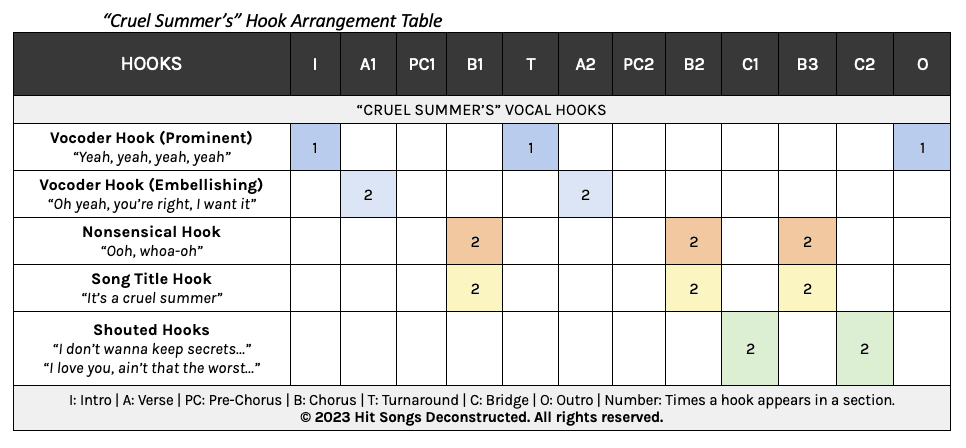

Vocoder Hooks
The intro, outro and turnaround feature a simple, monotone, quarter-note-driven vocoder-processed “yeah” hook that serves a multitude of purposes:
- It functions as a unique, instantly recognizable calling card for the song.
- It hooks the listener in on a profound level in the intro.
- It “resets” the song and provides and engaging transition into verse 2 following the first intro – verse – pre-chorus – chorus progression.
- It concludes the song on a familiar and catchy note in the outro.
In addition, both verse sections feature catchy, vocoder-processed background vocal “nano” hooks that create a catchy call and response flow with Swift’s lead. Their inclusion also has a lyrical implication, as they cleverly voice Swift’s internal conflicted desire for her love interest.
Paired Hooks: Nonsensical Hook and Song Title Hook
Each stanza of the chorus concludes with the “ooh, woah-oh” nonsense hook followed by the “it’s a cruel summer” summative song title hook. Both feature the same melismatic melody, which serves heighten their memorability while showcasing Swift’s vocal chops. In addition, the melismatic quality of the nonsense hook cleverly communicates the emotion Swift feels without the need to outright state it (i.e., a “show don’t tell” approach).


Shouted Hooks
The bridge uniquely features two standout shouted vocal hooks that are primely placed at the end each stanza: “I don’t wanna keep secrets just to keep you,” and the even more emotionally riveting, “I love you ain’t that the worst thing you ever heard.” The directness of the melody along with the sung/shouted hybrid delivery bolsters each statement’s impact while creating unique standout moments in the scope of the song.
Furthermore, a testament to the bridge’s overall strength is its interpolation in Olivia Rodrigo’s hit, “déjà vu,” which resulted in Swift, Antonoff and St. Vincent all getting writing credits.


Structure: Overview


Genres & Influences: Overview
"Cruel Summer" features a combination of pop, electropop/synthpop and retro 1980s influences that are put into effect by the qualities of the vocals, instruments, lyrics, and the overall production.
Key
X: The influence appears prominently within the stanza and/or section
x: The influence appears


Instrumentation & Arrangement: Overview
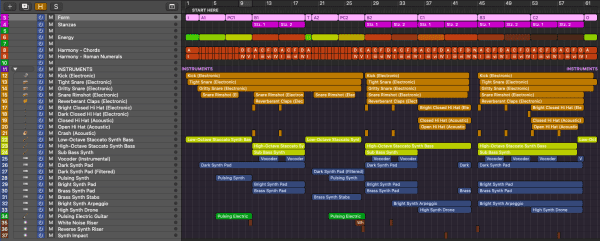

Energy: Overview
S.I.A. (Section Impact Accentuator) Key
Downward Red S.I.A.: The full accompaniment is removed from the mix, resulting in a brief reduction in energy
Downward Yellow S.I.A.: A part of the accompaniment is removed from the mix, resulting in a brief reduction in energy
Upward Green S.I.A.: The accompaniment creates a brief rise in energy


Harmony: Overview
“Cruel Summer” features three core progressions, each with subtle variations.
Progression 1
Progression 1: Variation 1 (Intro)
A
Progression 2
Progression 2: Variation 1 (Verses)
D – E – C#m – F#m
Progression 2: Variation 2 (Pre-Choruses)
D – E – C#m – F#m – D – E
Progression 3
Progression 3: Variation 1 (Choruses)
A – C#m – F#m – D
Progression 3: Variation 2 (Bridges)
A – C#m7 – F#m7 – D – A – C#m7 – F#m7 – D – N.C.
Vocal Production: Overview
Lead Vocal Gender
“Cruel Summer” features a solo female lead vocal from Taylor Swift. In the first half of 2023, solo male leads were by far most common among non-hip hop hits at half of all songs, followed distantly by solo female leads at just 17%.
Lead Vocal Gender in the Hot 100 Top 10 (Non-Hip Hop Hits): 2018 – Q2 2023
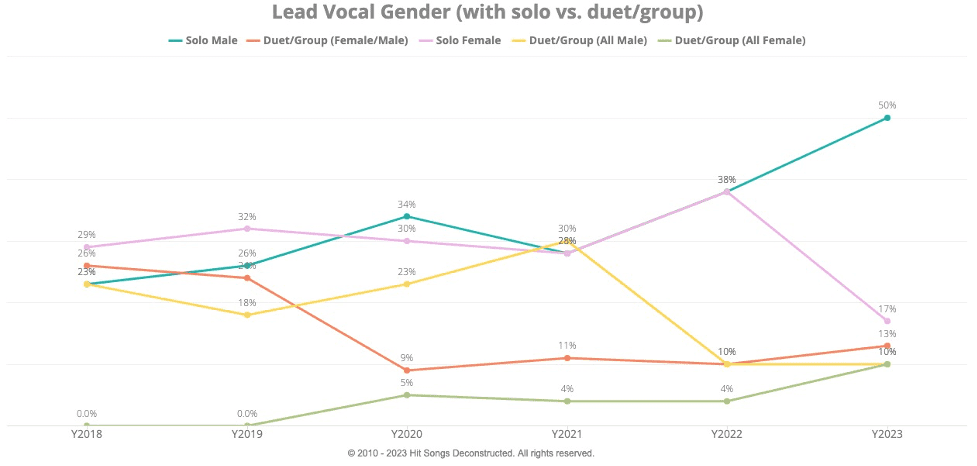

Lead Vocal Delivery
“Cruel Summer” features an almost entirely sung vocal delivery, save for a few sung/shouted hybrid deliveries in the bridge sections. Despite exclusively sung deliveries continuing to be by far most common among non-hip hop hits, they have been in decline since 2020 while sung/rapped combo deliveries have been on the rise.
Lead Vocal Delivery in the Hot 100 Top 10 (Non-Hip Hop Hits): 2018 – Q2 2023
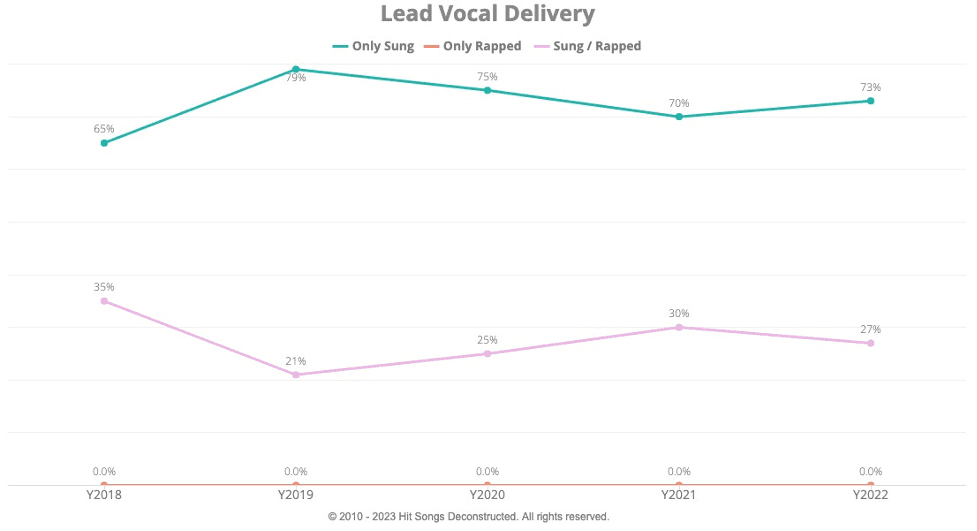

Background Vocals
Complementing Swift’s lead are an array of background vocals including unison doubles, octave doubles, above and below the lead harmonies, independent of the lead adlibs, and sustained vocal pads. Together, they serve to heighten interest throughout the song and call attention to key lyrics.
Effects & Processing
“Cruel Summer” features common hit song vocal processing, including reverb, compression, and subtle autotune to heighten the effectiveness of the vocal performance. In addition, a vocoder is used in both a lead and background capacity to provide vocal texture variation and create one of the song’s notable hooks.
Vocal Production Visualization Key
Lead: Female (Taylor Swift): Taylor Swift’s lead vocal
BGV 1: Female (Unison Double): Background vocal doubles in unison with the lead
BGV 2: Female (High Octave Double): Background vocal doubles an octave above the lead
BGV 3: Female (Low Octave Double): Background vocal doubles an octave below the lead
BGV 4: Female (Lead Harmony) (Above): Background vocals that harmonize with the lead on different pitches above the melody
BGV 5: Female (Lead Harmony) (Below): Background vocals that harmonize with the lead on different pitches below the melody
BGV 6: Female (Adlibs): Background vocals featured independently from the lead
BGV 7: Female (BGV Pad): Multiple background vocals stacked and sustained to create a pad-like effect
Vocoder: Vocoder vocal hook independent from all vocals, functions in a background and lead capacity
S: Sung
SH: Shouted
BGV: Background vocals
Vocal Delivery Arrangement Overview
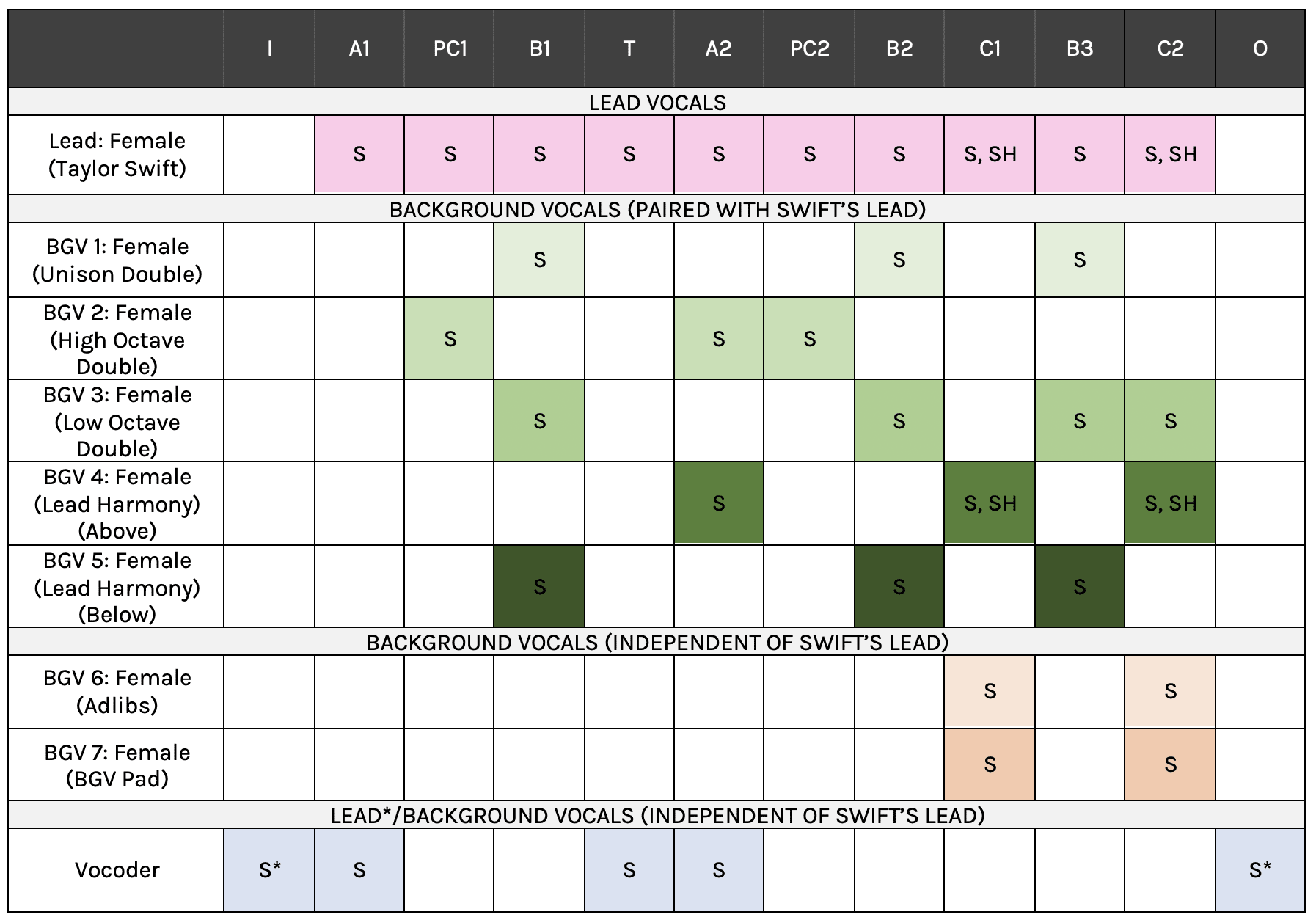

Vocal Melody: Overview


Sectional Melodic Part Structure: At-A-Glance
INTRO & OUTRO


VERSE 1


VERSE 2


PRE-CHORUSES


CHORUSES
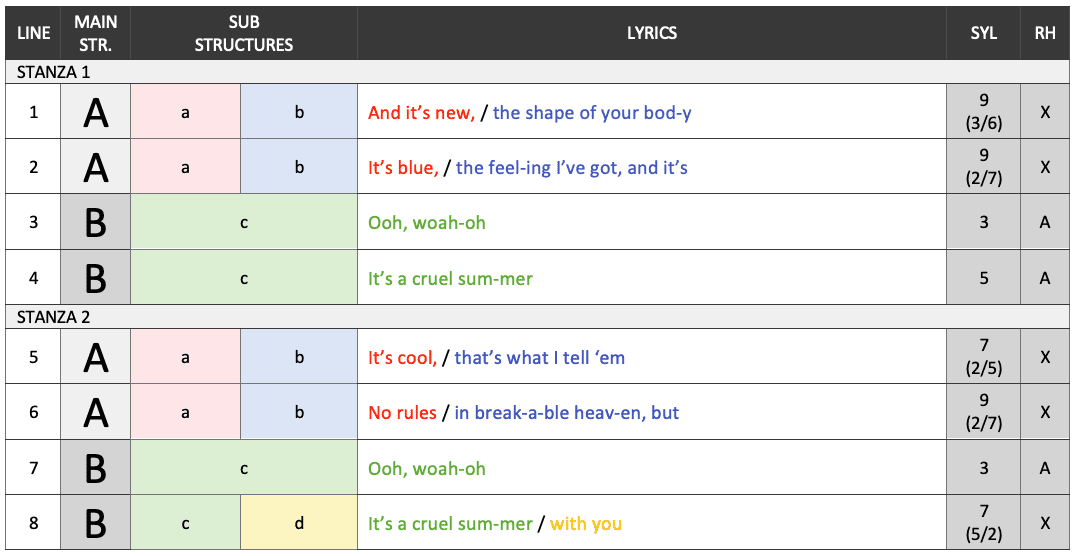

BRIDGES
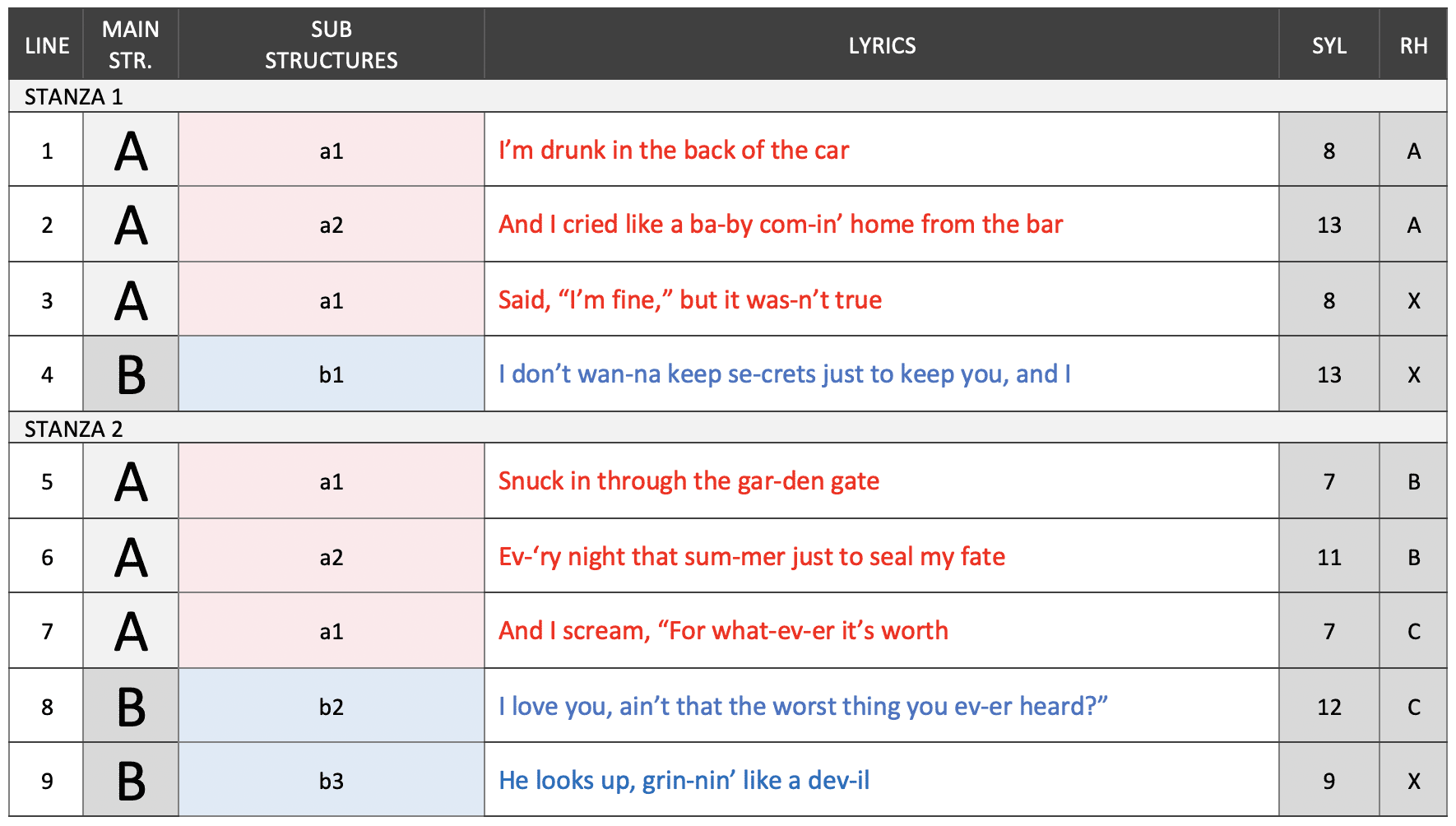

Sectional Melodic Pattern: At-A-Glance
INTRO & OUTRO


VERSE 1


VERSE 2


PRE-CHORUSES


CHORUSES


BRIDGES


Rhymes: Overview
“Cruel Summer” features an abundance of expertly crafted rhymes and other lyrical connection accentuators that bolsters the song’s ability to connect and resonate. Among them are logically unfolding end-of-line rhyme schemes and a plethora of strategically placed internal rhymes, double rhymes, alliterations, lyrical repetitions, cross-section commonalities and unique pronunciations to make rhymes happen where they otherwise wouldn’t.
Key
A, B & C: End-of-line rhymes
X: Non-rhymes
Lyric/Syllable: The primary rhyme at the end of each line
Underline: Repetitive lyrics
Colors and rhyme schemes are unique to each section
*For simplicity of analysis, note that only lyrics connected by both rhyme and another notable characteristic (i.e., proximity, placement, melodic connection, etc.) are shown in each table. Lyrics that rhyme but are otherwise unconnected are not noted.
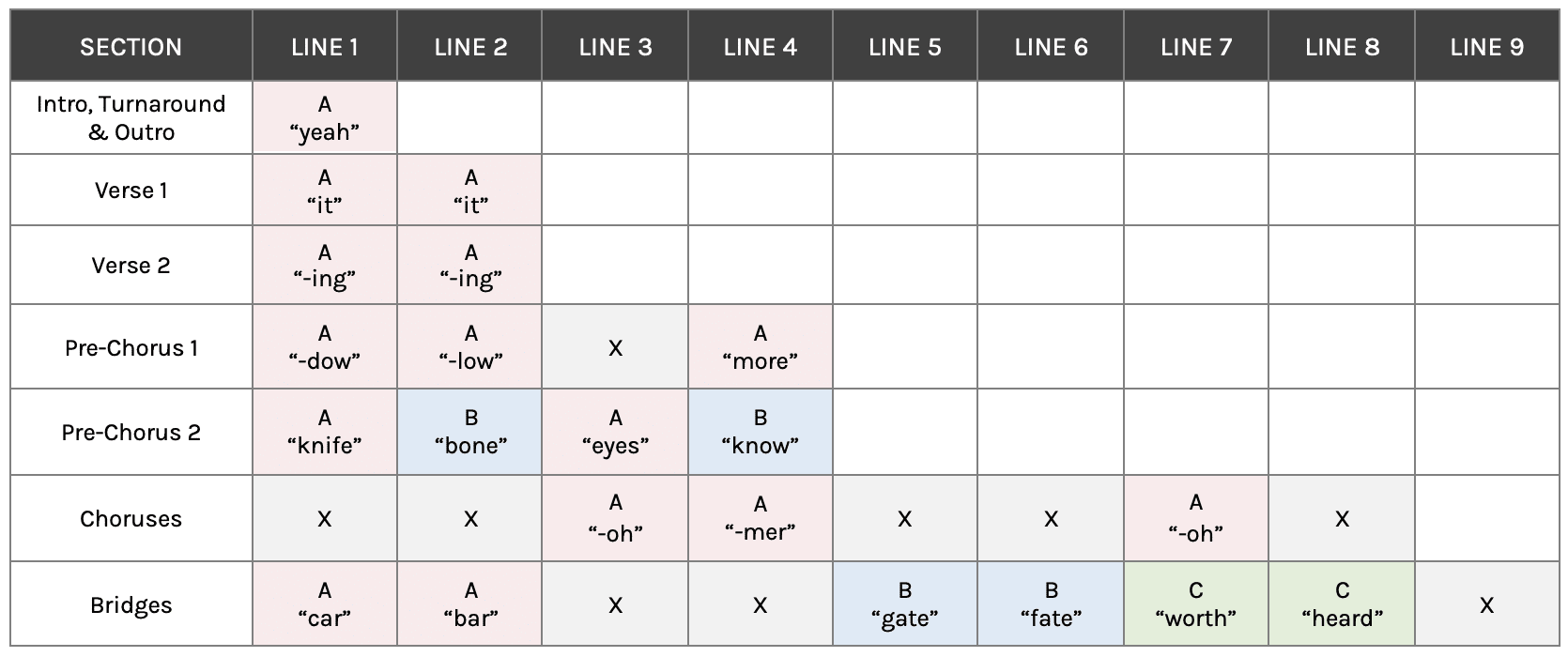

Narrative: Overview
“Cruel Summer” is a love/relationships-themed song about a protagonist (Taylor Swift) and her intense desire for a bad boy love interest that she knows will likely not end well. The song makes great use of the A.I.D.E. principle (action, imagery, detail devices, emotion) to convey the story in a compelling manner, while the abundance of clever, metaphorical lyricism engages the listener on a deep level. However, the listener is always able to grasp what it’s all about, which is a testament to Swift’s masterful lyric-writing skills.
In addition, the lyricism and overarching story creates intrigue as to which boyfriend Taylor Swift is singing about and also cleverly relates to other songs within her body of work. An example is the standout lyric, “devils roll the dice, angels roll their eyes,” which appears on a board game in Swift’s “Lover” music video. While this reference will likely go unnoticed by the casual listener, for diehard Swift fans it’s an easter egg of a find.
INTRO & OUTRO


VERSE 1




PRE-CHORUS 1




CHORUS
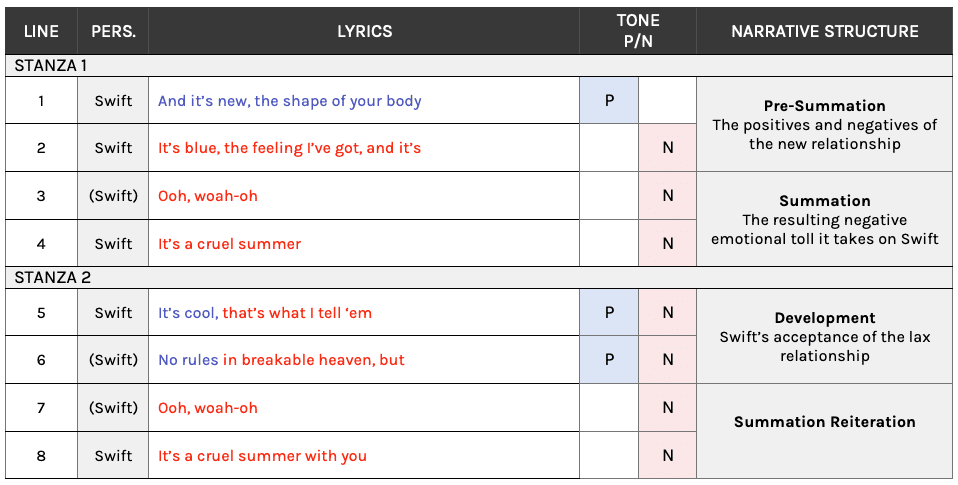

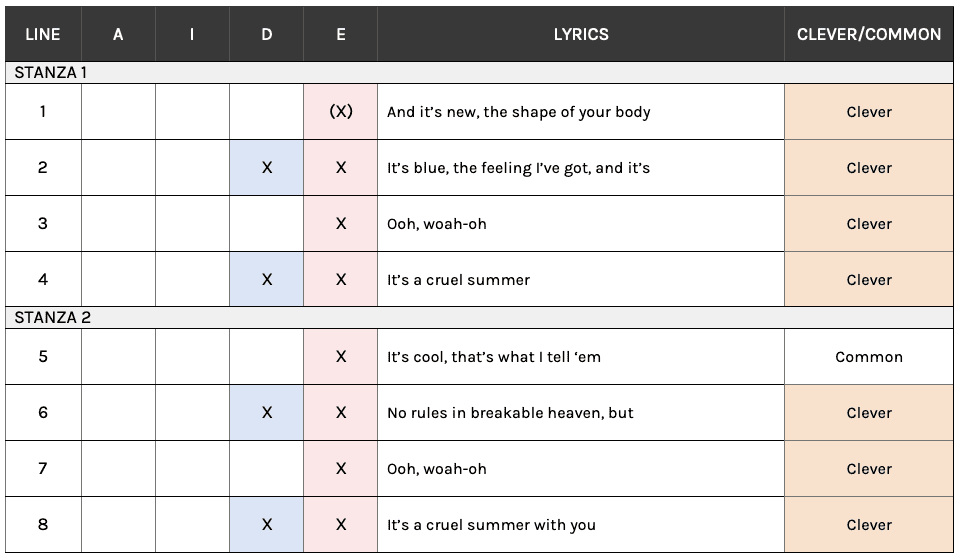

VERSE 2




PRE-CHORUS 2




BRIDGE 1
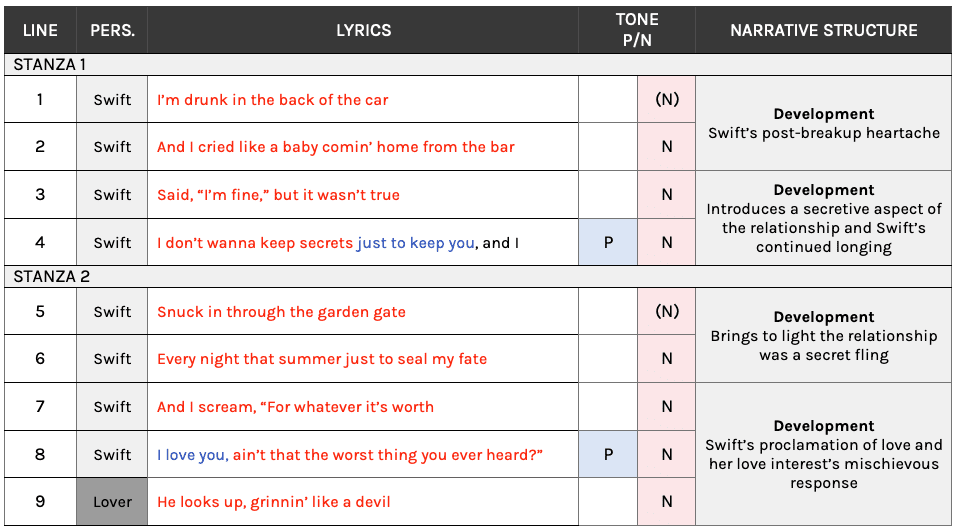

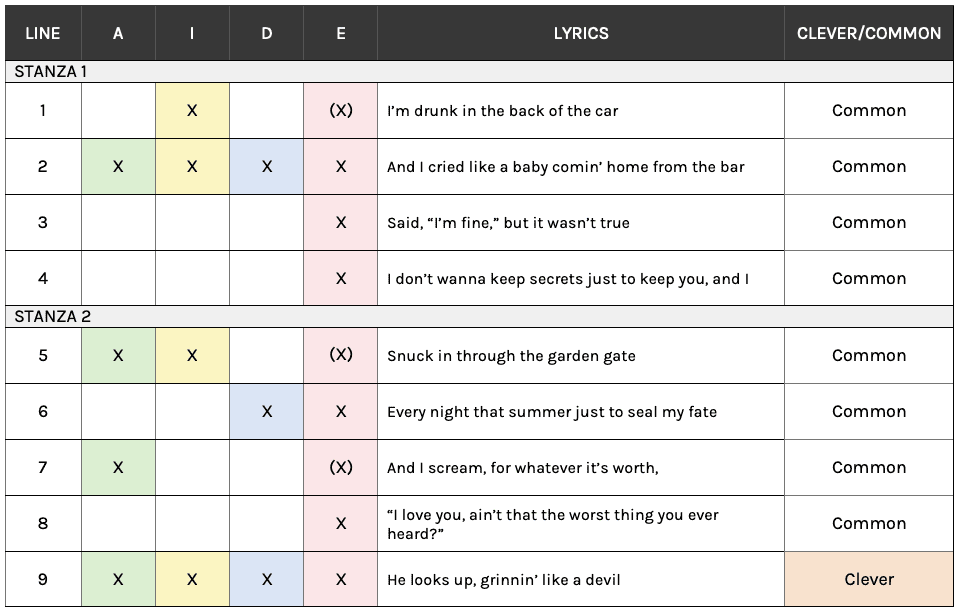

Song Structure
Overview
“Die With A Smile” strikes a meticulous balance between structural familiarity and creative divergence. On the conventional side, it features an easy-to-follow form with two verses, three choruses, a short, engaging intro, and a definitive outro—elements commonly found in non-hip hop Hot 100 top 10 hits.
Where it diverges is just as meaningful: its 6/8 meter, extended 4:02 runtime, and the inclusion of three consecutive “D” (departure) sections—one of which is an atypical instrumental break—set it apart. It also allocates noticeably less time to its verses and more to its choruses, further shifting the structural emphasis. Each of these choices is intentional, reinforcing the song’s emotional and musical goals.
Ultimately, this balance of the familiar and the unexpected allows “Die With A Smile” to feel both instantly accessible and refreshingly distinct among its mainstream peers.
Song Sections
“Die With A Smile” contains 12 sections within its framework:
- One intro section
- Two verse sections
- Two pre-chorus sections
- Three chorus sections
- One instrumental break section
- One vocal break section
- One turnaround section
- One outro section
Song Section Classifications
“D” (Departure) Section Classification
“Die With A Smile” features three back-to-back “bridge surrogate” “D” (departure) sections within its framework:
- Departure #1 (Vocal Break): The first “D” section is a one-off 8-bar vocal break following chorus 2, appearing at 64% of the way into the song, which is right where one would expect to find it (“D” sections commonly occur around two-thirds and three-quarters of the way in). Providing the departure relative to the sections that precede and follow are its lower-energy breakdown arrangement and unique, engaging 3x repetition of the pivotal lyric, “right next to you,” between Mars, Gaga, and a concluding harmonizing duet. While the structural and arrangement qualities provide an engaging departure, the repetition of the chorus lyric further enhances familiarity and memorability while bolstering the song’s emotional resonance.
- Departure #2 (Instrumental Break): Directly following the vocal break is a one-off 8-bar instrumental break, appearing at 71% of the way into the song. It provides an engaging contrast against the vocal break with its dense and energetic accompaniment, as well as the guitar solo focus, which is unique in the scope of the song.
- Departure #3 (Chorus 3): Following the sonically intense instrumental break, the third chorus uniquely begins with a breakdown arrangement, consisting mainly of acoustic piano and electric guitar supporting Gaga’s lead vocals. This provides an engaging variation on the familiar chorus that both heightens listener engagement and sets in motion the build to the song’s grand sonic and emotional climax that comes at the end of the section.
While most non-hip hop Hot 100 top 10 hits continue to include a “D” section in their framework, it’s use has recently been in decline. In the first half of 2024, only 68% of songs contained a “D” section, compared to 70% in 2023, and 85% in 2022.
In terms of the types of “D” sections used in recent hits, the bridge continues to be by far most common, while other section “bridge surrogates” are far less so. The inclusion of a diversified chorus, instrumental break, and vocal break “D” section were included in only 5%, 3%, and 0% of songs in the first half of 2024, respectively.
Use of a “D” Section in Non-Hip Hop Hot 100 Top 10 Hits: 2020 – Q2 2024
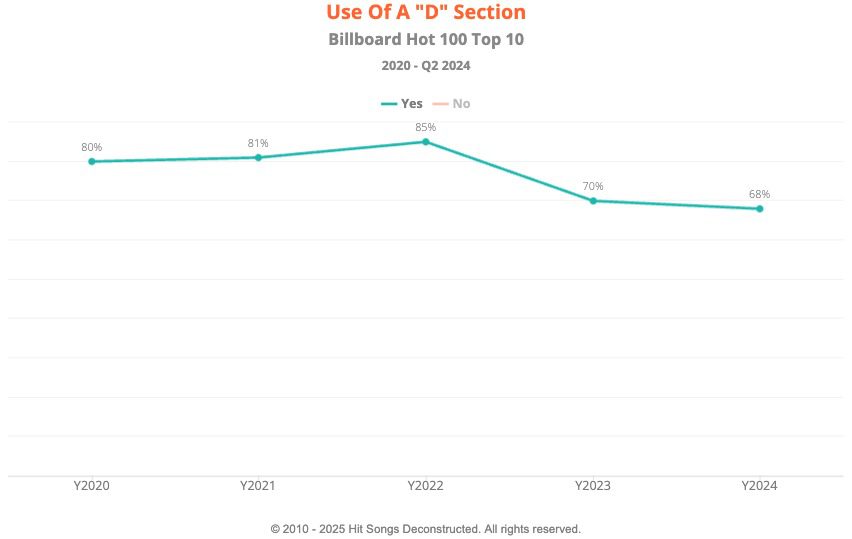

Use of Instrumental Break and Vocal Break Bridge Surrogate “D” Sections in Non-Hip Hop Hot 100 Top 10 Hits: 2020 – Q2 2024
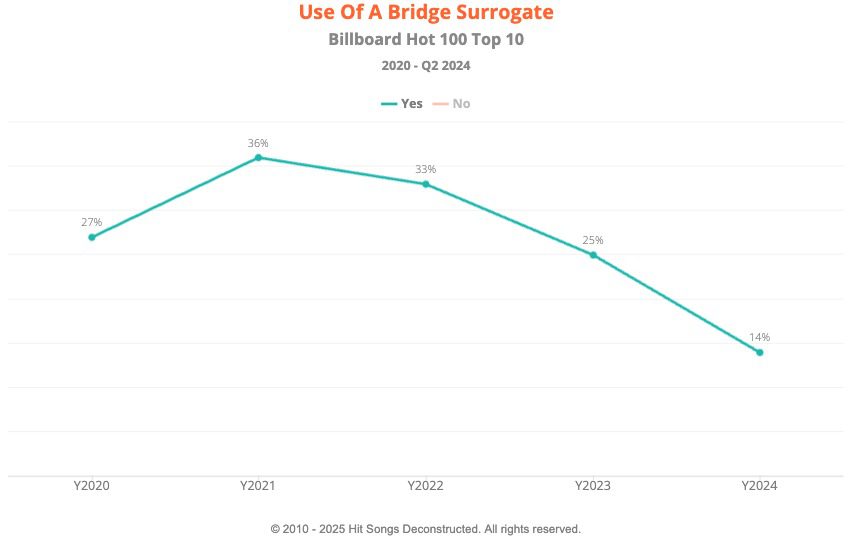

Post-Chorus Section Classification
“Die With A Smile contains three post-chorus “hook centers” in its framework:
- Post-Chorus #1 (Turnaround): Directly following the first chorus, the brief turnaround reinforces Bruno Mars’ signature “oou” hook, which was initially introduced in the intro. This is in addition to its main turnaround functions, which include providing time for the impactful chorus to sink in, energetically “resetting” the song, and providing room for the song to build once again.
- Post-Chorus #2 (Vocal Break): In addition to serving as a unique “D” section, the vocal break pulls double duty as a post-chorus with its repetition of the concluding chorus hook, “right next to you,” following chorus 2.
- Post-Chorus #3 (Outro): Following chorus 3 at the conclusion of the song, the outro essentially reprises the qualities of the intro, including the final repetition of Mars’ “oou” hook (a commonality also shared with the turnaround).
Since 2020, and with the brief exception of 2021, the majority of non-hip hop Hot 100 top 10 hits have included a post-chorus with their framework. The vocal break and outro have consistently been the two most popular post chorus sections, while the turnaround is far less common.
Use of a Post-Chorus in Non-Hip Hop Hot 100 Top 10 Hits: 2020 – Q2 2024
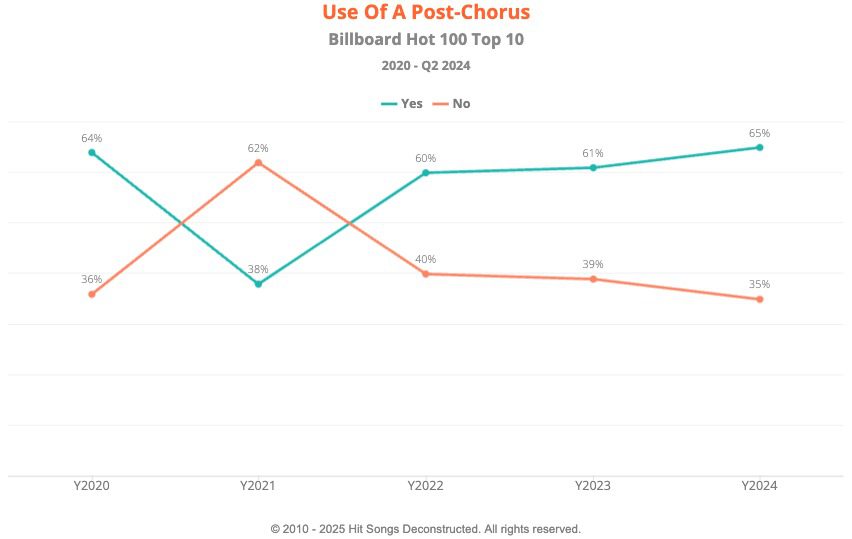

Post-Chorus Sections in Non-Hip Hop Hot 100 Top 10 Hits: 2020 – Q2 2024
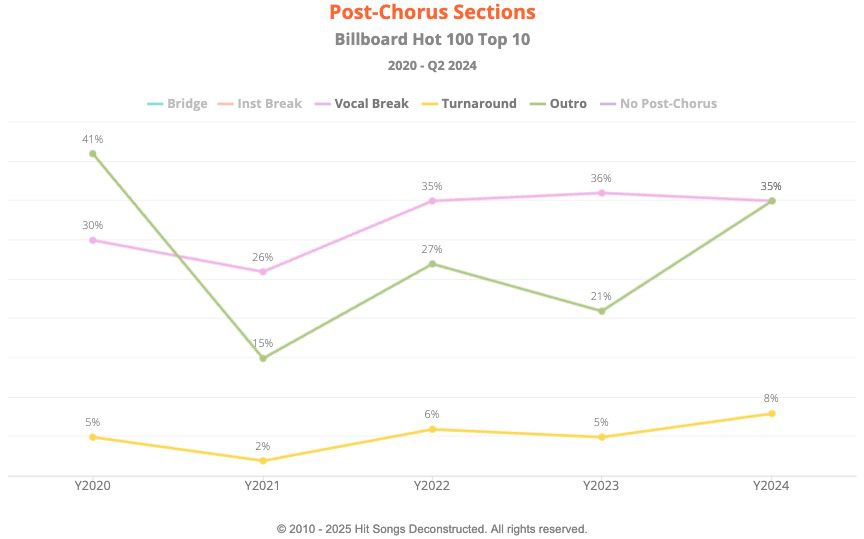

Form


*Note: Section lengths may be rounded.
Time and Percent into the Song When Core Sections Occur
“Die With A Smile"


Core A-B-A-B-D-B Form in Hot 100 Top 10 Hits (Q3 2023 – Q2 2024)


The timing of “Die With A Smile’s” core sections (verse, chorus, and “D” section) are relatively consistent with the averages for non-hip hop Hot 100 top 10 hits from the year prior to its release. All these sections occur within 3% of the average, contributing to the song's structural familiarity.
“Die With A Smile” / Non-Hip Hop Hot 100 Top 10 Average
- Verse 1: 4% / 7%
- Verse 2: 36% / 37%
- Chorus 1: 19% / 21%
- Chorus 2: 51% / 51%
- Chorus 3: 79% / 77%
- First “D” Section: 64% / 61%
Song & Section Length
Song Length
“Die With A Smile” runs 4:02 - 34 seconds longer than the non-hip hop Hot 100 top 10 average of 3:28 in the year before its release. While this bucks the trend toward shorter songs, the 4:00+ range - still the least common overall - doubled in prominence from 11% of songs in 2023 to 22% (8 songs) in the first half of 2024, marking its highest share since 2017. Notably, all but two of those songs were by Taylor Swift, with the others being Hozier’s “Too Sweet” and Luke Combs’ “Fast Car.”
Song Length Ranges of Non-Hip Hop Hot 100 Top 10 Hits: 2020 – Q2 2024
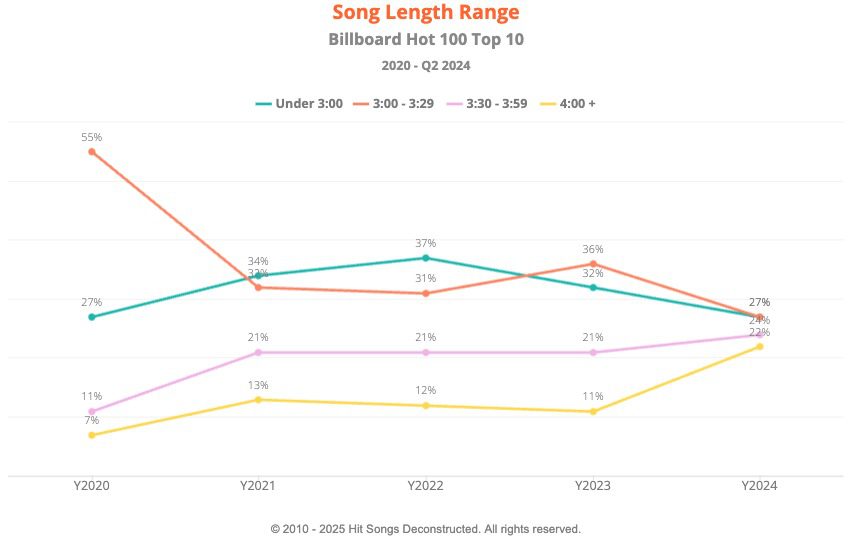

Section Length
“Die With A Smile’s” song sections range from very short to quite lengthy:
- Shortest Sections: The bookending intro and outro and brief turnaround are the shortest sections in the song, clocking in right around 9-seconds and 4-bars in length.
- Moderate Length Sections: The verses, pre-choruses, vocal break, and instrumental break sections are all of moderate length, each landing at 8-bars and 18-seconds.
- Longest Sections: The choruses are the longest sections in the song. Choruses 1 and 2 each land at 14-bars and 32 seconds, while chorus 3 clocks in the longest at 42-seconds and 18 bars in length. However, each chorus consists of two distinct stanzas, which along with heightening in-section engagement makes them easier to absorb and remember.
Compared to the average section length of non-hip hop Hot 100 top 10 hits from the year prior to the song’s release, the intro, verse, and outro sections range slightly to notably shorter; the instrumental break is equal; and the pre-chorus, vocal break, turnaround, and chorus sections range slightly to notably longer.
- Intro: 4-seconds shorter
- Verses: 7-seconds shorter
- Outro: 16 seconds shorter
- Instrumental Break: Equal
- Pre-Choruses: 2-seconds longer
- Vocal Break: 3-seconds longer
- Turnaround: 4-seconds longer
- Choruses: 7-seconds longer (choruses 1 and 2), 17-seconds longer (chorus 3)
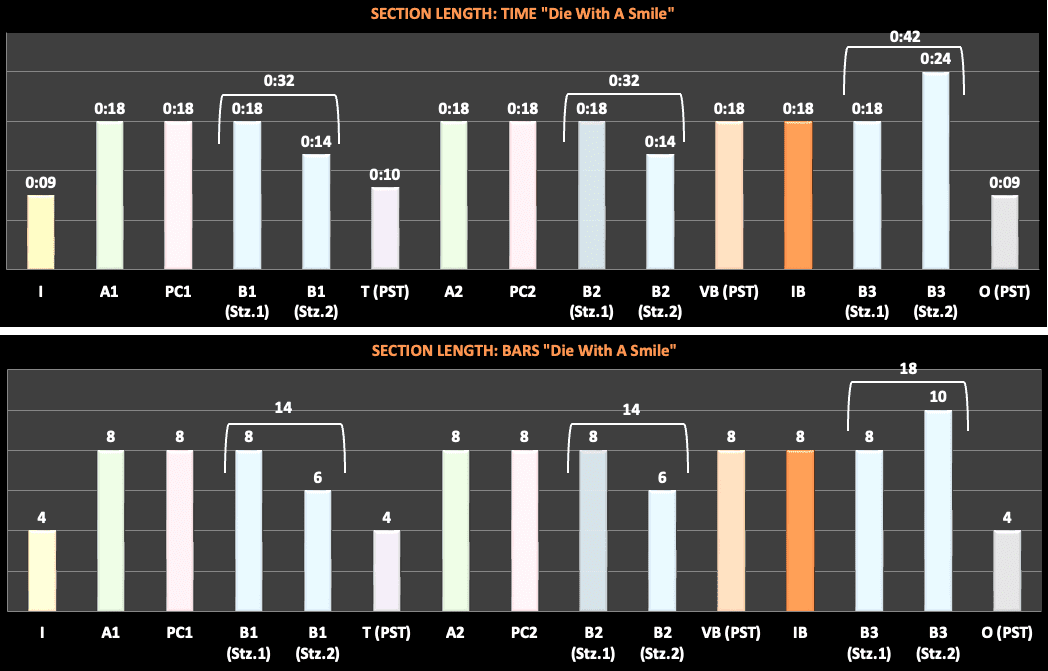

Total Section Breakdown
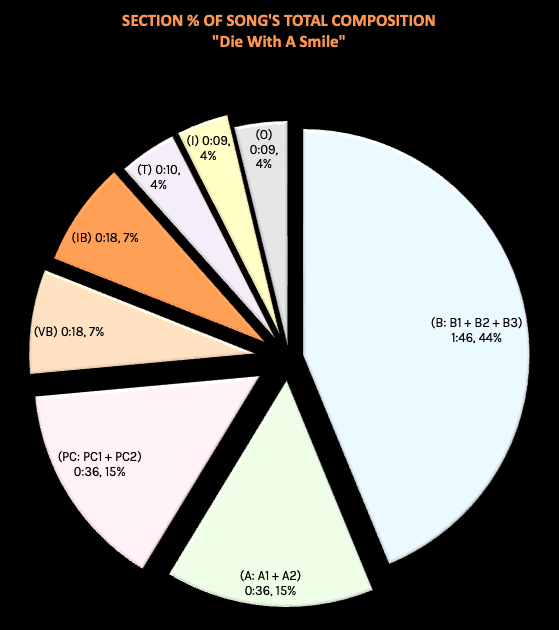

- Intro: 4% / 6%
- Verse: 15% / 29%
- Pre-Chorus: 15% / 16%
- Chorus: 44% / 32%
- Instrumental Break: 7% / 11%
- Vocal Break: 7% / 13%
- Turnaround: 4% / 4%
- Outro: 4% / 12%
Time Signature, Tempo & Key
Time Signature & Tempo
Key
Major vs. Minor Keys in Non-Hip Hop Hot 100 Top 10 Hits: 2020 – Q2 2024
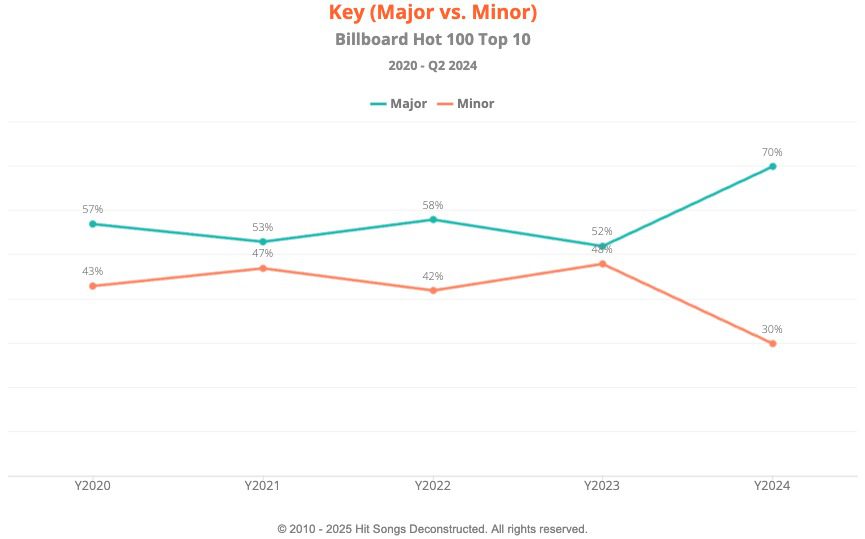

Genres & Influences
Genre & Influence Blend
Key
x: The influence appears minimally within the stanza and/or section


"Cruel Summer" features a combination of pop, electropop/synthpop and retro 1980s influences that are put into effect by the qualities of the vocals, instruments, lyrics, and the overall production.
The song’s main overarching influence, and primary genre, is pop. Notable pop elements include its catchy K.I.S.S. ME (Keep It Simple, Singable and Memorable) melodies and hooks, familiar pop structure, relatable love/relationships-themed subject matter, and polished production, to name a few.
In addition, "Cruel Summer" possesses a strong electropop/synthpop influence, which is put into effect by its heavy use of synths. Some of these synths possess a classic timbre, which along with the mechanical synth bass pattern and use of vocoder provides the song with an underlying early-to-mid retro-1980s vibe.
Blending In & Standing Out in the Hot 100 Top 10
"Cruel Summer’s" expert balance of pop, electropop/synthpop and retro 1980s influences enabled it to both blend in and stand out in the Hot 100 Top 10. While pop in general has been a constant influence in essentially all non-hip hop Hot 100 Top 10 hits over the years, electropop/synthpop and retro 1980s influences are more micro trends that rise and fall in popularity.
Electropop/synthpop, while present in nearly two-thirds of songs in 2018, plummeted to around one-fifth of songs by the end of 2020, before rising again to just over one-third of songs in 2022 and continuing into the first half of 2023. In addition to "Cruel Summer," recent representatives include the #1s "As It Was" (Harry Styles), "Like Crazy" (Jimin), and Taylor Swift’s other recent megahit, "Anti-Hero."
Retro 1980s is even more niche, generally accounting for one-fifth of songs or less over the past decade save for spikes in 2015 (25% of songs) and 2022 (31% of songs). However, save for 2020, where the 1970s rose in popularity, the 1980s has consistently been the most popular decade among retro-tinged hits. Other recent representatives include the aforementioned "Anti-Hero," "As It Was" and "Like Crazy," and the Justin Bieber and The Kid LAROI’s #1 smash, "Stay."
Cruel Summer was also primed for success in 2020, when it was originally slated for release as a single but was put on the backburner due to the emerging Covid-19 epidemic. In the year prior, electropop/synthpop was peaking at just over two-thirds of songs, and retro 1980s, while far less popular at just 13%, was present in notable hits such as "Bad At Love" (Halsey), "Boo’d Up" (Ella Mai), "Never Be The Same" (Camila Cabello) and "Youngblood" (5 Seconds Of Summer).
Influences in the Hot 100 Top 10: 2018 – Q2 2023 (Outside the Hip Hop/Rap Primary Genre)
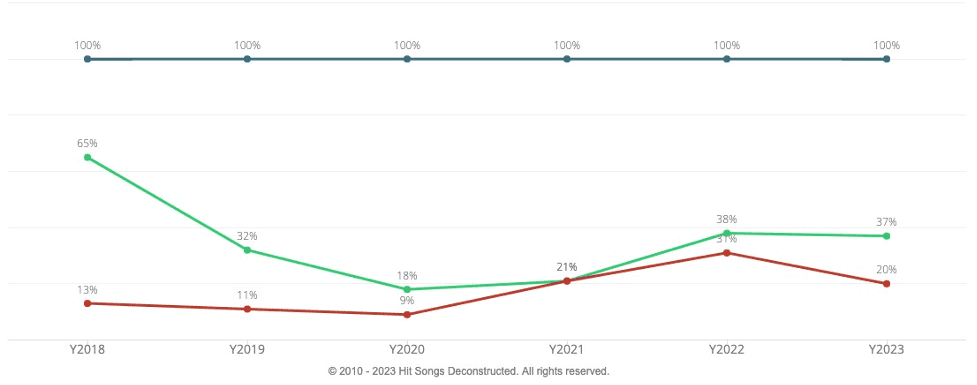

Key
Blue: Pop | Green: Electropop/Synthpop | Red: Retro (1980s)
Energy & Dynamics
Energy Arrangement
S.I.A. (Section Impact Accentuator) Key
Downward Red S.I.A.: The full accompaniment is removed from the mix, resulting in a brief reduction in energy
Downward Yellow S.I.A.: A part of the accompaniment is removed from the mix, resulting in a brief reduction in energy
Upward Green S.I.A.: The accompaniment creates a brief rise in energy


Loudness
“Cruel Summer’s” loudness levels generally match the song’s three energy “waves,” progressing from low to high across each sectional progression. Levels range from -16.5 in the outro (quietest) to -7.5 in the chorus “hook centers” and climactic second bridge (loudest). Note that the higher loudness levels in these song-defining sections allows them to further stand out, connect and bolster the listener’s emotional connection with the song.
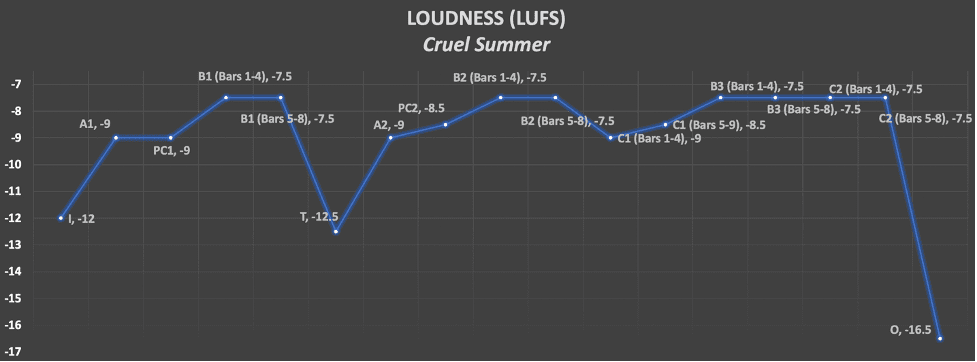

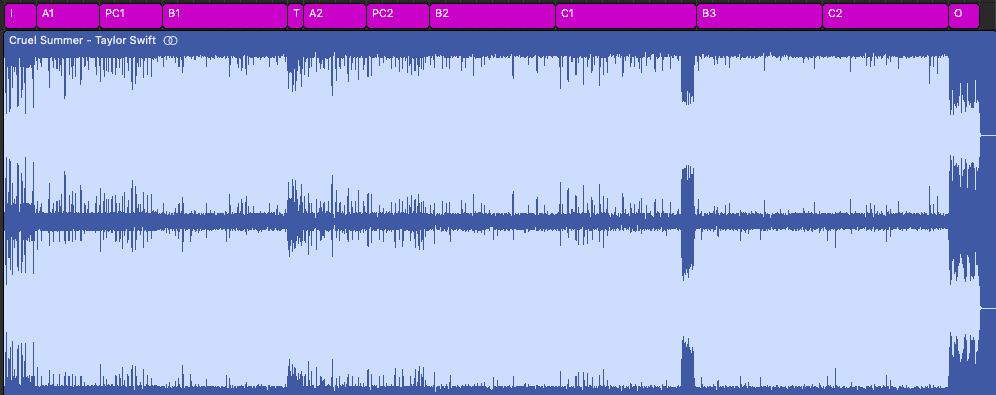

Energy: Section-By-Section
Wave 1: Intro (I) – Chorus 1 (B1)
Intro (I)
In the same vein as many hit songs, “Cruel Summer’s” intro features one of the lowest energy levels in the song, which provides room for growth in subsequent sections. This is due to the sparseness of the arrangement, which consists solely of vocoder, low-octave synth bass, kick, and snare.
Note that in lieu of density, these elements establish the groove right from the get-go, providing a rhythmic pulse that carries over into the subsequent verse.
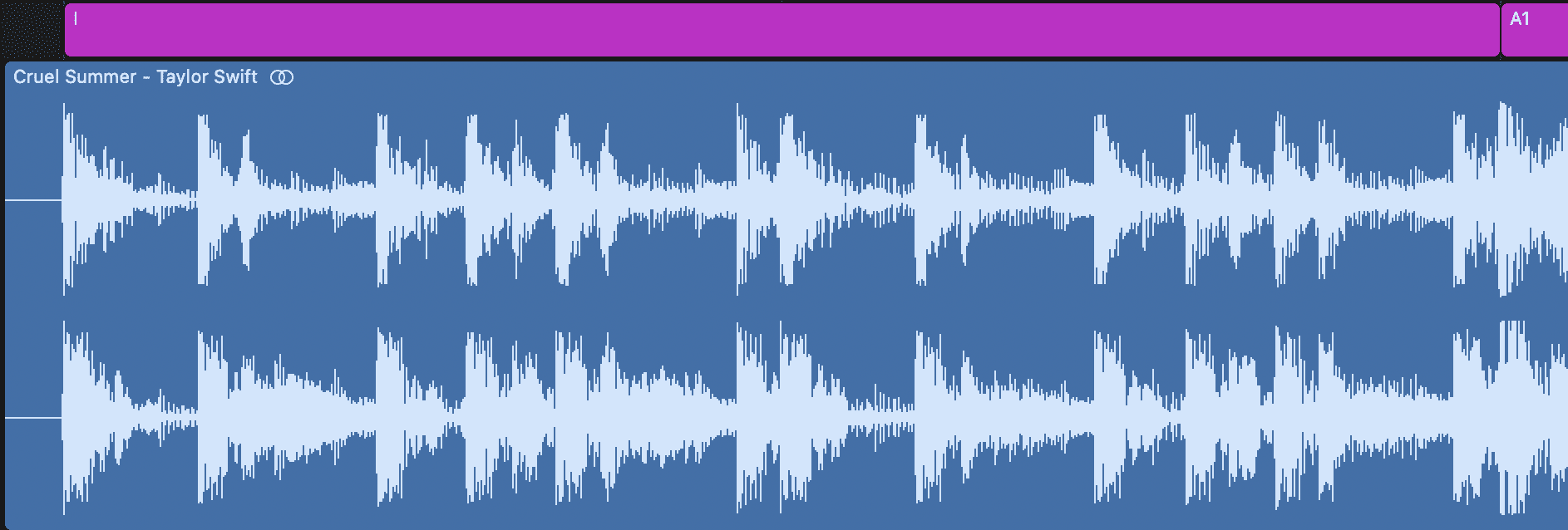

Verse 1 (A1)
Following the sparse intro, the verse kicks energy up a notch with the introduction of Swift’s lead vocal, as well as additional drum layers on the backbeat and a dark synth pad. In bar 3, a pulsing synth and electric guitar are added to the mix, heightening tension leading into the ensuing pre-chorus.
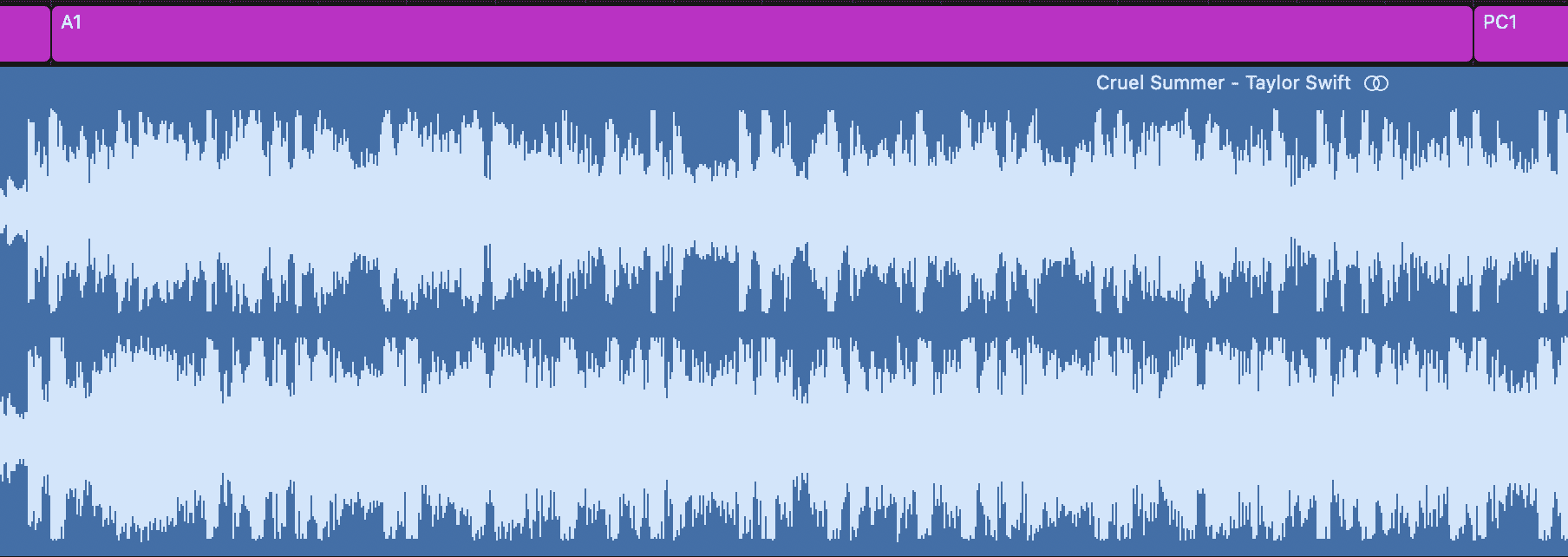

Pre-Chorus 1 (PC1)
The pre-chorus slightly bumps up energy over the verse, most notably in the second half of the section. Providing this rise is the more animated and impassioned quality of Swift’s vocal delivery, the tension-heightening, pulsing synth and electric guitar becoming a bit more prominent in the mix, and the focus on the tense five (V) chord leading into the chorus.
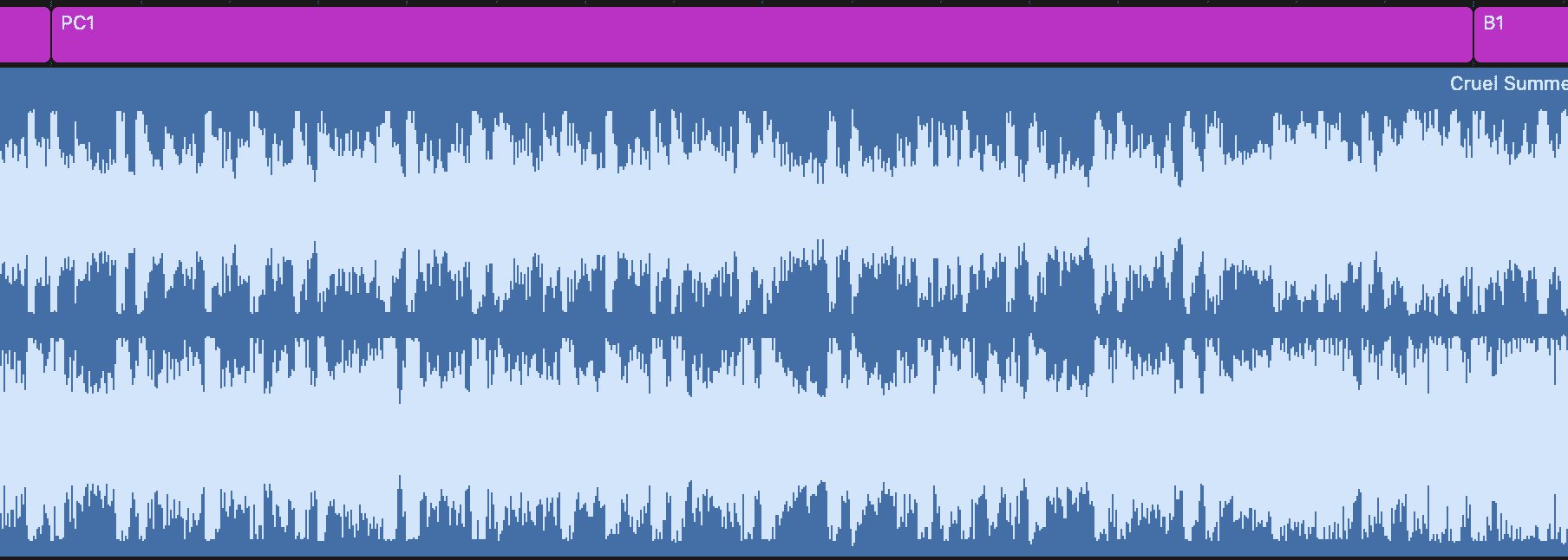

S.I.A. #1
Chorus 1 (B1)
Following the tension-heightening pre-chorus, chorus 1 thrusts the song’s energy to its first peak, providing the listener with the first of three energy “payoffs.” This is a result of both instrumental and vocal developments, including the dense “wall” of synth and drum layers, Swift’s highly impassioned vocal delivery, and the additional lead and background vocal layers.
Note that big, high-energy first choruses like this have become somewhat of a rarity in the Hot 100 Top 10 compared to years past, evident in hits such Kelly Clarkson’s “Stronger” (2011), Miley Cyrus’s “Wrecking Ball” (2013), and Sia’s “Chandelier” (2014), to name a few. However, here it makes sense as it effectively supports the sentiment of the lyrics to create effective prosody and bolster’s the listener’s emotional connection with the song.
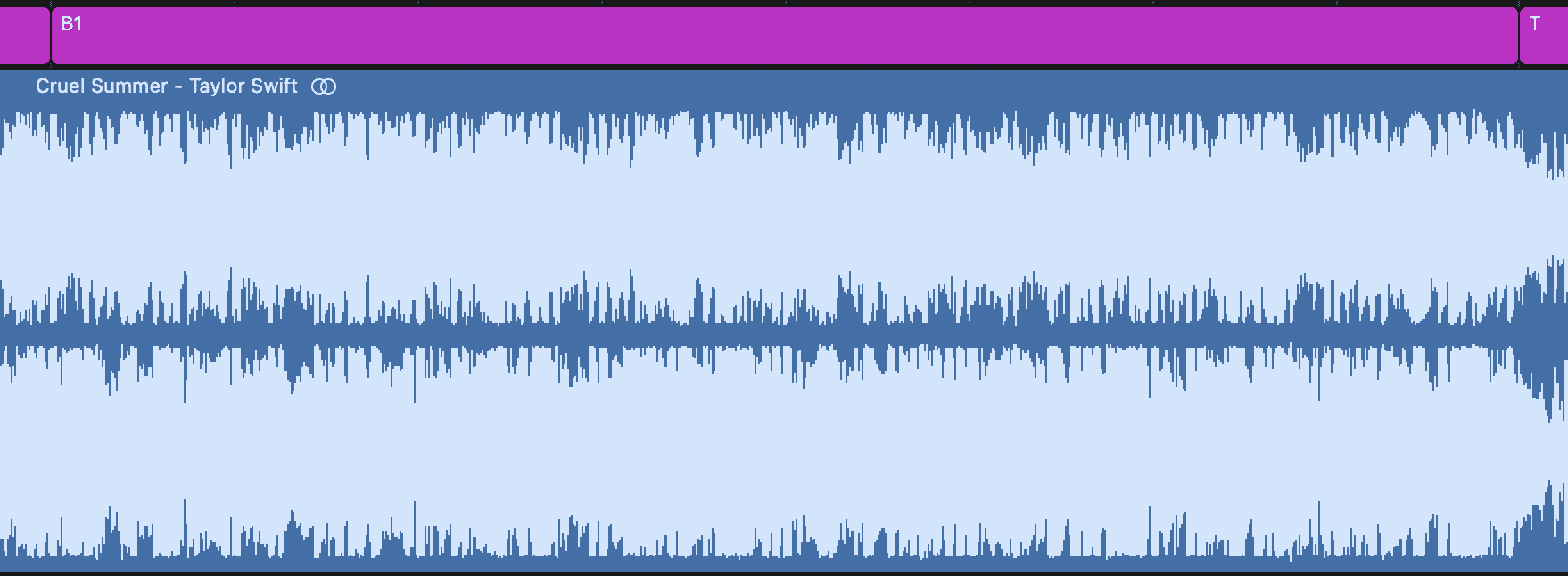

Wave 2: Turnaround (T) – Chorus 2 (B2)
Turnaround (T)
Following the high energy first chorus, the turnaround notably brings the song’s energy back down at the beginning of “wave 2.” This is due to a reversion to the sparse intro arrangement, which is now processed with copious reverb, making it sound thinner and more distant in comparison. This dramatic shift serves to engage the listener at a heightened level following four consecutive sections of energy growth, and provide room for the song to build in subsequent sections.
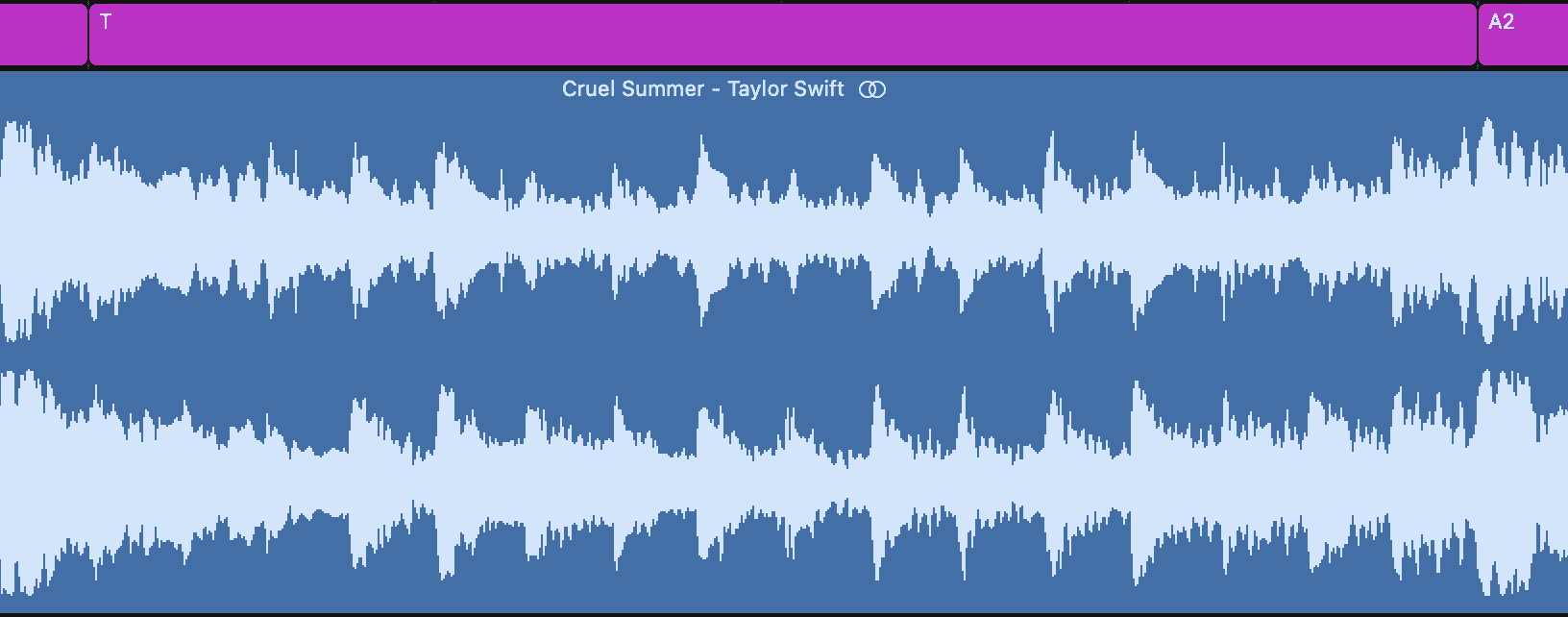

Verse 2 (A2)
Following the brief, low energy turnaround, verse 2 kicks the song’s energy back up with a denser, more present arrangement. While the section features highly similar qualities as its verse 1 counterpart, it uniquely adds new elements including prominent brass synth stabs and high, lead-harmonizing background vocals, which provide verse 2 with a slightly higher energy level in comparison.
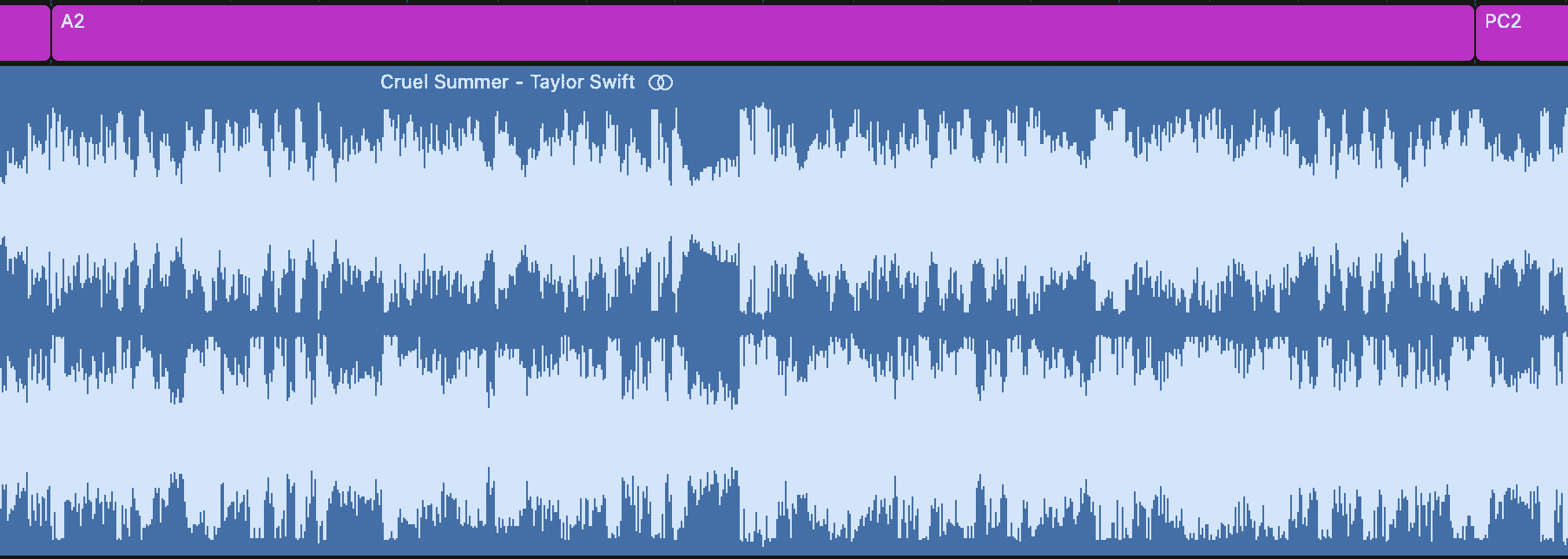

Pre-Chorus 2 (PC2)
Similar to the relationship between verses, pre-chorus 2 features a slightly higher energy level compared to its pre-chorus 1 counterpart. This is mainly due to the inclusion of the brass synth stabs, which weren’t featured the first time around.
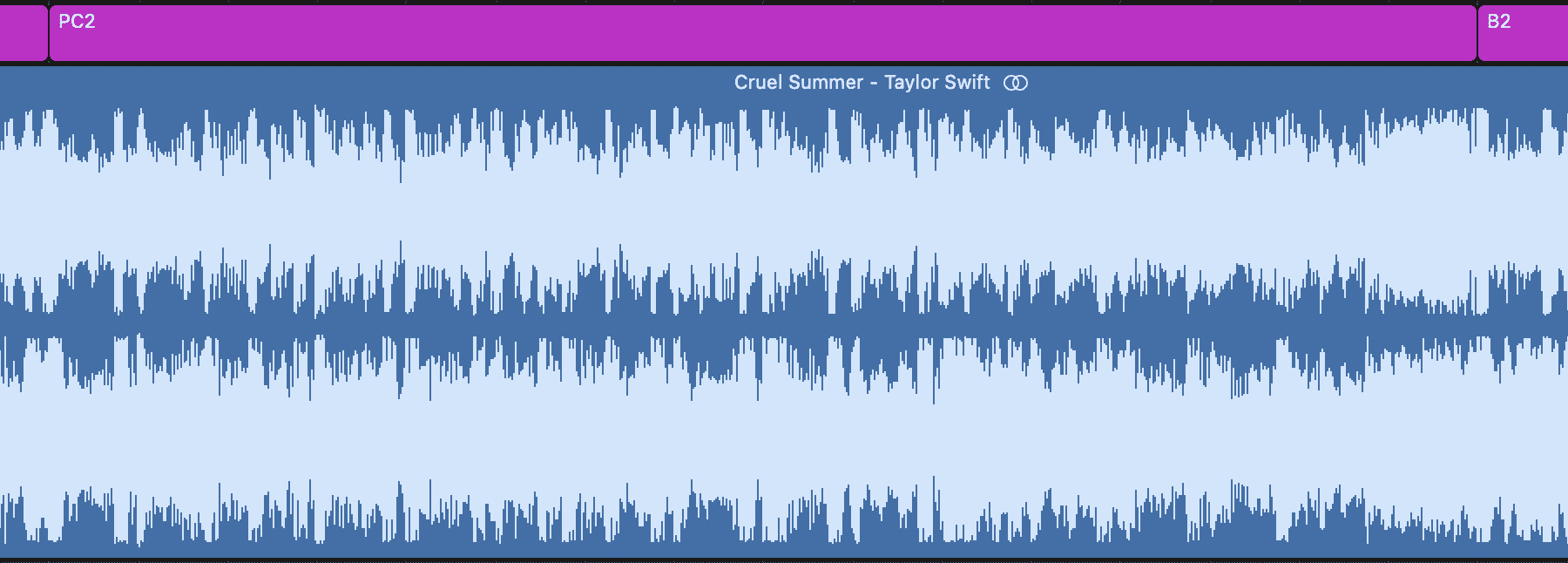

S.I.A. #2
The last two beats of pre-chorus 2 employ a partial accompaniment pull S.I.A., removing the main drum groove from the mix, along with the addition of a white noise and reverse synth riser. Together, they notably heighten tension and anticipation leading into the second chorus, which is marked by the familiar crash and hi hat roll on the chorus’ downbeat.
Chorus 2 (B2)
Following the pronounced S.I.A. at the end of pre-chorus 2, chorus 2 hits with increased perceived impact and energy compared to the first time around due to the more notable contrast between S.I.A.s. However, as a whole, the second chorus’ energy is largely on par with chorus 1 due to their similar arrangements, save for a subtle bump in stanza 2 due to the additional vocal layers and the addition of the bright synth arpeggio. This takes the song’s energy to its second peak.
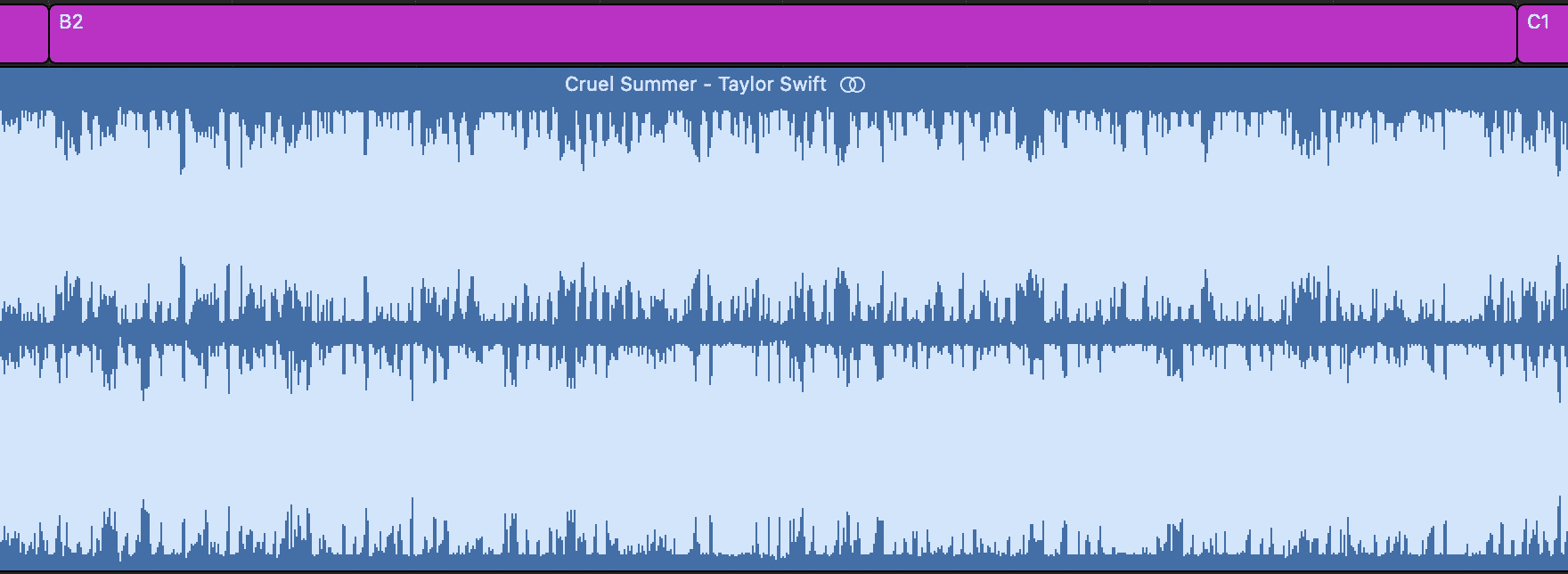

Wave 3: Bridge 1 (C1) – Outro (O)
Bridge 1 (C1)
Following the energy peak in chorus 2, the bridge 1 “D” section begins “wave 3” with a slight reduction in energy in its first stanza mainly due to the less dense instrumental and vocal arrangements. However, this is offset by a rise in rhythmic energy, put into effect by the driving qualities of the pronounced synth arpeggio, drums and Swift’s lead vocal, along with the iconic shouted/sung hybrid vocal at the end.
Stanza 2 then follows with a slightly higher energy, put into effect by the addition of a background vocal pad along with swelling synths, drum fill and shouted/sung vocals at the end that culminate in the “Last Chorus Super S.I.A.” technique leading into chorus 3 (see below for details).
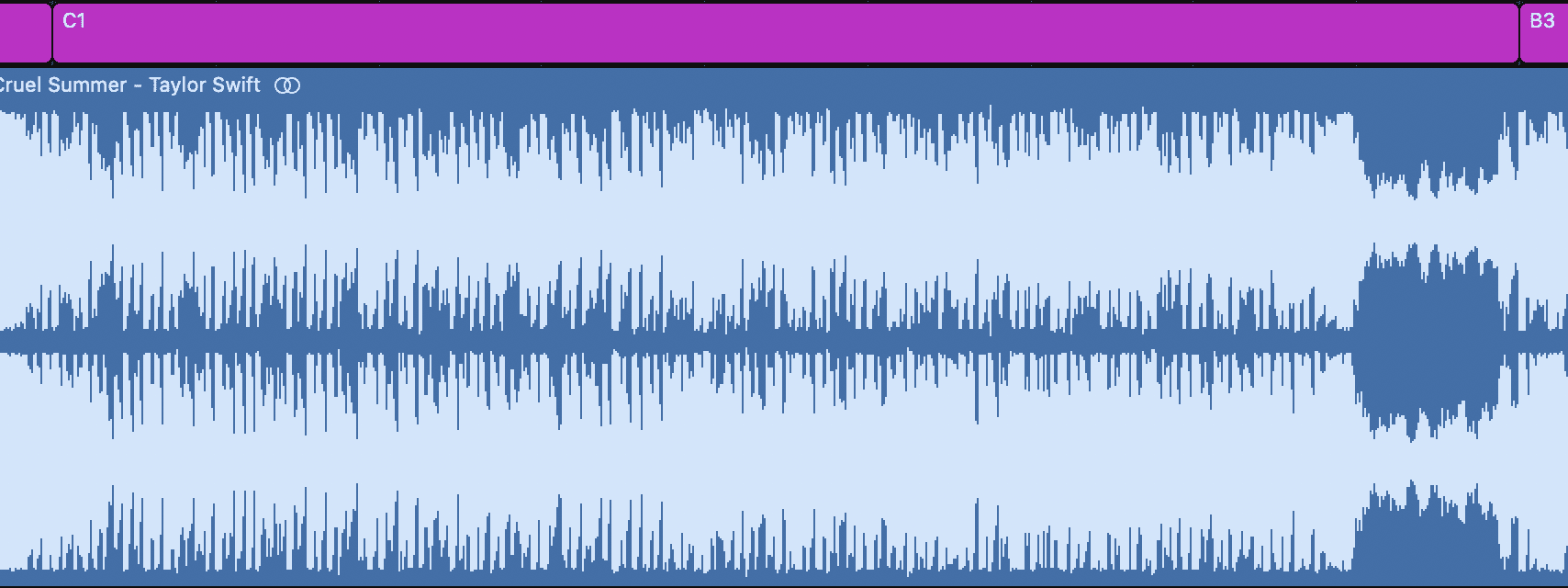

S.I.A. #3
Following the engagement-heightening synth swells, drum fill and shouted vocals toward the end of the bridge, an extra bar is uniquely tacked on that removes all the instrumental elements from the mix, leaving only Swift’s shouted/sung hybrid lead vocal. This unexpected moment is what Hit Songs Deconstructed calls the “Last Chorus Super S.I.A.” technique, which serves to notably heighten engagement leading into the final climactic chorus in the song.
Furthermore, note that this brief lull was well warranted and highly important considering that there are no other sectional energy lulls in “wave 3” save for the outro (note that the most common place to bring down a song’s energy is in all, or most of, a “D” section such as a bridge). Albeit brief, without it, the listener would remain in sustained moderate to high energy for numerous sections, reducing the impact of the last chorus and potentially resulting in decreased engagement.
Chorus 3 (B3)
Chorus 3 hits with the greatest impact of all the choruses following the full accompaniment pull “Last Chorus Super S.I.A.” (note that the impact of each subsequent chorus has gotten more pronounced as the song progressed). Stanza 1 reprises the dense chorus 2, stanza 2 instrumental arrangement, while stanza 2 increases energy with additional background vocal layers.
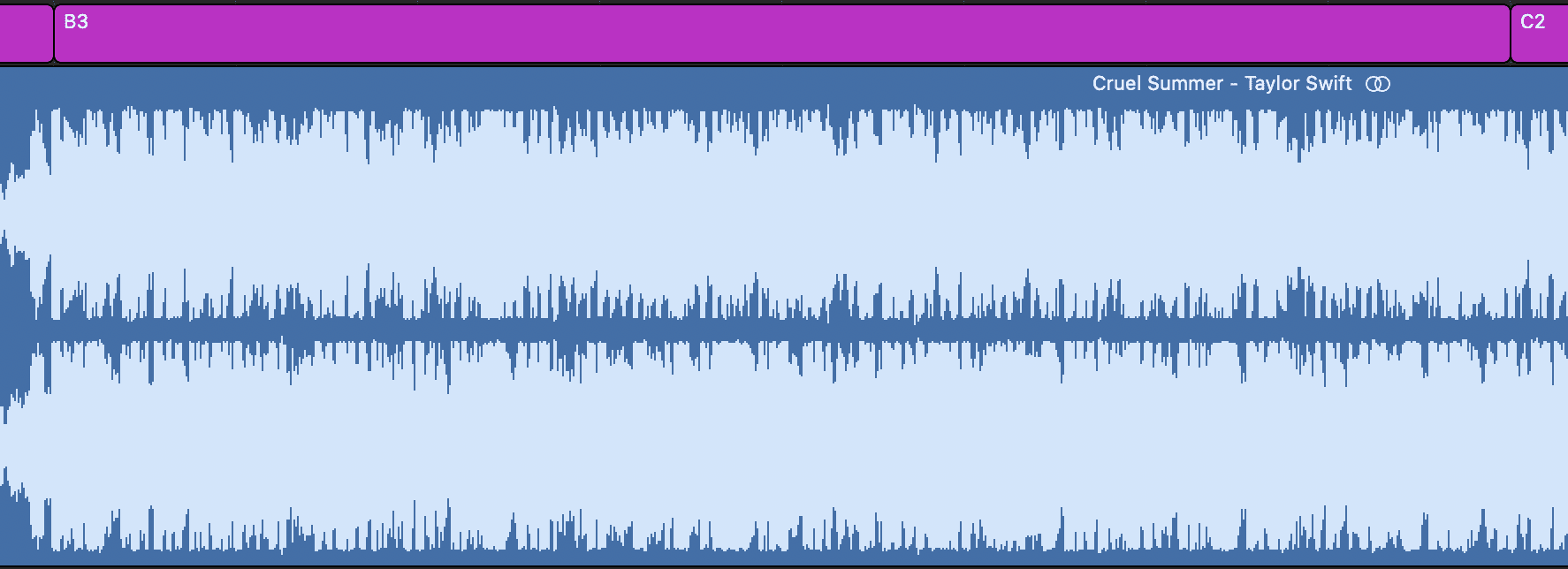

S.I.A. #4
In between the third chorus and second bridge, a dark electronic hi hat provides a brief fill that provides separation between sections of similar accompaniment, heightening the listener’s engagement.
Bridge 2 (C2)
Bridge 2 takes the song’s energy to its grand peak. It does so by combining the dense chorus accompaniment with the driving bridge 1 vocals and shouted/sung punctuations, along with the forward motion of additional hi hat layers. The section culminates in a swell similar to that at the end of bridge 1, taking intensity and excitement to a climax before heading into the ensuing outro.
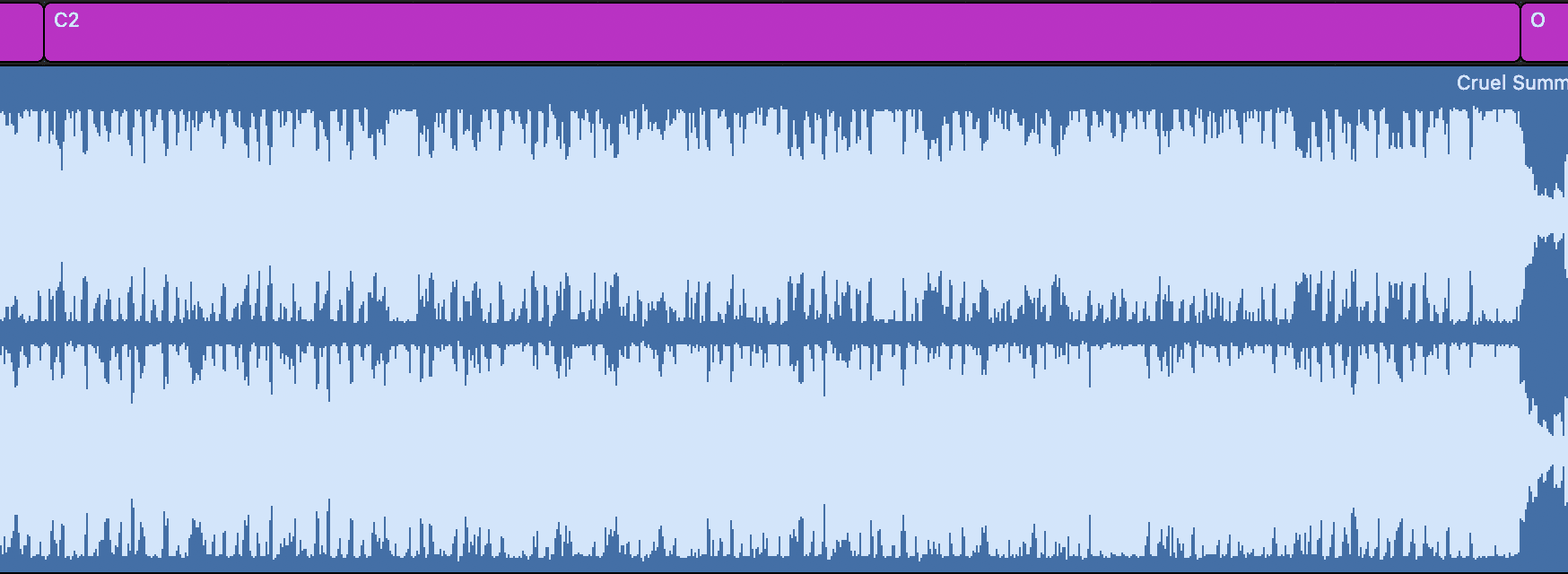

S.I.A. #5
In between bridge stanzas, the bright electronic hi hat provides a brief fill that serves to subtly provide separation between stanzas and heighten the listener’s engagement.
Outro (O)
Following the song’s energy peak in the second bridge, the outro winds the song down with a notable drop in energy through a reversion to the thinned-out arrangement that defines the intro and turnaround.
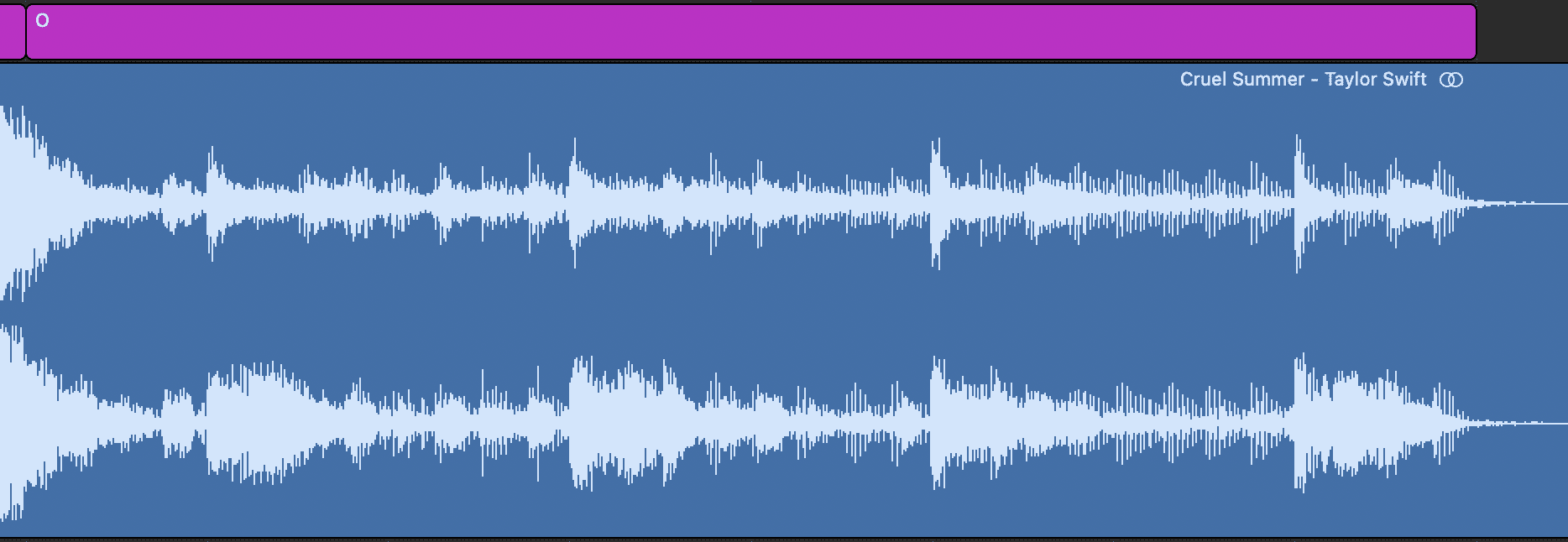

Instrumental Arrangement
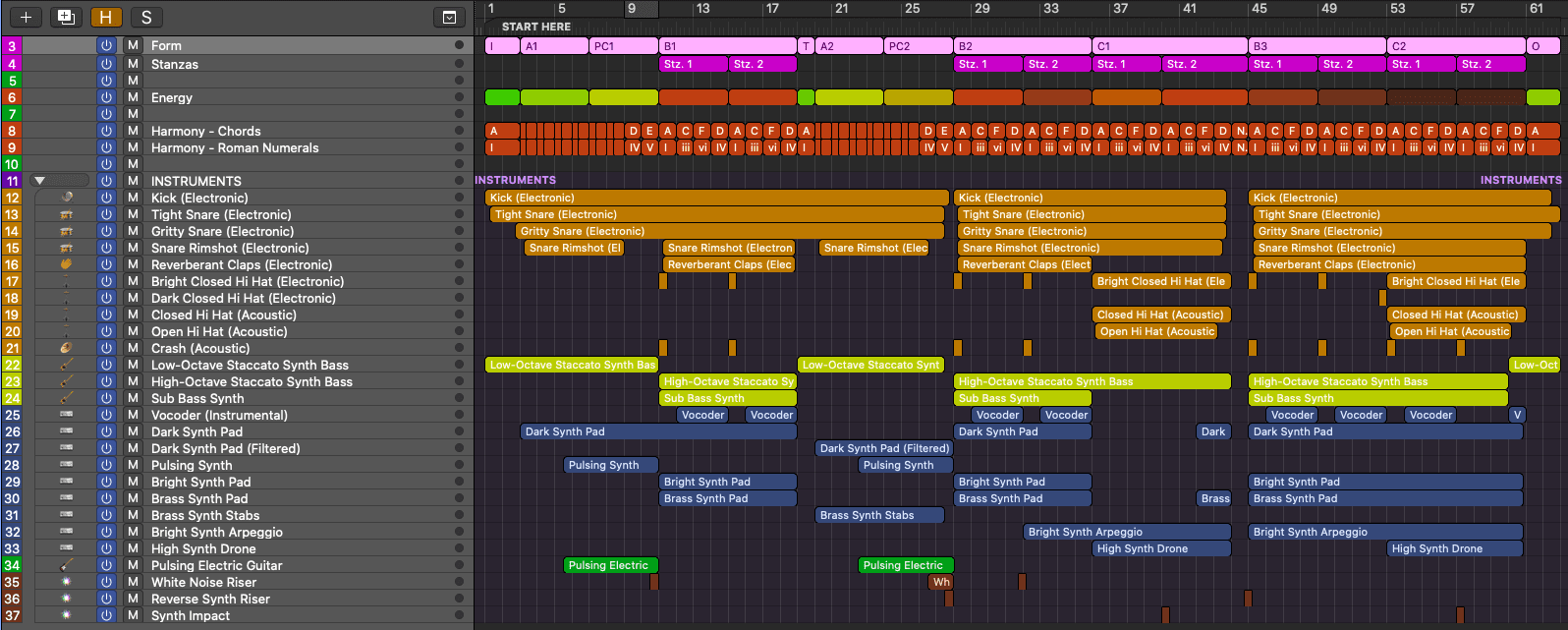

Primary Instruments
Drums/Percussion
Kick (Electronic)
The electronic kick drum is introduced in the intro and drives the groove forward for the duration of the song. It is processed with notable compression to create a punchy timbre that cuts through the mix.
Bright Snare (Electronic)
The bright electronic snare possesses a thin, dry timbre and provides a cohesive backbeat thread throughout the entire song.
Gritty Snare (Electronic)
The gritty electronic snare is layered in with the bright snare in all sections save for the intro and outro. It possesses a bit-crushed distorted timbre and is treated with reverb.
Snare Rimshot (Electronic)
The electronic snare rimshot is initially heard in verse 1 and is present in every subsequent section save for the turnaround. It punctuates the backbeat with a unique, metallic, pitched timbre that stands out in the mix.
Reverberant Claps (Electronic)
The electronic claps are heard in the choruses and bridge 2. Their reverberant, dark timbre contrasts the otherwise brighter and dryer backbeat and contributes to the sections’ dense, climactic arrangements.
Bright Closed Hi Hat (Electronic)
The bright electronic closed hi hat is heard exclusively in the chorus and bridge sections. In each chorus, it provides a subtle roll punctuation to the beginning of each stanza, while in the bridge sections its role is more notable, contributing to the groove throughout. It features a bright, thin timbre, is panned slightly to the right and is featured at a low level in the mix.
Dark Closed Hi Hat (Electronic)
The dark electronic closed hi hat provides a fill between stanzas 1 and 2 of bridge 2 and features a dark, gritty timbre.
Closed Hi Hat (Acoustic)
The acoustic closed hi hat is featured solely in the bridge sections. It provides further rhythmic motion to the section, blending with the closed electronic hi hat.
Open Hi Hat (Acoustic)
The acoustic open hi hat is featured solely in the bridge sections, possessing a gritty timbre identical to its closed counterpart. It punctuates the “and” of beat 1, subtly heightening interest of each section’s rhythm.
Crash (Acoustic)
The acoustic crash is heard punctuating the downbeat of each stanza in the choruses and second bridge at a relatively low level in the mix.
Bass
Low-Octave Staccato Synth Bass
The low-octave staccato synth bass is initially heard in the intro and appears in every subsequent section save for the choruses and bridges. It possesses a saw-wave timbre that is reminiscent of commonly heard Moog synth basses from the 1980s and plays a steady, mechanical sixteenth-note-driven rhythm, also in line with the 1980s.
High-Octave Staccato Synth Bass
The high-octave staccato synth bass is heard in the chorus and bridge sections. It features a filtered saw-wave timbre that effectively balances a strong articulation with an unobtrusive tone, providing an underlying mid-range synth pulse to the arrangement.
Sub Bass Synth
The sub bass synth is featured in the chorus and bridge sections, providing a sustained, sine wave foundation to the low end of the mix.
Synths
Vocoder (Instrumental)
Vocoder serves in more of an instrumental, textural capacity in the choruses and second bridge compared to its vocal hook focus in the intro, turnaround and outro.
Dark Synth Pad
The dark synth pad is initially heard in the first verse, and appears in every subsequent section save for the turnaround, second verse and pre-chorus, and outro. It possesses a filtered, retro-tinged timbre and provides subtle rhythmic and harmonic motion underneath the groove.
Dark Synth Pad (Filtered)
A low-level, heavily-filtered version of the dark synth pad appears in the second verse and pre-chorus.
Pulsing Synth
The pulsing synth is heard in the verses and pre-choruses. It performs a sixteenth-note pattern and possesses a bright timbre that gradually increases in volume leading into first and second choruses.
Bright Synth Pad
The bright synth pad is heard in the choruses and second bridge. It provides further harmonic support with a notably high-end focused, digital, resonant timbre that contrasts from the warm, rich sounds of the brass and dark pads.
Brass Synth Pad
The brass synth pad appears in the chorus and bridge sections. It features a saw wave-timbre reminiscent of a Roland Juno brass patch that further fills out the dense synth-driven arrangement.
Brass Synth Stabs
The brass synth stabs appear solely in the second verse and pre-chorus sections. They are featured prominently in the mix, providing harmonic support while bolstering the retro 1980s influence with a timbre also reminiscent of a Roland Juno.
Bright Synth Arpeggio
The bright synth arpeggio is initially heard in the second stanza of chorus 2 and is featured in every subsequent section save for the outro. It features a bright, percussive timbre and provides further rhythmic motion within the dense arrangement. It is panned across the stereo field and is at a low level in the mix, becoming most audible when reaching higher-register notes in sparser sections.
High Synth Drone
The high synth drone pad provides a sustained, high-pitched note to the bridges. It features a bright timbre that helps balance out the many mid-range synth layers and is relatively low in the mix.
Guitar
Pulsing Electric Guitar
The sole guitar in the song is heard in the verses and pre-choruses. It features a gritty, mid-range tone that gradually increases in volume over the course of its performance.
Effects
White Noise Riser
The white noise riser possesses a bright, noise-based timbre, functioning in an engagement-heightening, transitional role at the end of the pre-choruses and between stanzas 1 and 2 of the second chorus.
Reverse Synth Riser
The reverse synth riser provides an engaging transition between the second pre-chorus and chorus sections. It possesses a reversed saw-wave synth timbre that creates a swelling effect to maximize the chorus’s arrival.
Synth Impact
The synth impact occurs solely in between stanzas 1 and 2 of the bridges, punctuating the second stanza with a downlifting, pitched synth stab.
Instrumental Arrangement: Section By Section
Intro (0:00 – 0:05)
Chord Progression: A (A major: I)
“Cruel Summer’s” intro features the sparsest arrangement in the song, consisting of kick, snare, and synth bass. Note that the sparse intro technique has consistently been one of the two most common techniques used in Hot 100 Top 10 hits over the past decade (along with the backing music technique, which the song also possesses), as it provides a springboard to establish key aspects of the song while providing room for growth in subsequent sections.
Sonically, all the elements have a distinct electronic quality, which along with their timbres and patterns creates an engaging, retro-1980s inspired tapestry that instantly engages the listener.
On the lower end of the frequency spectrum is the kick drum, which plays a vibrant pattern and is processed with a prominent short tail reverb to give it a spacious, big sound. Contrasting it is the tight snare, which covers the mid/high frequency range with its notably brighter, tighter timbre and steady backbeat pulse.
Rounding out the instrumental arrangement is the low-octave staccato synth bass. It establishes the song’s key and provides the mix with a 1980s-inspired texture through its saw-wave timbre, reminiscent of a Moog synthesizer and a mechanical sixteenth-note pattern that possesses a Kraftwork and Devo-esque quality. Also note the brief leap that occurs on the “and” of beats 2 and 4, which subtly heightens interest against its otherwise stagnant pattern.
In addition to the above, the consistency of the arrangement serves as an effective backdrop for the vocoder-processed vocal hook to shine. It serves in both vocal and instrumental capacities, contributing to the section’s texture, rhythm, and catchiness.
At the end of the section, a new snare is heard on the last beat, possessing a grittier timbre that sustains longer than the tight snare. Punctuating the mix, it subtly serves to usher in the ensuing verse without disrupting the groove.
Intro Arrangement: At-A-Glance
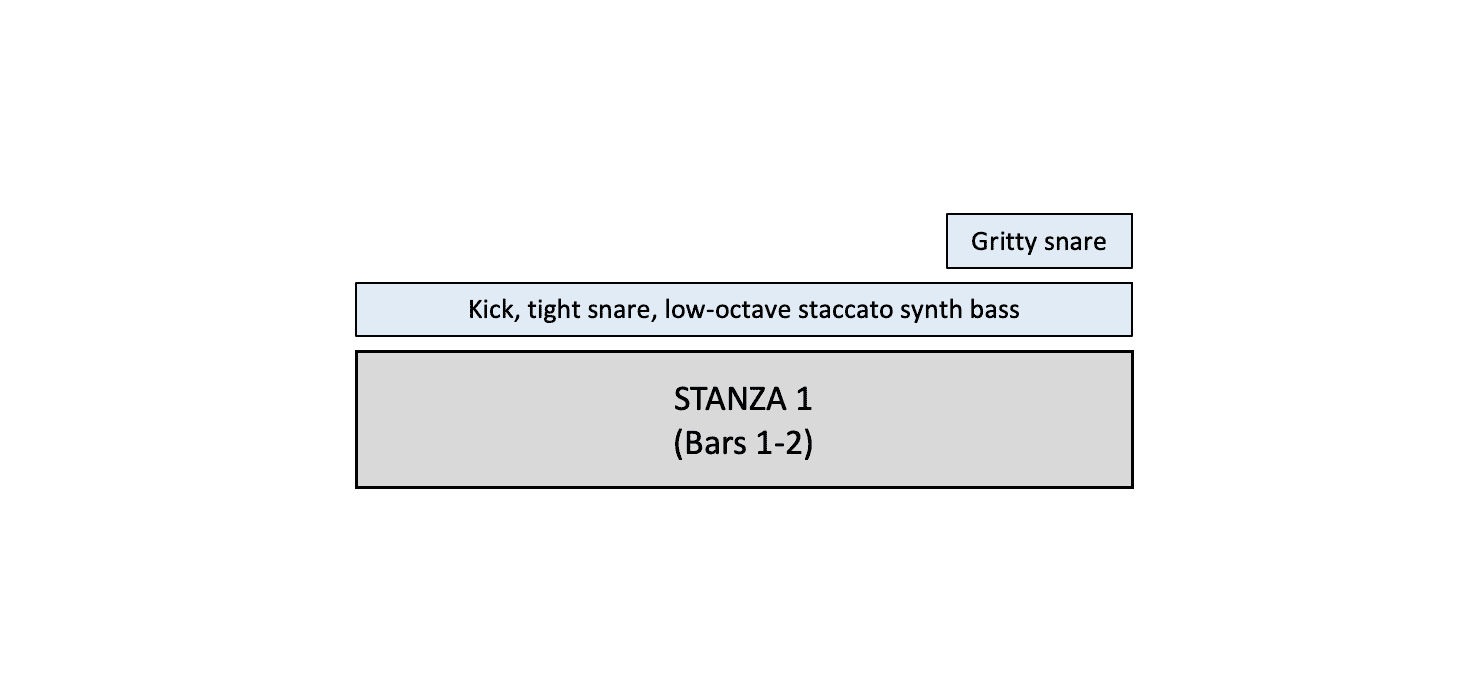

Verse 1 (0:05 – 0:17)
Chord Progression: D – E – C#m – F#m (A major: IV-V-iii-vi)
With the intro arrangement remaining in effect to provide cross-section continuity and allow the listener’s full attention to be on Swift’s first installment of the narrative without distraction, the following instrumental elements are added to the mix to heighten cross-section interest:
- The gritty snare and new snare rimshot are added to the backbeat. Both provide the verse with an interest-heightening textural development that also punctuates the backbeat against Swift’s lead vocal and the vocoder-processed background vocals.
- A dark synth pad plays a legato pattern over the continuation of the low-octave staccato synth bass from the intro. Possessing a filtered, retro 1980s-tinged timbre, its addition serves a few key purposes, including providing additional texture, color and density to the mix, adding an additional harmonic layer and motion, and providing a subtle dark and foreboding vibe that creates prosody with the song title, “Cruel Summer.”
- In bar 3, a pulsing synth and electric guitar enter the mix, playing sixteenth-note patterns at a low level. In addition to contributing to the section’s sonic tapestry, they serve to subtly heighten interest midway through the verse and begin to increase tension in anticipation for the impending chorus by way of the ensuing pre-chorus.
Verse 1 Arrangement: At-A-Glance
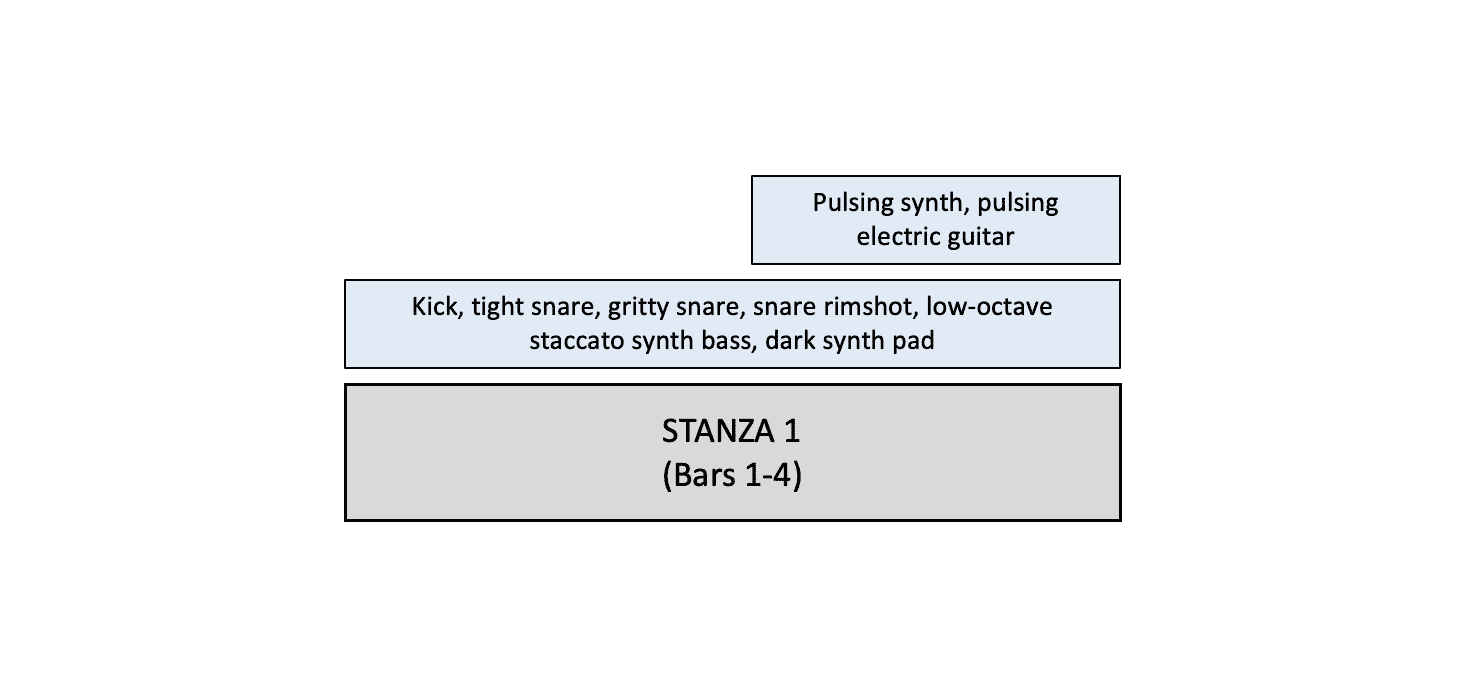

Pre-Chorus 1 (0:17 – 0:28)
Chord Progression: D – E – C#m – F#m – D – E (A major: IV-V-iii-vi-IV-V)
The verse arrangement seamlessly carries over into the pre-chorus and features little development throughout the section. This puts the spotlight on the engaging vocals and lyrics which, along with the continuation of the pulsing synth and guitar, continues to heighten tension and anticipation for the impending chorus.
There are a few subtle developments, however, in the last two bars that serve to further heighten anticipation for the chorus and bolster its impact when it arrives. This culminates into the Hit Songs Deconstructed S.I.A. (section impact accentuator) technique in the last beat of the section, unfolding as follows:
- The harmonic progression simplifies, sustaining on the V chord at the end of the section, which further heightens tension leading into the chorus.
- The rimshot is removed from the mix. This results in a slightly smaller, more contained sound on the backbeat that allows the bigger sounding chorus to hit with greater perceived impact.
- The pulsing synth and guitar increase in volume, which along with the white noise riser, takes tension and anticipation to a climax, resulting in the S.I.A. in the last beat.
Pre-Chorus 1 Arrangement: At-A-Glance
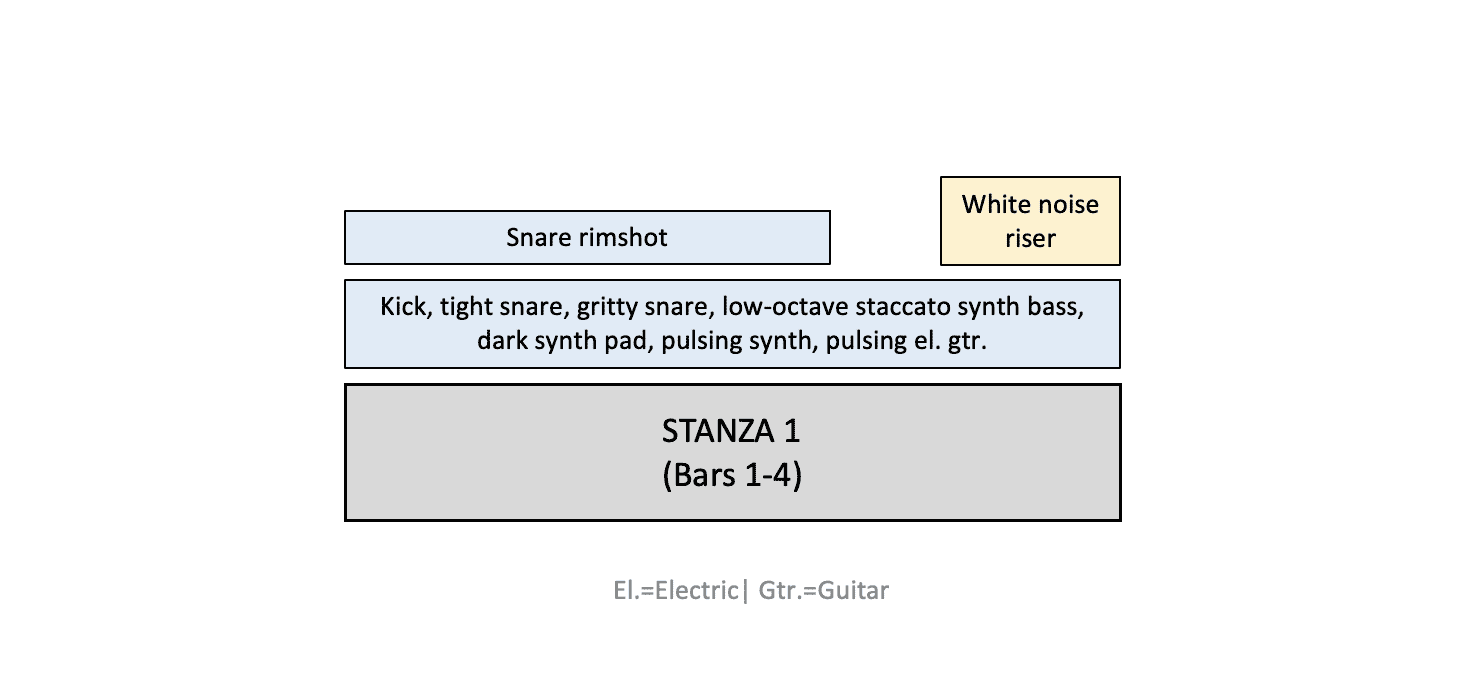

Chorus 1 (0:28 – 0:51)
Chord Progression: A – C#m – F#m – D (A major: I-iii-vi-IV)
Following the tension and anticipation-heightening pre-chorus, the chorus hits with a notably denser, “wall of sound” synth-driven production, punctuated by an acoustic-timbred crash and closed hat roll on beat 1.
With the core drum groove and dark synth pad from the pre-chorus providing cross-section cohesion and continuity, the following elements are added to, or changed up, in the chorus:
- The snare rimshot is added back in along with the new reverberant claps. Together, they further punctuate the backbeat and contribute to the chorus’ deeper, bigger, and more powerful sound.
- Two new, similarly functioning synth pads are introduced that contribute to density, provide harmonic support and further fill out the frequency spectrum: A 1980s-sounding brass synth pad, which features a saw wave timbre reminiscent of a Roland Juno brass patch, and a bright synth pad that features a digital, resonant timbre that contrasts from the warmer, richer sounds of the other pads in the mix.
- The vocoder is added back in for the first time since the intro. However, here it is notably lower in the mix and melding with the other synths to contribute unique texture and color the sonic landscape as opposed to delivering a standout vocal hook.
- A high-octave staccato synth bass replaces its low-octave counterpart heard across the first three sections of the song. While it’s relatively low in the mix, its addition contributes mid-range texture along with subtle forward motion.
Like the verse, and most of the pre-chorus before it, the chorus arrangement remains essentially static from start to finish, save for the familiar crash and hi hat roll that punctuates the arrival of stanza 2. Again, this allows the listener’s full focus to be on the catchy, evocative, hook-based vocals while elevating the section’s emotional connection with the listener.
Chorus 1 Arrangement: At-A-Glance
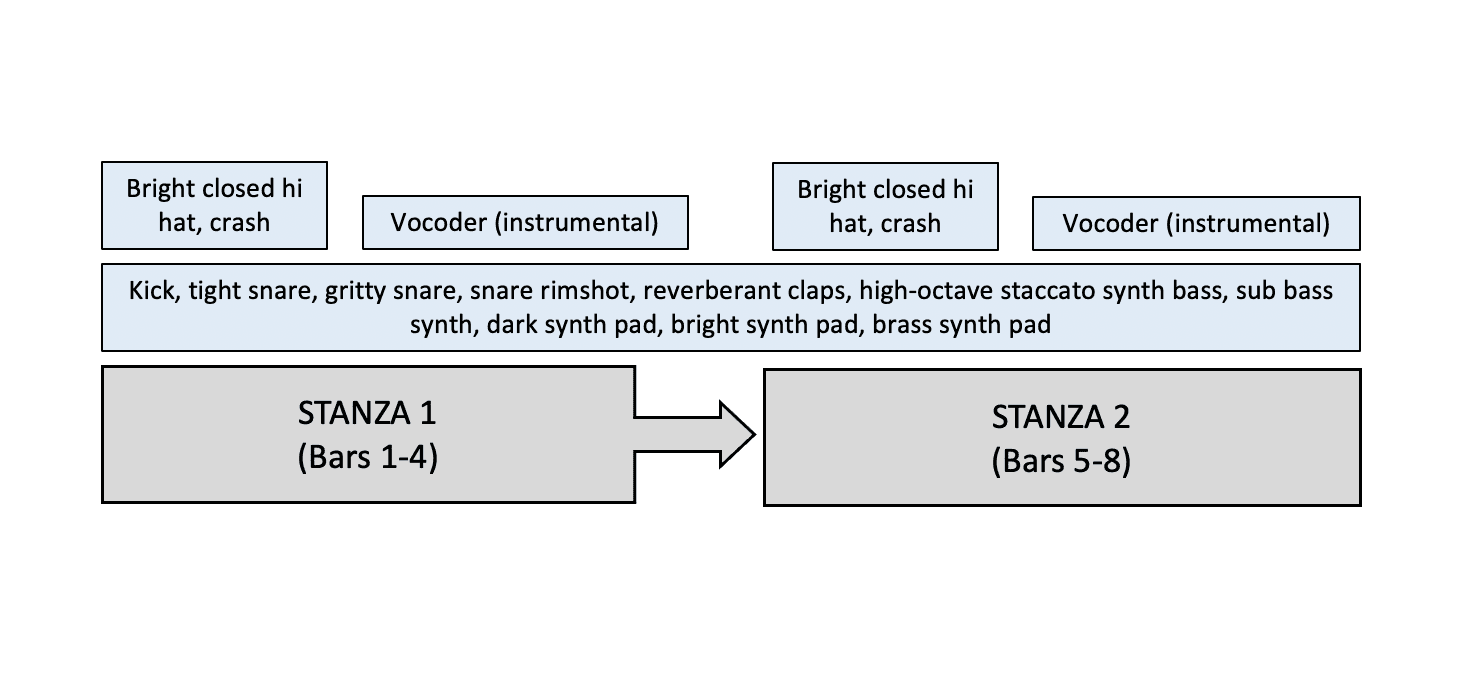

Turnaround (0:51 – 0:53)
Chord Progression: A (A major: I)
Following the dense, high-energy chorus, the brief one-bar turnaround breaks down to the sparser, lower energy intro arrangement, minus the gritty snare. This, along with the notable reverb processing and mid-range focus, creates engaging contrast that both spotlights the return of the “yeah” vocoder hook and provides room for the song to build once again in the ensuing sections.
Turnaround Arrangement: At-A-Glance
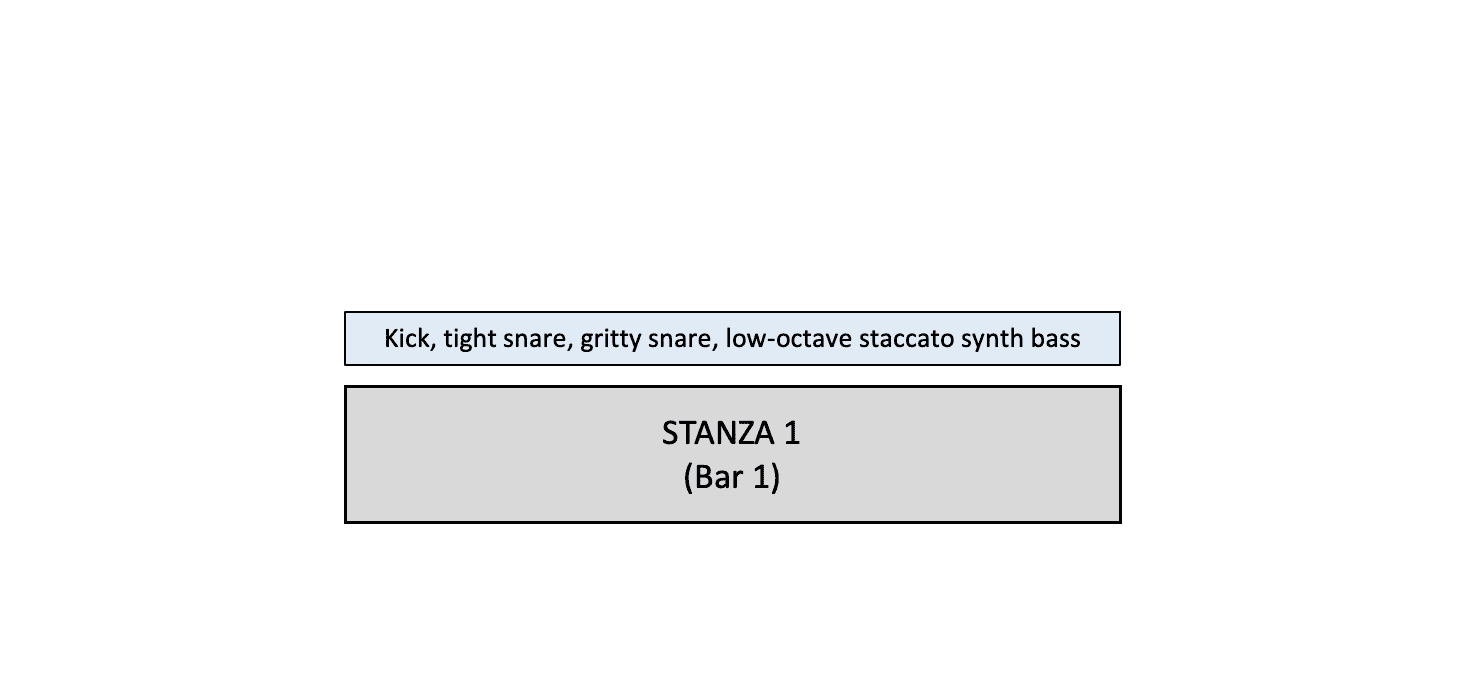

Verse 2 (0:53 – 1:05)
Chord Progression: D – E – C#m – F#m (A major: IV-V-iii-vi)
Following the brief, transitional turnaround, verse 2 engages the listener at a heightened level through a return to the core verse 1 arrangement along with new and changed up elements. Together, they serve to heighten both familiarity and interest as the song progresses.
Notable verse 2 developments:
- Brass-timbred synth stabs are uniquely added to the mix, providing engaging like-section contrast. Featured prominently in the mix, they further heighten the song’s retro 1980s vibe and create a subtly more positive mood compared to the darker-timbered verse 1.
- The dark synth pad, which was featured prominently in verse 1, is now filtered and positioned further back in the mix. This effectively makes way for the brass synth stabs and the comparative shift in mood between verses.
In the last two bars of the section, the pulsing synth and guitar return, once again heightening tension and anticipation as the verse seamlessly transitions into the pre-chorus.
Verse 2 Arrangement: At-A-Glance
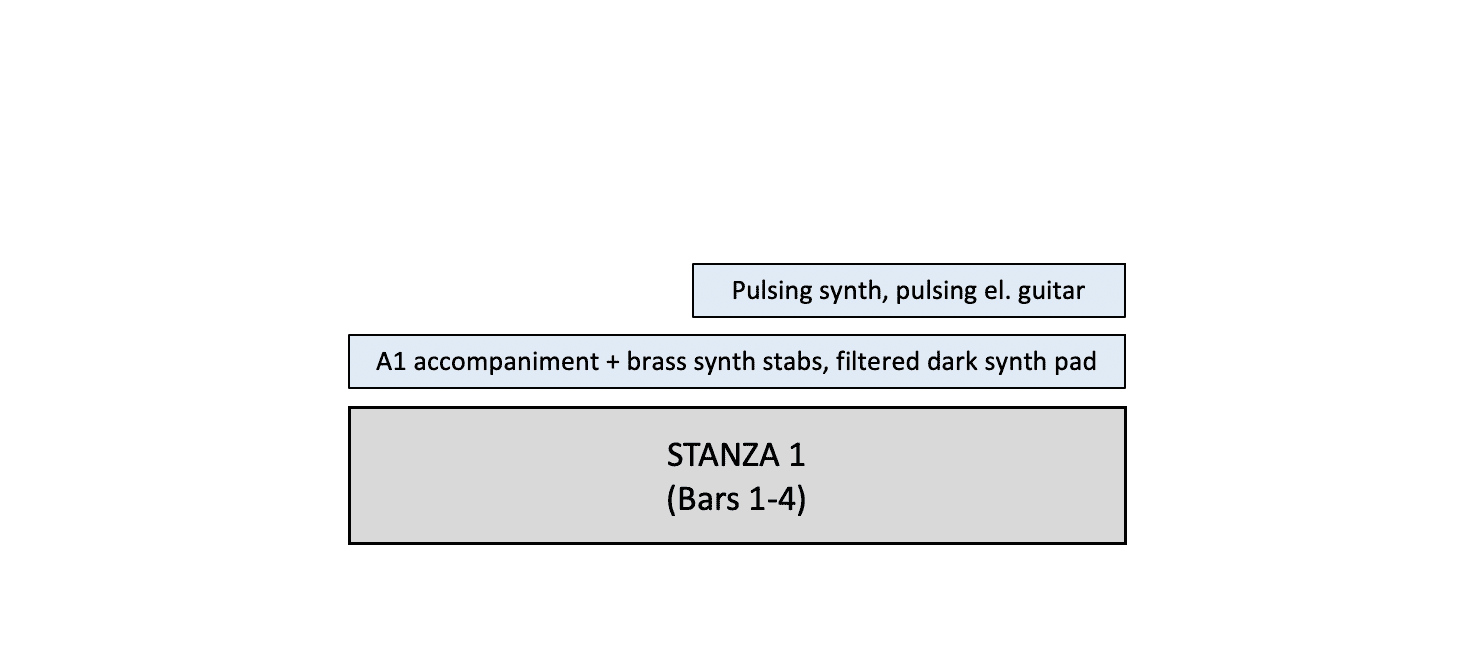

Pre-Chorus 2 (1:05 – 1:16)
Chord Progression: D – E – C#m – F#m – D – E (A major: IV-V-iii-vi-IV-V)
The verse 2 – pre-chorus 2 relationship is highly similar as the first time around, which creates structural familiarity in the scope of the song. Pre-chorus 2 initially maintains the verse 2 arrangement, creating cross-section cohesion, followed by the tension-heightening pulsing synth and guitar increasing in volume and the S.I.A. (section impact accentuator) technique being employed in the last two beats.
Here, the arrangement unfolds into the S.I.A. as follows:
- The rimshot is removed, creating a timbral shift on the backbeat.
- The remaining backbeat elements, brass synth stabs and low-octave staccato synth bass are then removed for the last two beats, further stripping back the arrangement.
- Lastly, the kick is omitted from the final beat of the section, leaving the sustained dark synth, pulsing synth and guitar, and white noise and reverse synth risers to usher in the chorus in an engaging manner.
Pre-Chorus 2 Arrangement: At-A-Glance
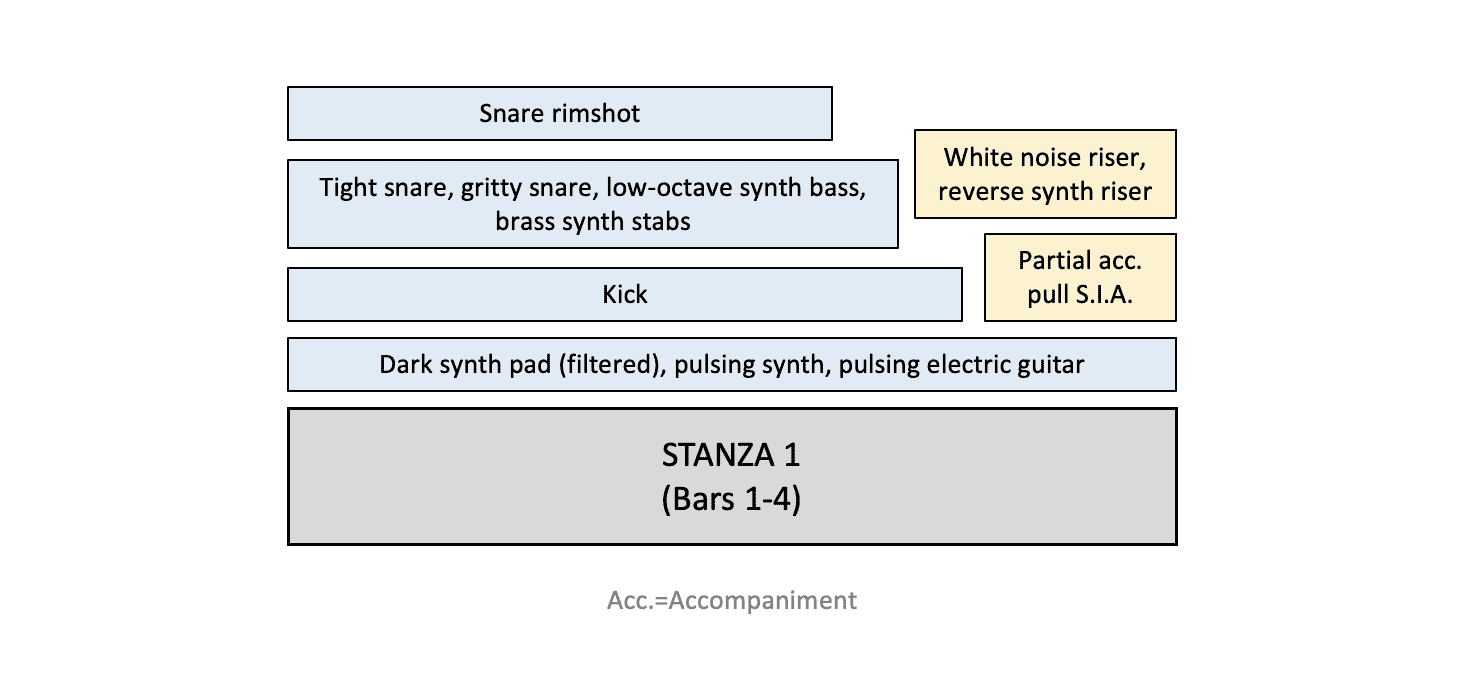

Chorus 2 (1:16 – 1:39)
Chord Progression: A – C#m – F#m – D (A major: I-iii-vi-IV)
The chorus 2 arrangement is highly similar to its chorus 1 counterpart, which bolsters the familiarity factor of the song’s primary “hook center.” However, in addition to the added vocal layers, there are two instrumental differences in the second stanza that, while subtle, contribute to density, texture, color and prevent instrumental redundancy:
- A low-level bright synth arpeggio is added to the mix. In addition to the above, it also subtly contributes to the section’s rhythmic motion.
- The synth pads swell to a more prominent level compared to the first time around. This also serves to subtly heighten the section’s excitement factor as it comes to a close.
Chorus 2 Arrangement: At-A-Glance
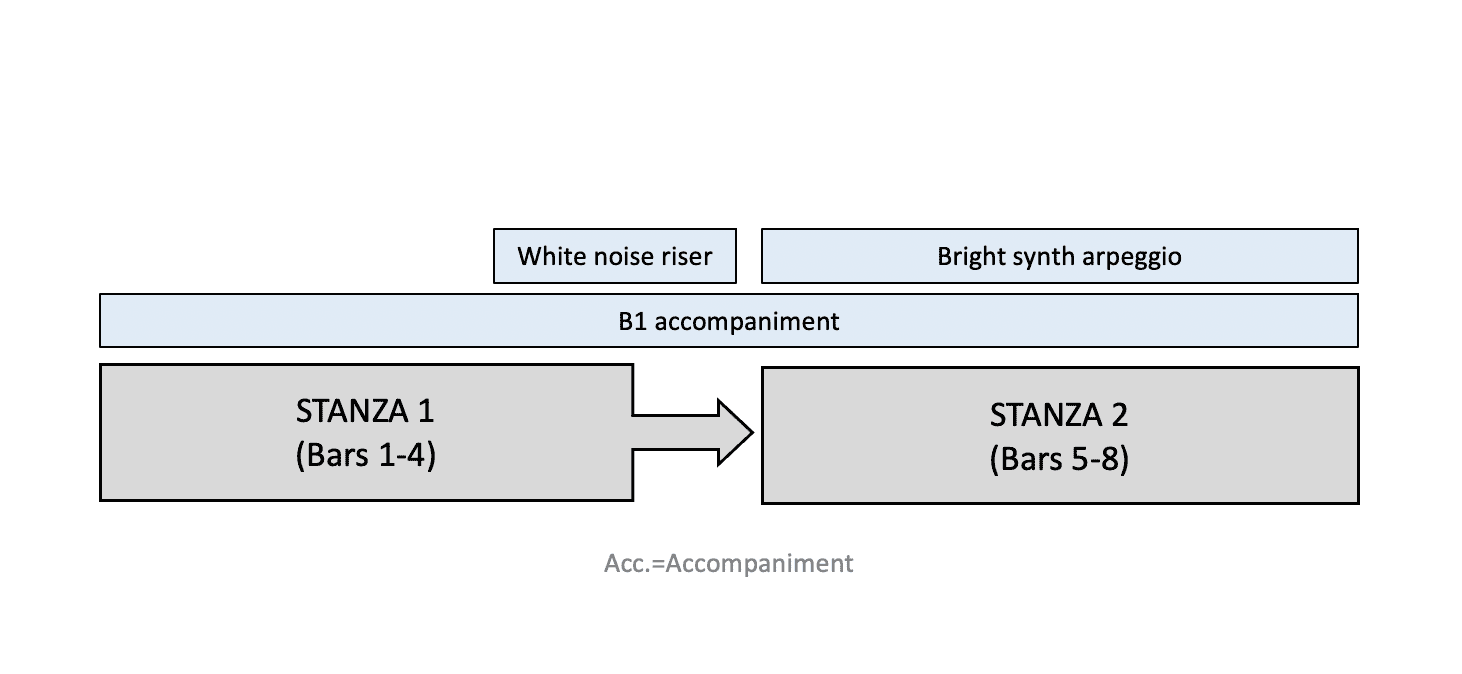

Bridge 1 (1:39 – 2:04)
Chord Progression: A – C#m7 – F#m7 – D – A – C#m7 – F#m7 – D – N.C. (A major: I-iii7-vi7-IV-I-iii7-vi7-IV-N.C.)
Bridge 1, which serves as the song’s main “D” (departure) section, provides a notable, engaging shift in the instrumental arrangement compared to the other song sections, along with changeups in vocals and lyrics.
With the core kick and snare groove from the chorus providing cross-section continuity, the mix shifts to a highly rhythmic and notably brighter (higher frequency) instrumental arrangement compared to the preceding sections that works in tandem with Swift’s more excited vocals to bolster the impact of the lyrics.
- The sub bass and synth pads are removed from the mix, leaving the high-octave staccato synth bass and bright arpeggio synth driving the section forward along with the drums.
- A high synth drone is introduced, sustaining a high note that further contributes to the section’s higher frequency focus.
- Bright closed electronic hi hat, closed acoustic hi hat, and open hi hat shift to a steady, thirty-second-note rhythm, driving the song forward with a heightened degree of momentum
In the last three bars of the section, the dark synth pad and brass synth pads are reintroduced. Together, they fill out the mid to low-end of the mix while their gradually increasing volume and cutoff frequency serve to heighten tension, anticipation and engagement leading into the final chorus of the song.
However, instead of leading directly into the chorus, the buildup is subverted by what Hit Songs Deconstructed calls the “Last Chorus Super S.I.A.” technique. Here, an extra bar is tacked onto the end of the bridge, where all the elements are removed from the mix save for Swift’s lead vocal until the last beat when a reverse synth riser ushers in the ensuing chorus. This jarring, unexpected moment notably heightens the listener’s engagement and bolsters the impact of the chorus in the process.
Bridge 1 Arrangement: At-A-Glance
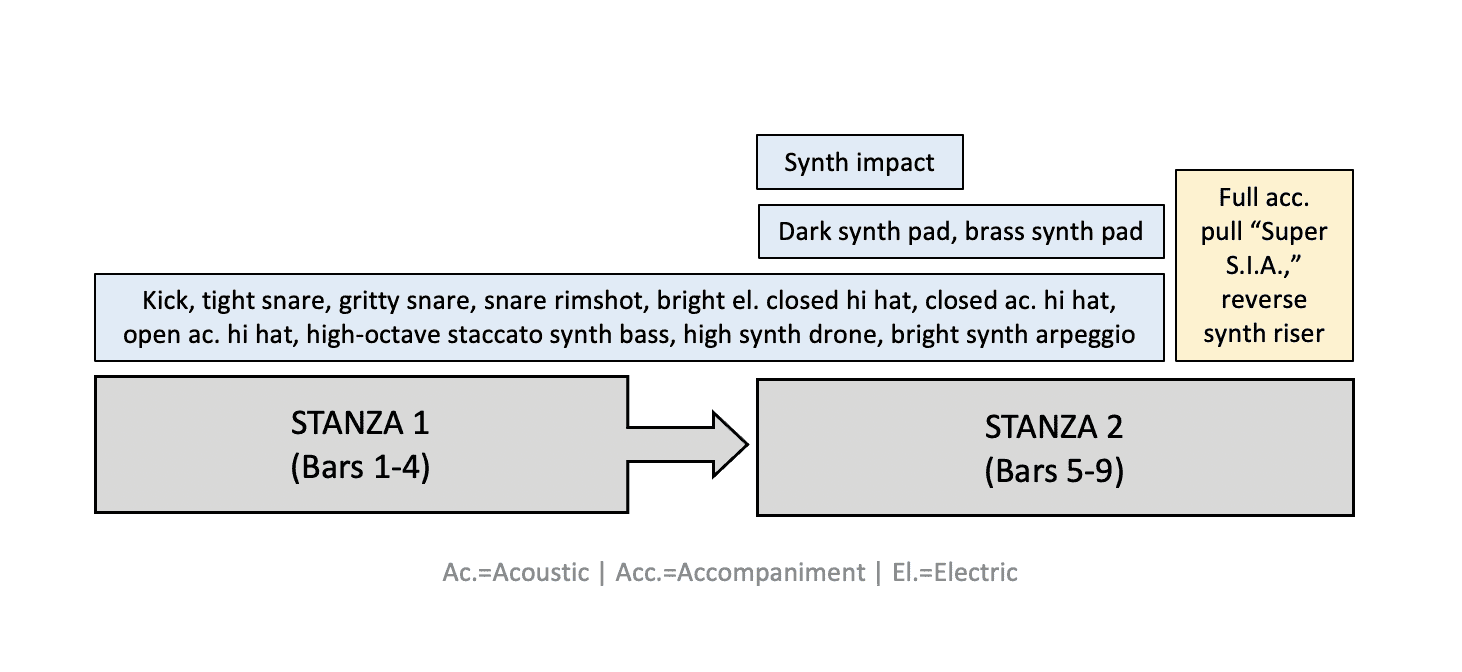

Chorus 3 (2:04 – 2:27)
Chord Progression: A – C#m – F#m – D (A major: I-iii-vi-IV)
Following the pronounced, engagement-heightening “Super S.I.A.” technique at the end of the bridge, the third and final chorus hits hard with a return to the familiar, dense arrangement that defines the second stanza of chorus 2. However, to prevent “cookie-cutter” redundancy, the synth layers feature more active rhythmic motion and have brighter timbres, which results in a subtly more excited and energetic vibe. At the end of the section, a dark closed hi hat enters to usher in the second bridge.
Chorus 3 Arrangement: At-A-Glance
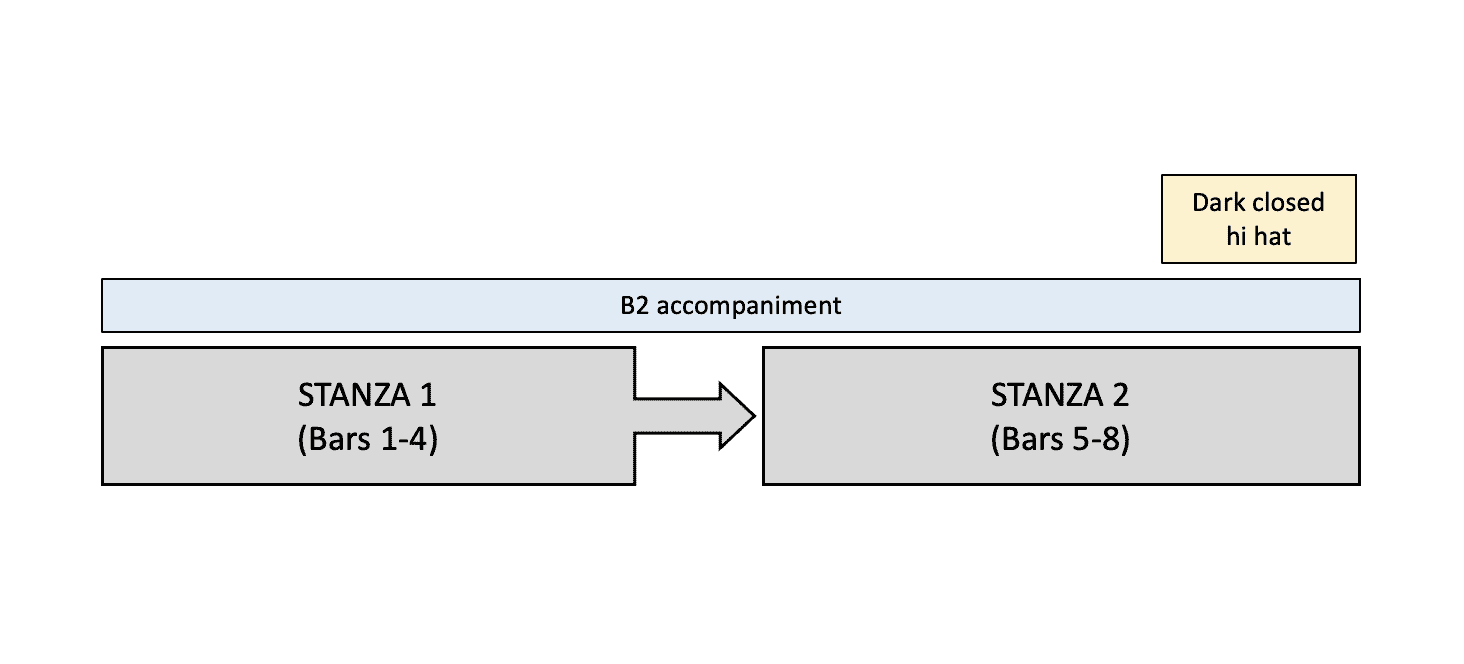

Bridge 2 (2:27 – 2:49)
Chord Progression: A – C#m7 – F#m7 – D (A major: I-iii7-vi7-IV)
The atypical second bridge uniquely fuses the bridge 1 and chorus 3 instrumental arrangements to take the song’s intensity to a grand peak. With the chorus 3 instrumental arrangement remaining in effect to provide cross-section continuity, the high frequency hi hats and high synth drone from bridge 1 are added in, which together, along with a reprise of Swift’s excited bridge 1 vocals, takes the song to an emotional climax.
At the end of the section, the last bar omits the sub bass and high-octave bass from the mix, allowing the low-octave bass to set the stage for the ensuing outro.
Bridge 2 Arrangement: At-A-Glance
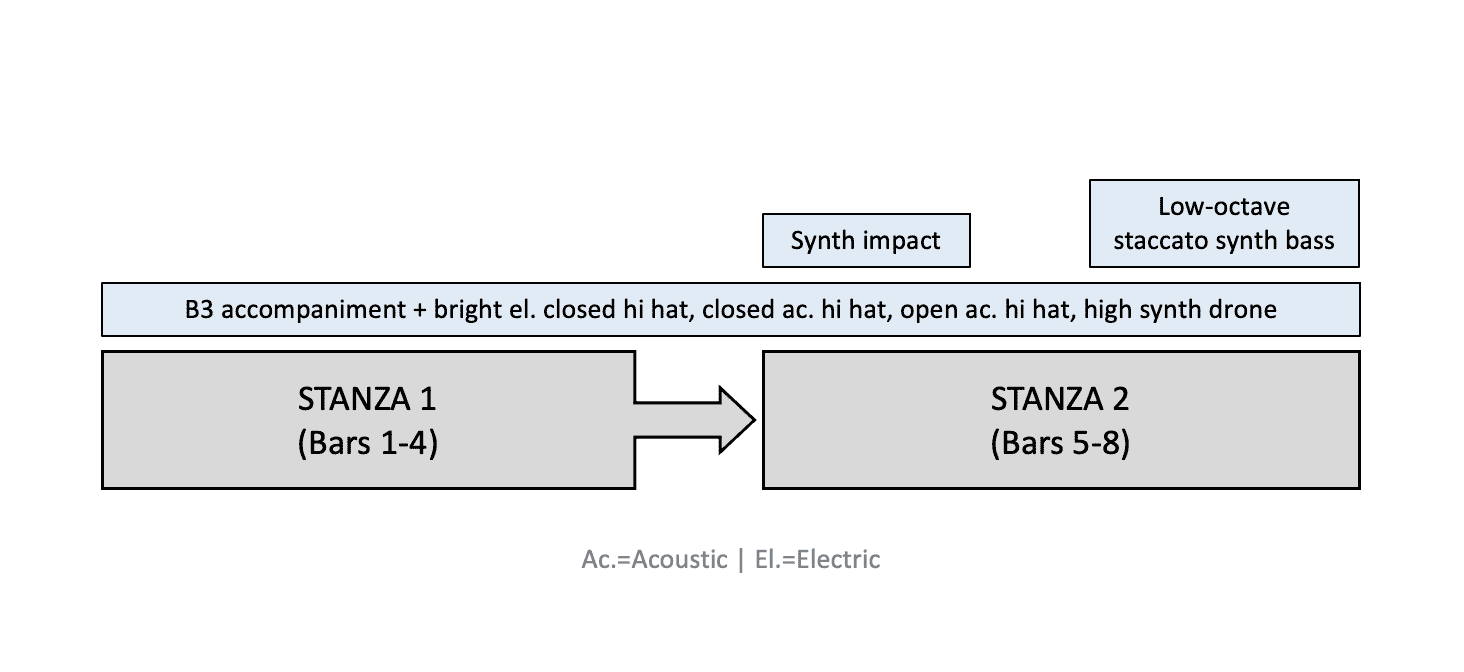

Outro (2:49 – 2:55)
Chord Progression: A (A major: I)
Following the climactic second bridge, the outro notably breaks down to just kick, tight snare, gritty snare and low-octave synth bass. This bookends the song on a familiar note while showcasing the vocoder vocal hook as the song winds down. Note, however, that compared to the similarly arranged intro and turnaround sections, the low-octave synth bass opens the cutoff filter in the last bar. This creates a sense that the outro is building toward something, but instead ends abruptly with a “pulling of the plug” quality at the tail end.
Outro Arrangement: At-A-Glance
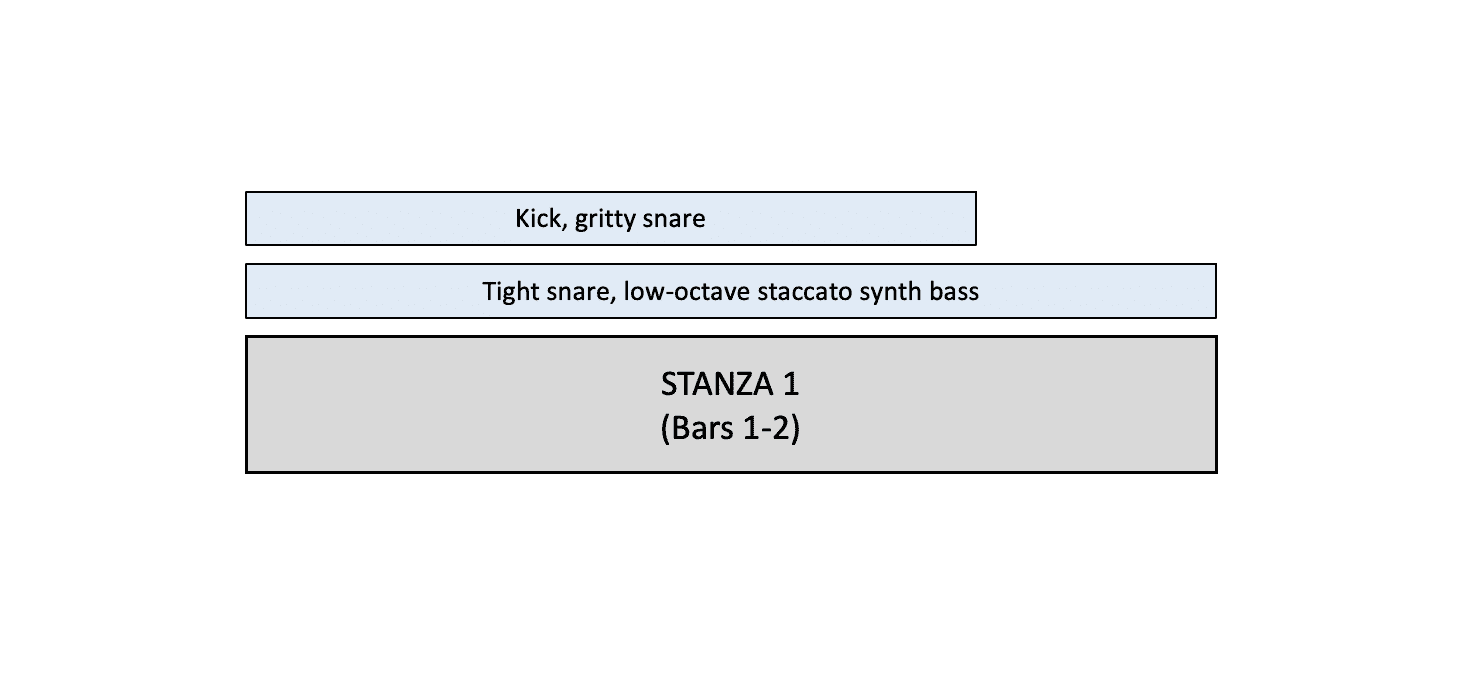

Harmonic Progressions
“Cruel Summer” features three core progressions, each with subtle variations.
Progression 1
Progression 1: Variation 1 (Intro, Turnaround, Outro)
A
The first of “Cruel Summer’s” three chord progressions is composed solely of the tonic chord, A major. Delivered through the low-octave staccato synth bass and vocoder, it is featured at three strategic points throughout the song:
- The intro, where its simplicity locks the listener into the mechanical 1980s-influenced staccato groove and provides room for harmonic growth in subsequent sections.
- The turnaround, where it harmonically “resets” the song following the first I-A-PC-B sectional progression.
- The outro, where it resolves the song on a familiar note as it draws to a close.
Progression 2
Progression 2: Variation 1 (Verses)
D – E – C#m – F#m
Progression 2: Variation 2 (Pre-Choruses)
D – E – C#m – F#m – D – E
The second progression is heard in the verses and pre-choruses, following a core D – E – C#m – F#m (IV – V – iii – vi) pattern with a slight variation in the pre-choruses. The use of subdominant, dominant and tonic tonalities create a cyclical motion that contributes to the forward motion of these sections. Also worth noting is the atypical use of the three-minor chord (C# minor), the darkest chord within the major mode; this provides these sections with an underlying dark quality, which is most notable in the first verse along with the dark-timbred synth pad.
The pre-choruses change things up the last two bars by elongating each chord across a full bar to heighten tension leading into the ensuing chorus. This tension is further bolstered by the use of the dominant V chord (E major), leaving the listener in suspense before the cadential resolution to the I chord (A major) in the subsequent chorus.
Progression 3
Progression 3: Variation 1 (Choruses)
A – C#m – F#m – D
Progression 3: Variation 2 (Bridges)
A – C#m7 – F#m7 – D – A – C#m7 – F#m7 – D – N.C.
The third progression in “Cruel Summer” is heard in the choruses and bridges, following a core A – C#m – F#m – D (I – iii – vi – IV) progression with subtle variation in the bridges. Following the sustained V chord in the preceding pre-chorus, the chorus progression begins on the resolved root, helping to punctuate the climactic section’s arrival. It then moves to the three-minor chord (C# minor), maintaining the tonic tonality in a dark, engaging manner before brightening slightly on the more typical six-minor chord (F# minor). The chorus progression then concludes on the four-major chord (D major), ending with a subdominant tonality that subtly heightens tension before the subsequent resolution to the root (A major) in the repeated progression or turnaround, bridge and outro sections. This IV-I resolution to the tonic chord is known as a plagal or “Amen” cadence, commonly found in gospel and jazz music as well as contemporary hits (Toosii’s “Favorite Song,” Florida Georgia Line and Bebe Rexha’s “Meant To Be” and Olivia Rodrigo’s “Vampire” are prime examples).
The bridge features a subtle variation from this core progression, employing sevenths on the C# minor (iii) and F# minor (vi) chords to heighten tension.
Vocals
Vocal Production
Lead Vocal Gender
“Cruel Summer” features a solo female lead vocal from Taylor Swift. In the first half of 2023, solo male leads were by far most common among non-hip hop hits at half of all songs, followed distantly by solo female leads at just 17%.
Lead Vocal Gender in the Hot 100 Top 10 (Non-Hip Hop Hits): 2018 – Q2 2023


Lead Vocal Delivery
“Cruel Summer” features an almost entirely sung vocal delivery, save for a few sung/shouted hybrid deliveries in the bridge sections. Despite exclusively sung deliveries continuing to be by far most common among non-hip hop hits, they have been in decline since 2020 while sung/rapped combo deliveries have been on the rise.
Lead Vocal Delivery in the Hot 100 Top 10 (Non-Hip Hop Hits): 2018 – Q2 2023
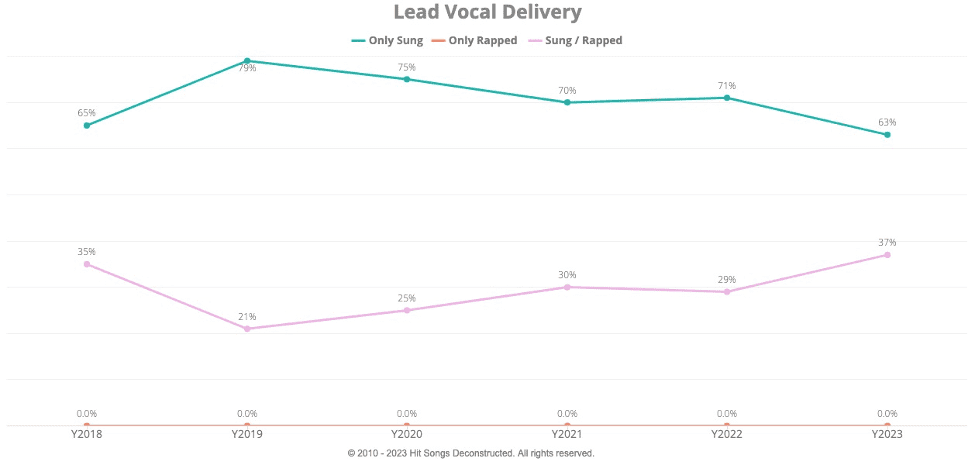

Background Vocals
Complementing Swift’s lead are an array of background vocals including unison doubles, octave doubles, above and below the lead harmonies, independent of the lead adlibs, and sustained vocal pads. Together, they serve to heighten interest throughout the song and call attention to key lyrics.
Effects & Processing
“Cruel Summer” features common hit song vocal processing, including reverb, compression, and subtle autotune to heighten the effectiveness of the vocal performance. In addition, a vocoder is used in both a lead and background capacity to provide vocal texture variation and create one of the song’s notable hooks.
Vocal Production Visualization Key
Lead: Female (Taylor Swift): Taylor Swift’s lead vocal
BGV 1: Female (Unison Double): Background vocal doubles in unison with the lead
BGV 2: Female (High Octave Double): Background vocal doubles an octave above the lead
BGV 3: Female (Low Octave Double): Background vocal doubles an octave below the lead
BGV 4: Female (Lead Harmony) (Above): Background vocals that harmonize with the lead on different pitches above the melody
BGV 5: Female (Lead Harmony) (Below): Background vocals that harmonize with the lead on different pitches below the melody
BGV 6: Female (Adlibs): Background vocals featured independently from the lead
BGV 7: Female (BGV Pad): Multiple background vocals stacked and sustained to create a pad-like effect
Vocoder: Vocoder vocal hook independent from all vocals, functions in a background and lead capacity
S: Sung
SH: Shouted
BGV: Background vocals
Underlined Lyrics: Denotes unison and octave doubles with the lead; one underline denotes unison double(s), and double underlines denote additional octave double(s)
Color-Coded Lyrics: Denotes lyrics sung in unison/octaves with the lead (light green), in harmony with the lead (dark green), independent of the lead (orange), and the vocoder layer (blue). Note that this matches the color-coding of the above vocal arrangement overview table.
Vocal Delivery Arrangement Overview


Verse 1


Verse 1 introduces Swift’s lead vocal into the mix, which is positioned up the middle and processed with compression to help punctuate its presence.
Complementing it are the “oh yeah, you’re right, I want it” background vocals at the end of each line. Panned to the right, featured lower in the mix, and processed with vocoder, these vocals serve as catchy “nano hook” responses to Swift’s lead while maintaining vocal cohesion with the intro.
Pre-Chorus 1


Pre-chorus 1 continues with the same lead vocal characteristics as the preceding verse, maintaining cross-section continuity and cohesion. The sole changeup occurs in line 2 with the addition of a high-octave double, which serves a few key purposes: It prevents Swift’s lower-register lead from becoming too buried and losing its impact, calls further attention to the lyric, and heightens interest leading into the developed melody and lyrics in lines 3 and 4. Note that an important reason for omitting the double on these lines was to enable the more vocally robust chorus to stand out in comparison.
Chorus 1
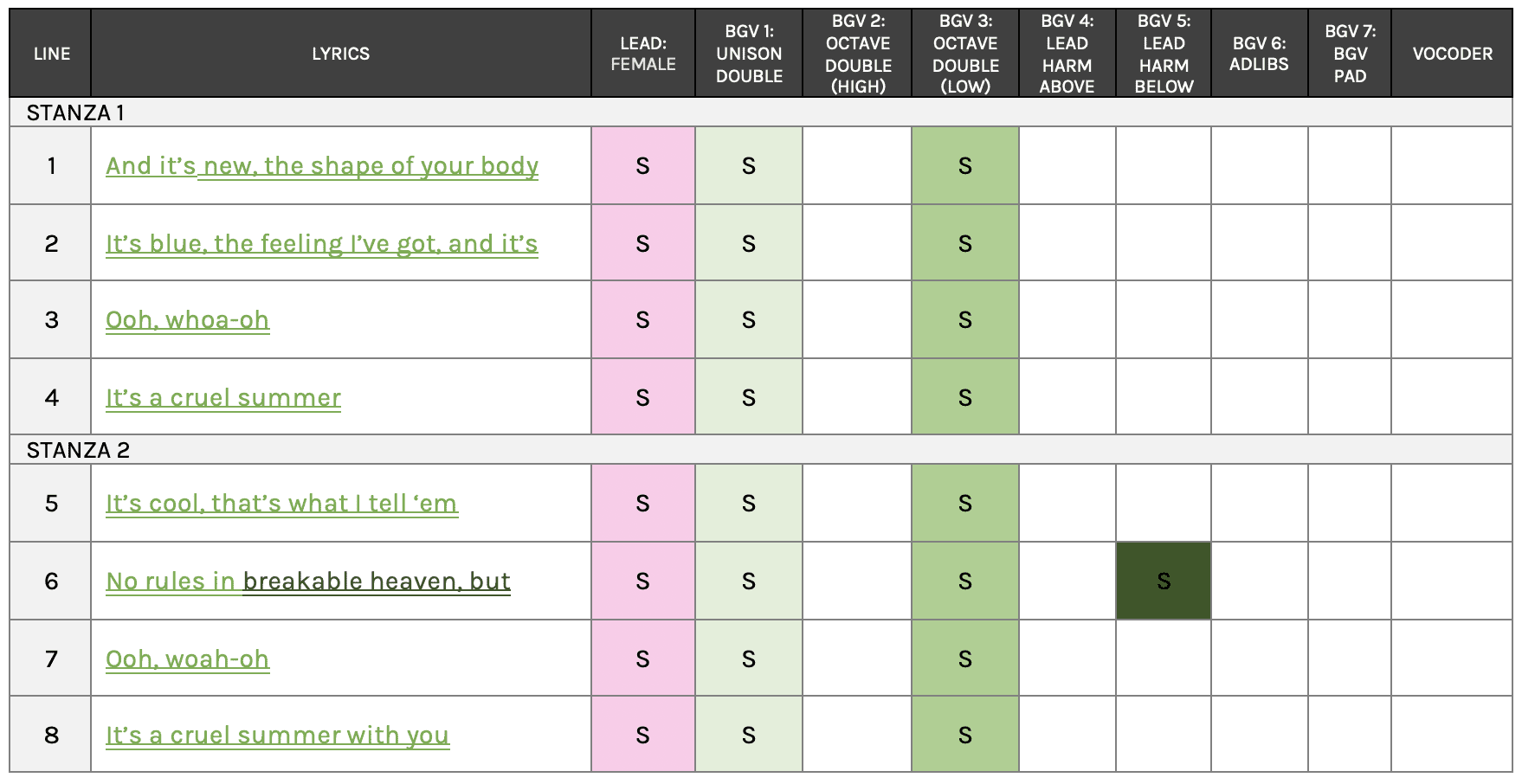

Following Swift’s mainly solo lead performance in the verse and pre-chorus, the chorus introduces unison and low-octave doubles, which are featured throughout the section. This vocal development serves a few key purposes:
- The unison double bolsters the presence of Swift’s soaring, impassioned vocal and enables it to further cut through the mix. Without it, the thinner vocal quality could reduce the section’s emotional impact.
- The low-octave double provides her vocal with more weight and maintains range continuity coming out of the lower-register pre-chorus.
- The vocal layering jibes with the “wall of sound” synths to create a notably denser arrangement that both complements the lyrics and enables the chorus to further stand out against the preceding sections.
In addition, the decision to include unison and octave doubles as opposed to multi-pitch harmony throughout the chorus provides room for vocal production growth in subsequent sections.
However, similar to the pre-chorus, there is one line in the section that features a more developed vocal compared to the others. Here, it occurs in line 6 on the vocal fragment, “breakable heaven, but,” which features harmony above the lead for the first time in the song (as opposed to a double). This seemingly minor development is important for a few key reasons:
- It calls attention to the chorus’ most clever, standout lyric.
- It subtly heightens interest within the otherwise stagnant lead vocal qualities of the two-stanza section.
- It enables the ensuing catchy nonsense lyric to further standout in comparison, which doesn’t feature the layer.
Turnaround


Following the chorus, the brief turnaround reverts to the vocoder processed “yeah” from the intro. However, compared to the intro, here it is featured at a lower level in the mix and processed with a greater degree of reverb. This provides it with a less direct quality which, along with the thinned-out arrangement, allows the more direct verse that follows to enter with increased perceived impact while subtly reinforcing the hook in the listener’s mind.
Verse 2


The first line in verse 2 features the same lead and background (vocoder) vocal production qualities as its verse 1 counterpart. This creates like-section familiarity that allows the listener to more easily connect with the section and have their full attention on the narrative development. However, to help heighten interest both on a like-section and cross-section basis, harmonizing vocals are uniquely added above the lead in line 2.
In addition, another vocal layer an octave above the lead is added on the lyric “we’re not trying” in line 2, which serves to further interest with the subtle burst of color it provides.
Pre-Chorus 2


Pre-chorus 2 features nearly identical vocal production qualities as its pre-chorus 1 counterpart. This helps to provide like-section cohesion against the atypical pre-chorus lyrical changeups (most hit songs feature the same pre-chorus lyrics across iterations). The sole exception is a greater use of delay in line 3, which provides a subtly engaging like-section development on the only lyrically identical line in the section.
Chorus 2
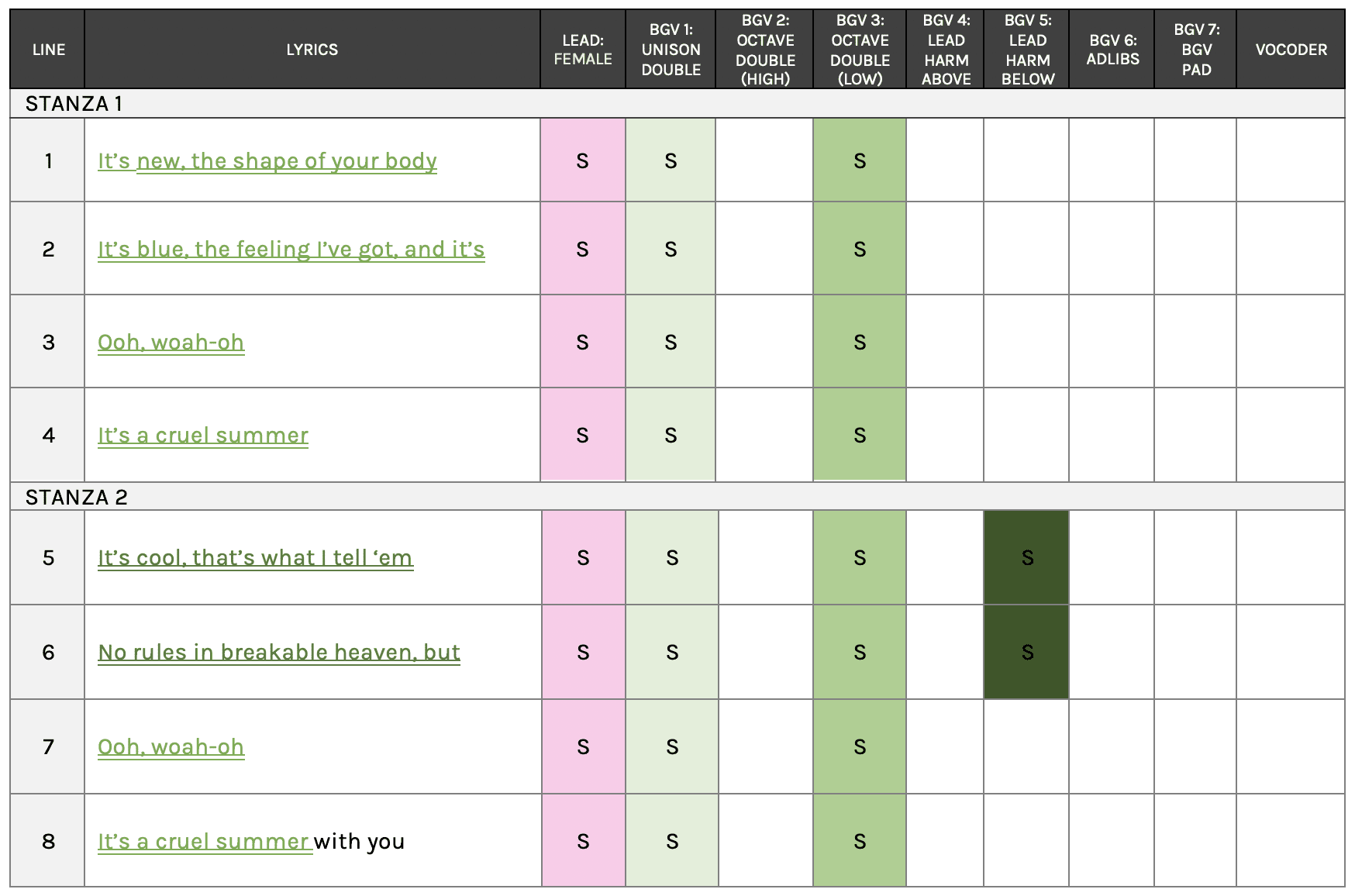

Chorus 2 features the same vocal qualities as its chorus 1 counterpart, with one exception: The low lead harmony is featured across lines 5 and 6 as opposed to just line 6. This serves to heighten interest at the top of the second stanza while maintaining vocal production cohesion with chorus 1.
Bridge 1
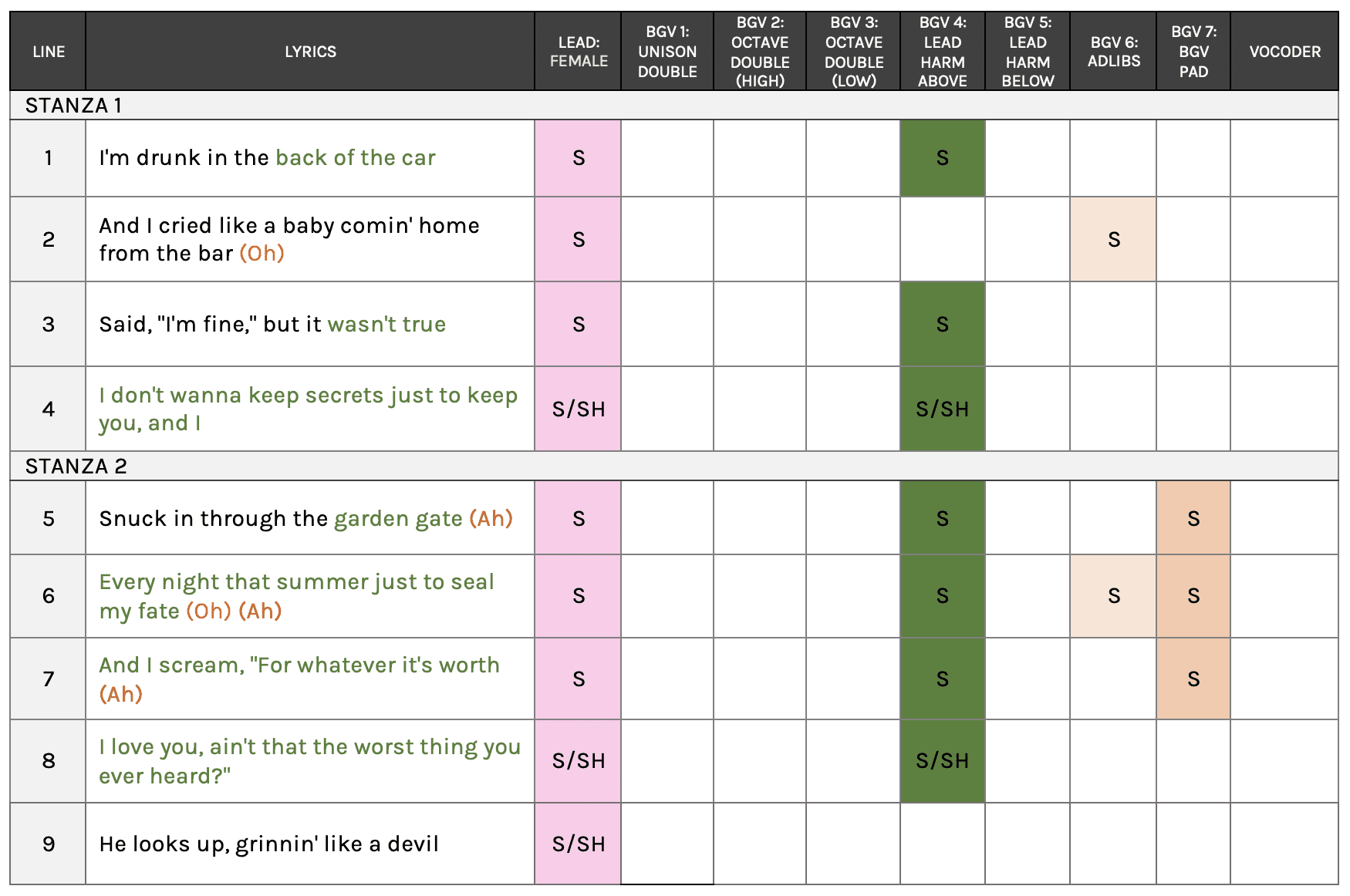

The two-stanza, bridge 1 “D” (departure) section features unique vocal production characteristics that, along with the melodic, lyrical and instrumental arrangement changeups, serves to notably heighten listener interest and engagement in the scope of the song.
Stanza 1
While the first line of the bridge begins in a similar manner as the verses with a solo lead vocal across the lyrics “I’m drunk in the,” it is followed by harmony above the lead on the lyric “back of the car,” which provides a burst of engaging color and excitement. This same solo/harmonized technique is then employed in line 3, which creates structural familiarity within the stanza.
Sandwiched between them is line 2, which is entirely devoid of lead vocal layers. Along with heightening line-to-line interest, this decision allows the first adlib heard in the song, the high-register, multi-layered “oh” at the end of the line, to further stand out in comparison.
The stanza concludes with the first instance of a high-register sung/shouted hybrid vocal, which is accompanied by a similar harmonized background vocal. Along with notably heightening engagement at the end of the stanza, it also serves to highlight the all-important lyric, “I don't wanna keep secrets just to keep you.”
Stanza 2
Line 5 at the top of stanza 2 begins in similar fashion as stanza 1. However, instead of adding and removing the high harmony throughout, it maintains it across lines 6-8, which creates a heightened sense of excitement, intensity, and cross-stanza interest. Also contributing to this are low-level sustained vocal “ah’s” that provide a pad-like texture that pairs perfectly with the synths.
All of the layers are then abruptly removed in line 9, along with the full instrumental arrangement. Filling this void is the unique sung/shouted, “He looks up, grinnin' like a devil,” which is processed with copious reverb. Together, these qualities serve to emphasize the standout lyric and enable the dense chorus that follows to hit with increased perceived impact (reference the “Super S.I.A. technique” in the Instrumental Arrangement and Energy sections of the report).
Chorus 3
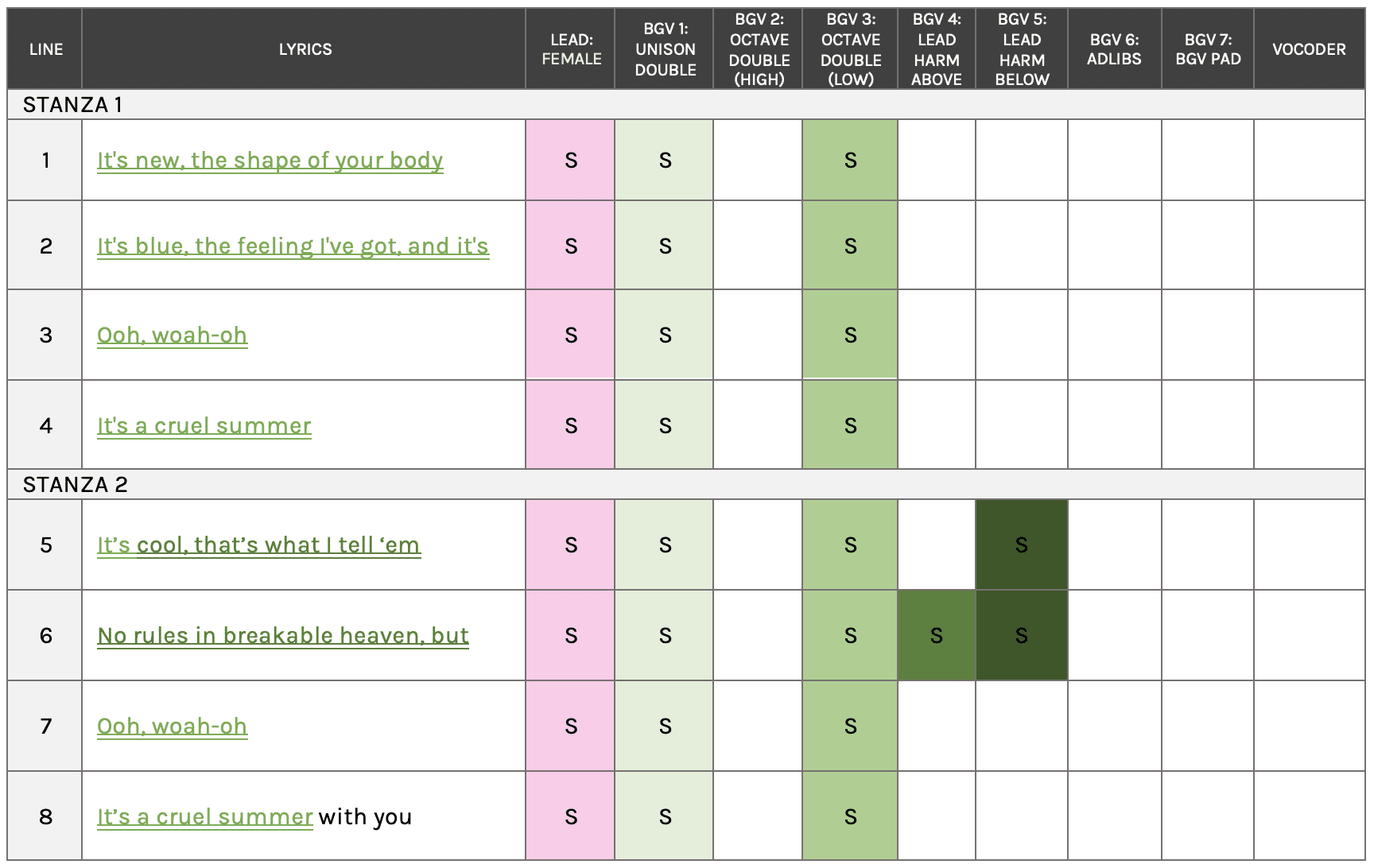

The third and final chorus in the song features highly similar vocal production characteristics as its chorus 2 counterpart. The two subtle differences, which most likely go unnoticed by the average listener, are Swift’s slightly more present performance and the brief high harmony layer included on the lyric “no” in line 6.
Bridge 2
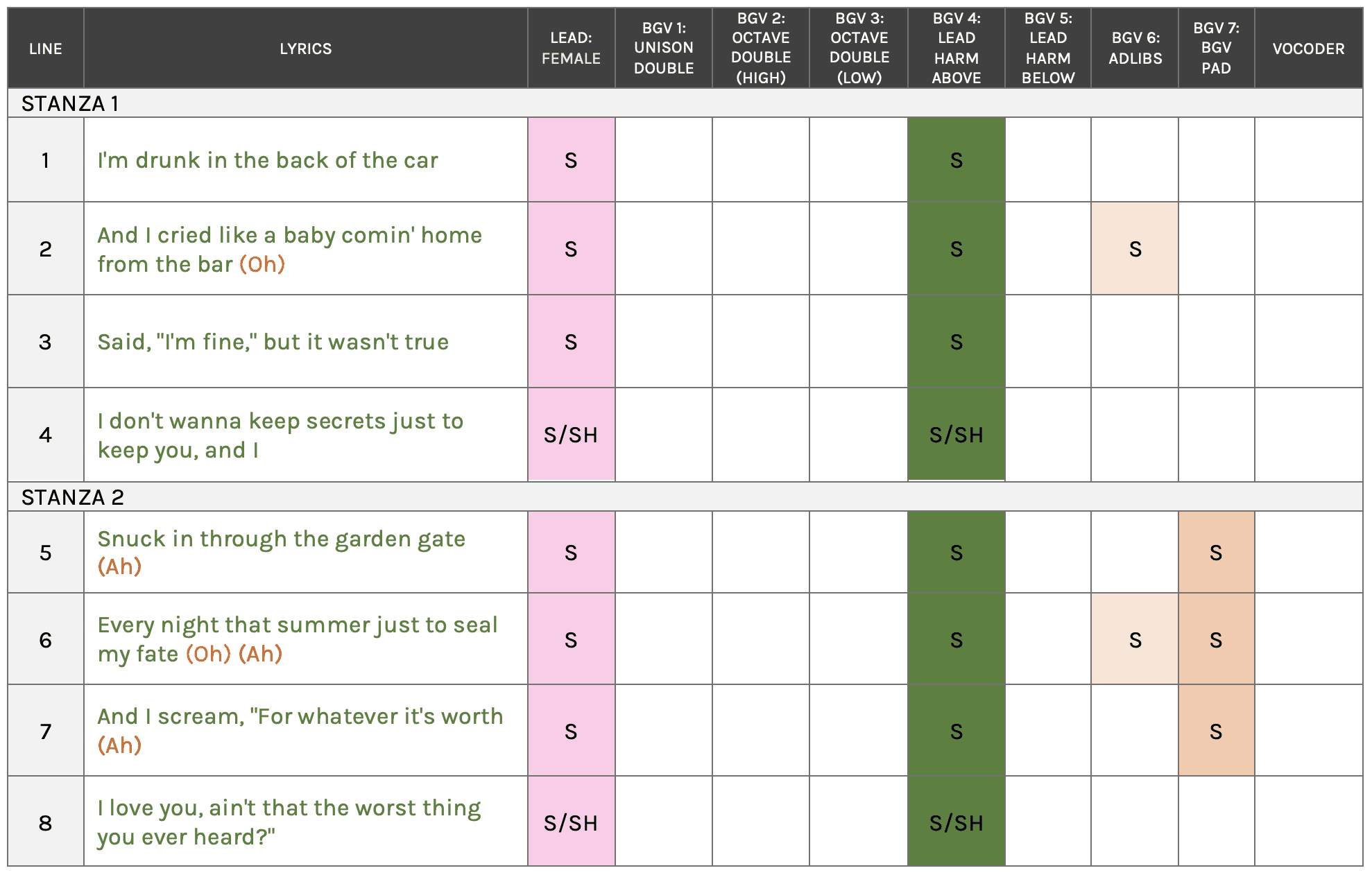

The bridge 2 vocal production is largely similar to its bridge 1 counterpart save for the lead harmony being featured throughout. This, along with the denser instrumental arrangement, takes the song’s excitement and intensity to a grand peak before heading into the brief outro.
Outro


The outro returns to the sparse vocoder qualities of the intro and turnaround. Here, it is processed with more reverb than the intro (like the turnaround), which enables the piercing synth to take front and center while the song concludes on a familiar and engaging note.
Vocal Melody


Key
Section Focus
This section of the report focuses on lead vocal melody. For details on background vocals, please refer to the Vocal Production section of the report.
Part Graphs
Graphs: Reflect Lead vocals (excludes harmony)
Numbers in the graphs: Depict the scale degree of each note
Curved Line: Slur across two or more pitches
Vocal Melody Part Classifications
Main melodic parts, such as upper-case A,B and C, reflect the main melodic structure of each line in a song section.
Sub-melodic parts, such as lower-case a, b, c, reflect melodic structure both within and across lines.
The vocal melody part classifications in each section are specific to that particular section type (i.e., verses, pre-choruses, etc.) and do not relate to other section types (i.e., part A classification in verse 1 does not relate to part A in the chorus, but part A in verse 1 does relate to part A in verse 2).
Vocal melody parts are determined by pitches, rhythms, and melodic pattern commonalities.
Intro & Outro
The first and last vocal heard in “Cruel Summer” is the highly simple “yeah,” which is repeated four consecutive times. Situated on the root and delivered with a quarter-note rhythm broken up by quarter rests, it establishes the song’s key (A major), contributes to the steady groove, and serves as an instantly identifiable hook with its vocoder processing at the top of the song.
The vocal is then subsequently reinforced in a more subtle, background manner in the turnaround before returning more prominently in the outro, concluding the song on a familiar and catchy note.
Intro & Outro Melodic Part Structure: At-A-Glance






Verses
Overview
Swift’s lead melody in “Cruel Summer’s” verses largely adheres to Hit Songs Deconstructed’s K.I.S.S. ME principle (keep it simple, singable and memorable). Among their K.I.S.S. ME qualities are the limited range of a major second, mainly stagnant motion, and simple eighth and sixteenth note-driven rhythms. These qualities enable the listener to easily connect with both installments of the narrative while their directness bolsters the emotional impact of the lyrics.
The sole deviation from the K.I.S.S. ME principle is the verse’s lengthy lines, which land between 14 and 22 syllables. However, this is offset by subtle rhythmic segmentation that makes them easier to digest.
Note that while both verses are very similar, they possess subtle melodic and rhythmic differences that are necessary to accommodate lyrical changeups and prevent “cookie-cutter” redundancy.
Melodic Structure Overview & Detail
Verse 1 Melodic Direction: At-A-Glance


Verse 2 Melodic Direction: At-A-Glance


Intro & Outro Melodic Direction: At-A-Glance


Verse 1 Melodic Part Structure: At-A-Glance


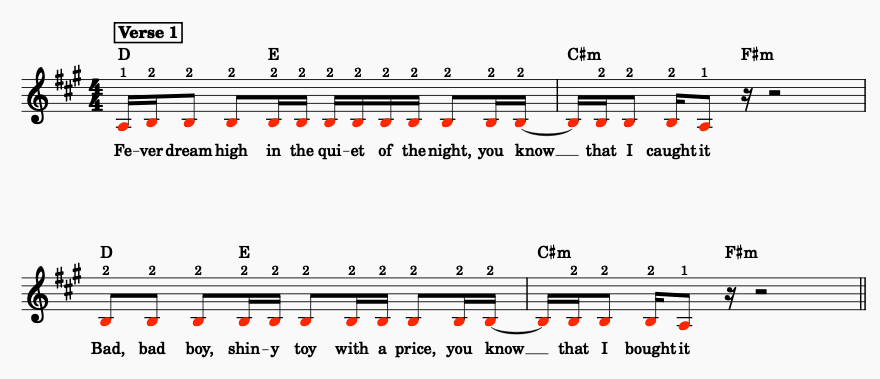

Verse 2 Melodic Part Structure: At-A-Glance


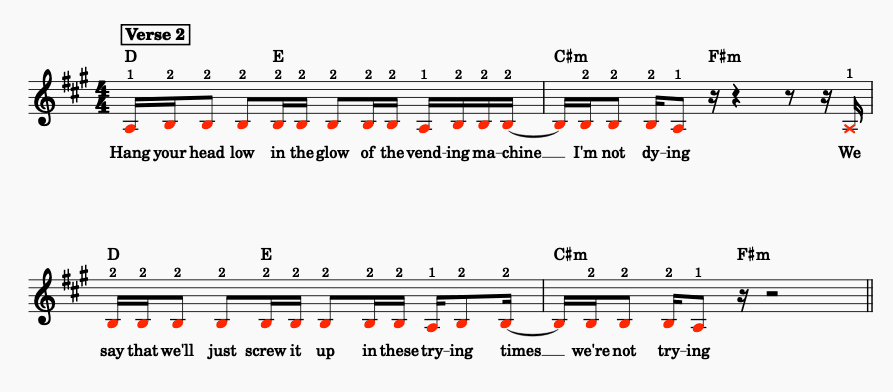

Melodic Structure Detail
*Note that all images and analysis shown below pertains to verse 1 unless otherwise noted. Differences between verses 1 and 2, if any, are detailed in each line grouping’s analysis.
Lines 1 & 2






Line 1
Part a1: Fe-ver dream high in the qui-et of the night
Part a2: You know that I caught it
Line 1, the song’s true opening line following the intro’s vocoder-processed “yeah’s,” is composed of subparts a1 and a2. Both consist of simple eighth and sixteenth note-driven patterns mainly situated on scale degree 2, which result in a forward-moving, subtly tense melody. Subpart a2 then resolves the melody with a step down to scale degree 1 at the very end.
While the line is relatively lengthy at 17 syllables, the strategic interspersion of eighth notes against sixteenths create subtle segmentation that makes the full line easier to connect with and digest:
- “Fe-ver dream high / in the qui-et of the night / you know that I caught it.”
Note, however, that the segmentation is most notable between the lyrics “night” and “you.” This is both due to the perceived lyrical phrase segmentation (i.e., “Fe-ver dream high in the qui-et of the night / you know that I caught it”) and the fact that the subpart a2’s repeat identically across lines while the preceding a1 and a3 segments vary slightly.
In addition, note that the directness of the melody creates effective prosody with the lyric to heighten the all-important opening line’s emotional impact and set the stage for what comes next.
Line 2
Part a3:
Bad, bad boy, shin-y toy with a price
Part a2:
You know that I bought it
Line 2 is composed of subparts a3 and a2. Highly similar to line 1, subpart a3 varies the rhythm and starting pitch slightly to accommodate the lyrics and prevent “cookie cutter” redundancy, while the subpart a2 repetition heightens cross-line cohesion.
Pre-Choruses
Overview
Following the largely stagnant, lengthy, repetitive verse melodies, the pre-choruses provide engaging cross-section contrast through the incorporation of non-K.I.S.S. ME qualities including a notably wider melodic range (an octave as opposed to a major second), more melodic variation and large intervallic leaps.
Balancing the deviations from the K.I.S.S. ME principle are their shorter melodic segments created by rests; simple, easy-to-lock into rhythms; ample repetition; and each melody predominantly focused within a limited range, despite their notable leaps. These qualities ensure that the listener still easily connects while simultaneously focusing attention and heightening engagement leading into the ensuing chorus.
Melodic Structure Overview & Detail
Pre-Chorus Melodic Direction: At-A-Glance


Verse 1 Melodic Direction: At-A-Glance


Verse 2 Melodic Direction: At-A-Glance


Intro & Outro Melodic Direction: At-A-Glance


Pre-Chorus Melodic Part Structure: At-A-Glance


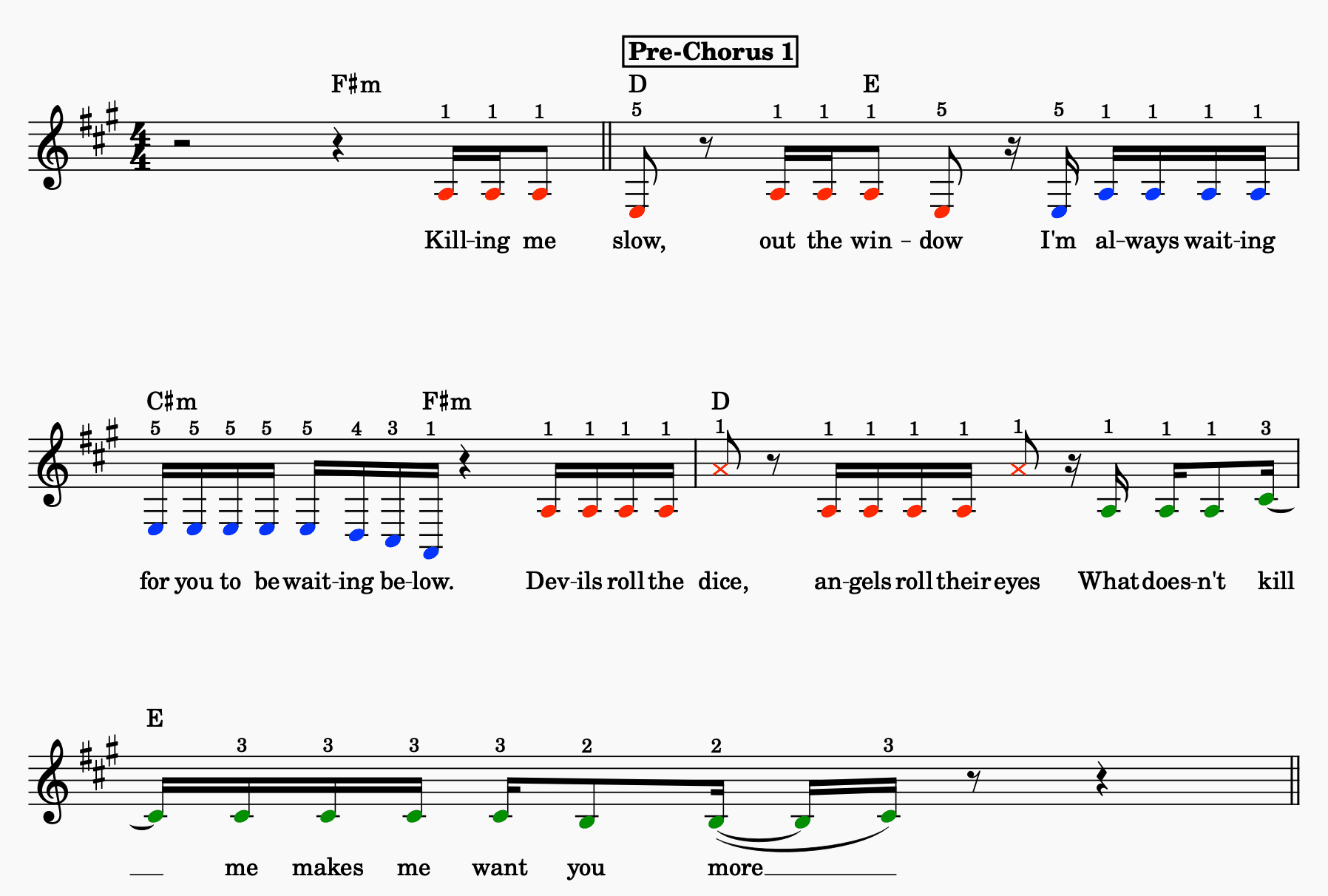

Melodic Structure Detail
Lines 1 & 2




Line 1
Part a1: Kill-ing me slow
Part a1: Out the win-dow
Line 1 is composed of two back-to-back occurrences of subpart a1, separated by an eighth rest. Picking up where the verses leave off, both feature simple, short, repetitive patterns centered on the root before concluding with a drop to scale degree 5. Together, they provide engaging contrast against the longer, continuous flow of the verses and help to set up the impending chorus in the process.
Furthermore, note that the descending leap of a fourth at the end of each segment serves to bolster the rhyme connection between “slow” and “win-DOW” along with heightening melodic interest.
Line 2
Part b1:
I'm al-ways wait-ing for you to be wait-ing be-low
Line 2 is composed of subpart b1. Picking up where line 1 leaves off on scale degree 5, it leaps back up to a repeated pattern on the root before dropping back down to scale degree 5, where it remains until the 4-3-1 descent at the end, which is the lowest melodic point in the song. Note that this descent also creates effective prosody with the downward-focused lyric, “waiting below.”
While this line is notably longer than line 1 and doesn’t possess any segmentation, its consistent sixteenth note-driven rhythm and simplistic melody imparts a roll-off-the-tongue quality that still easily connects with the listener while creating engaging contrast against line 1.
Lines 3 & 4


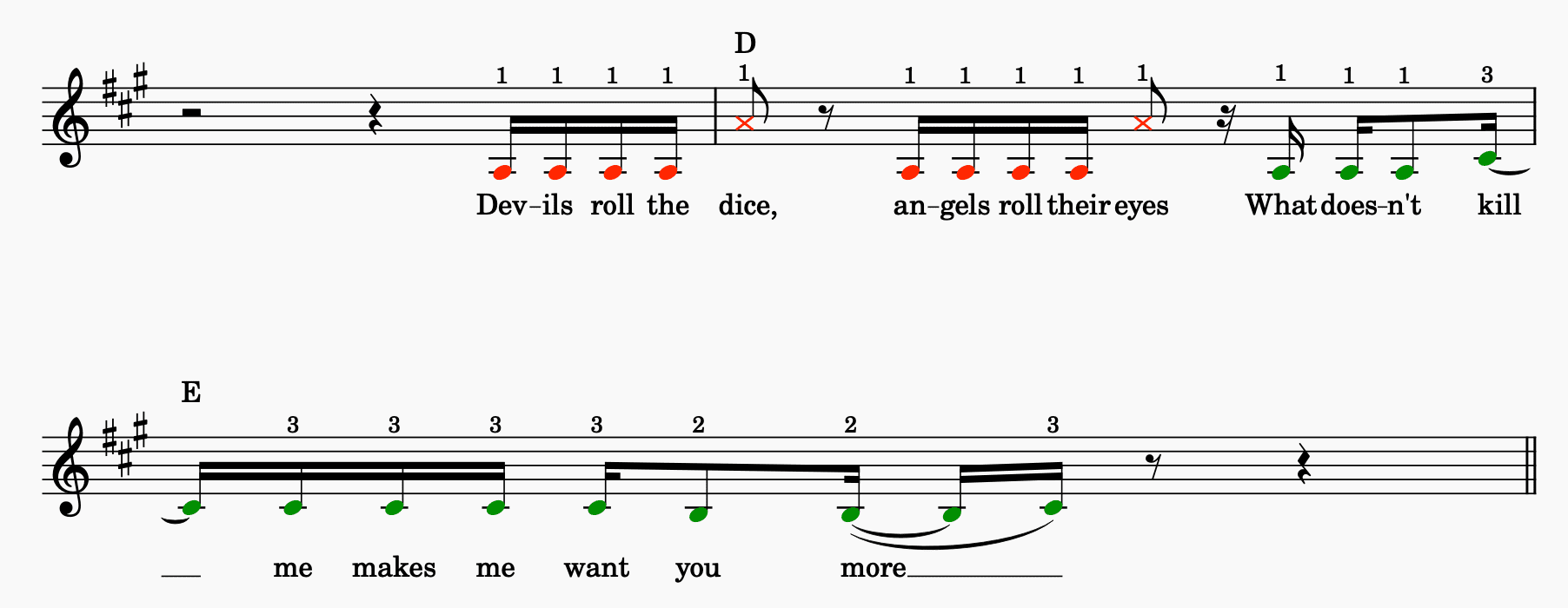

Line 3
Part a2: Dev-ils roll the dice
Part a2: An-gels roll their eyes
Line 3 is composed of subpart a2. While it begins in the same manner as its line 1 counterpart with repeated sixteenth notes on the root, instead of concluding with a leap down a fourth to scale degree 5, it instead leaps up an octave. This effective balance of repetition and contrast heightens both memorability and interest while further heightening excitement and anticipation for the impending chorus.
In addition, as is the case in line 1, the leaps serve to bolster the rhyme connection of the lyrics, “dice” and “eyes,” and call attention to the intriguing lyrical development.
Line 4
Part c:
What does-n’t kill me makes me want you more
Line 4 is composed of subpart c. While it shares the commonality with its line 2 counterpart of beginning with a succession of root notes and continuing with a mainly stagnant melody, it differs in its melodic focus and rhythms.
Melodically, after starting on the root, it leaps up to scale degree 3 as opposed to descending to scale degree 5, where it resides save for a brief dip down to scale degree 2 towards the end. Rhythmically, it features a more varied, syncopated rhythm compared to the sixteenth note-based line 2. These contrasting qualities serve to further heighten interest, tension and anticipation for the chorus that directly follows.
Choruses
Overview
Just like their “wall of sound” instrumental arrangements, the choruses notably stand out against the other sections in the song through their contrasting melodic qualities. Among them are the significantly higher ranges; soaring, sustained melodies; and catchy, engaging use of melisma (runs).
In addition to heightening interest, these qualities work hand-in-hand with Swift’s stellar vocal performance and the engaging vocal production to bring the lyrics to life and bolster the listener’s emotional connection with the section, and the song.
Melodic Structure Overview & Detail
Chorus Melodic Direction: At-A-Glance


Pre-Chorus Melodic Direction: At-A-Glance


Verse 1 Melodic Direction: At-A-Glance


Verse 2 Melodic Direction: At-A-Glance


Intro & Outro Melodic Direction: At-A-Glance


Chorus Melodic Part Structure: At-A-Glance


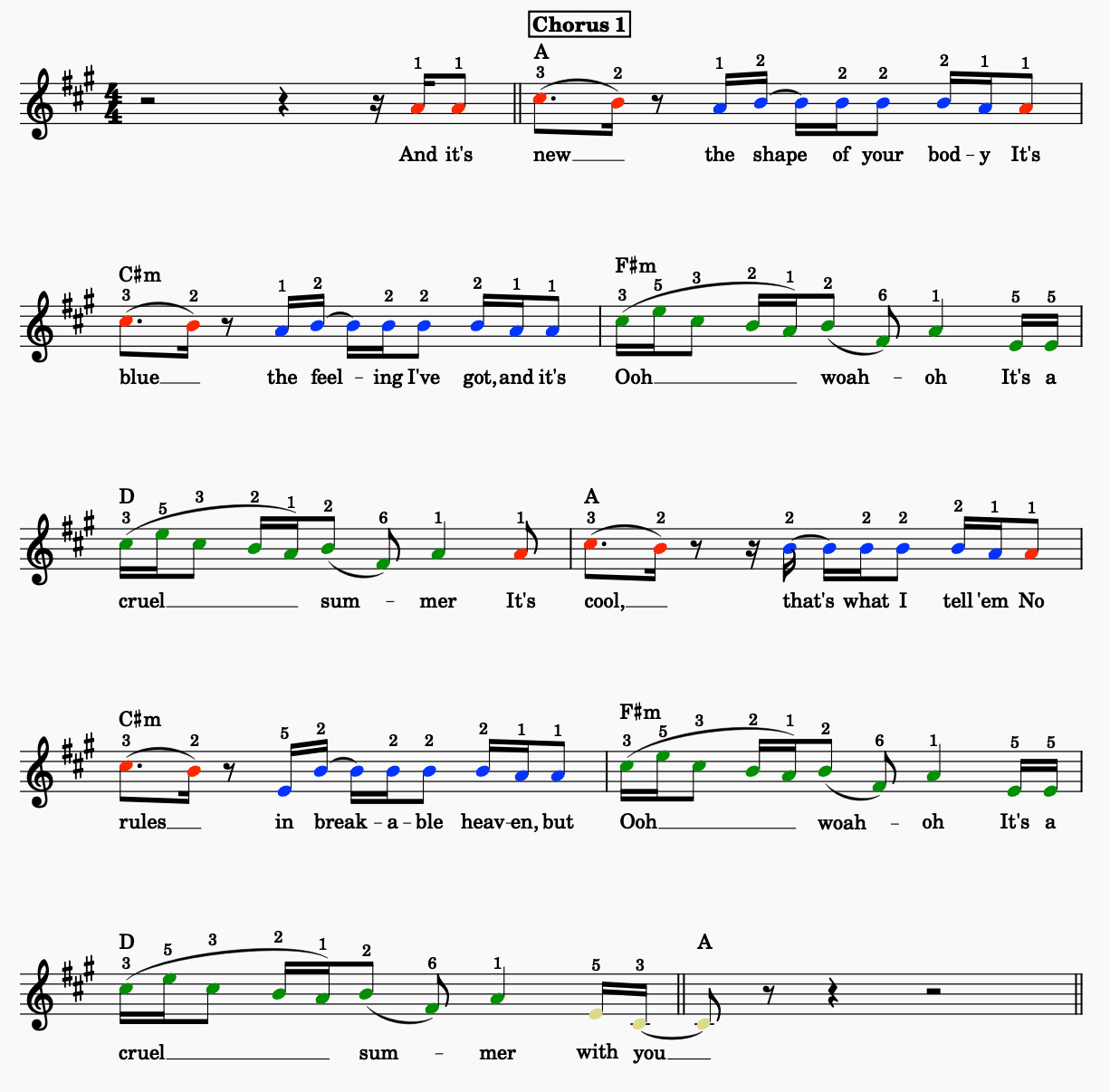

Melodic Structure Detail
*Note that all images and analysis shown below pertains to chorus1 unless otherwise noted. Differences between choruses 1, 2, and 3 if any, are detailed in each line grouping’s analysis.
Stanza 1
Lines 1 & 2


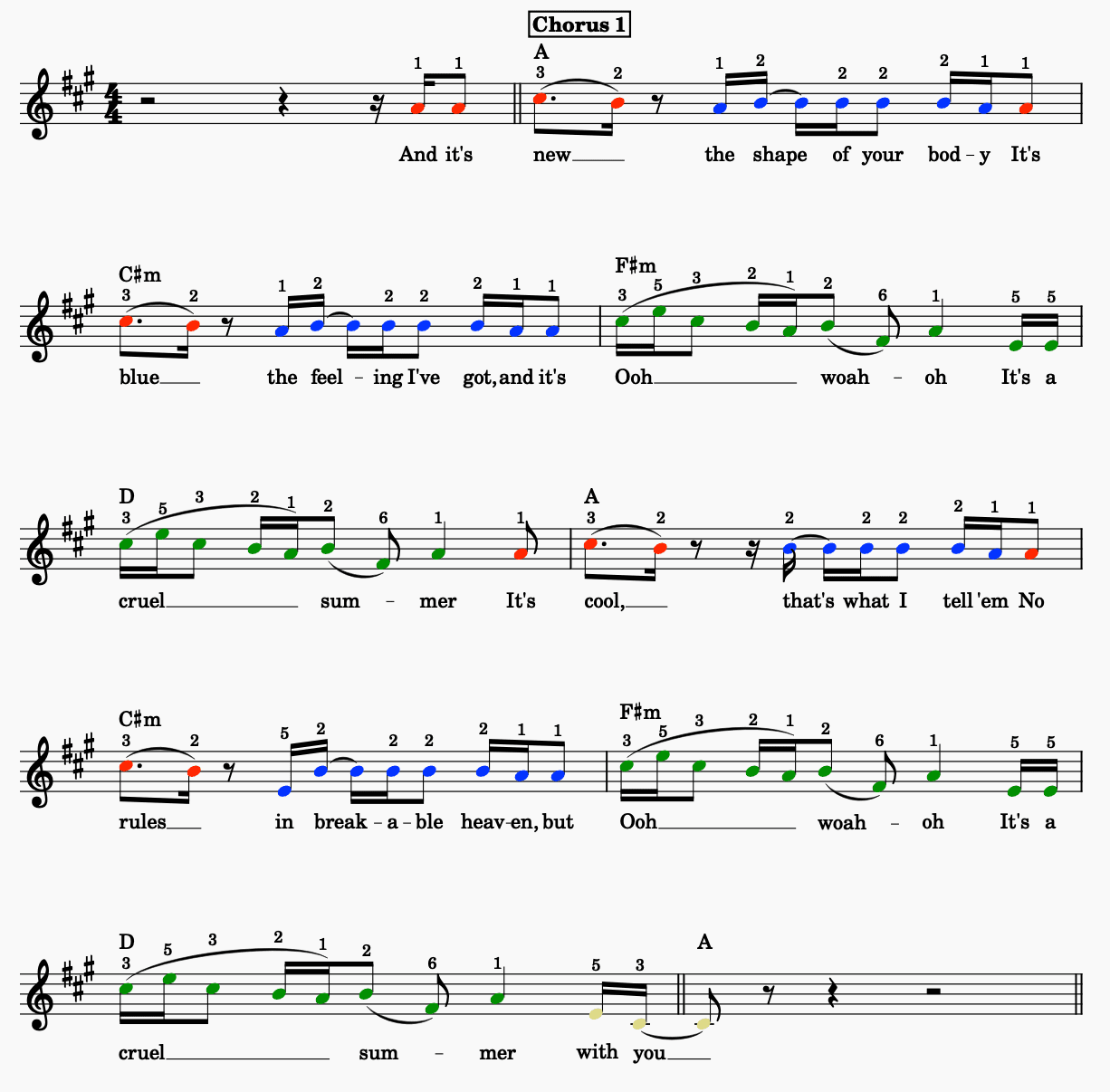

Line 1
Part a: And it’s new
Part b: The shape of your bod-y
Line 1 is composed of subparts a and b. Subpart a begins the chorus with an engaging leap of a sixth up to the root, followed by sustaining on a 3-2 slur on the lyric “And it’s new.” Along with notably heightening interest at the top of the section, this high-register vocal also serves to bolster the lyric’s emotional impact and set the stage for the developments that lay ahead.
Subpart b follows with a melodic shape that’s in line with the verse melodies, albeit an octave above. This fosters melodic familiarity in the scope of the song while the higher register keeps the chorus’ emotional intensity at a high.
Line 2
Part a:
It’s blue
Part b:
The feel-ing I’ve got, and it’s
Line 2 is identical to line 1, save for slight rhythmic variations to accommodate the new lyrics.
Note that there is no melodic or rhythmic segmentation between lines, with the eighth rest appearing after the lyric “blue.” This achieves the following:
- The omission of the rest provides a continuous flow between lines.
- The inclusion of the rest after “blue” makes the section easier to digest and remember while bolstering the melodic and rhyme connections between “blue” and “new” along with their sustained qualities.
Lines 3 & 4




Line 3
Part c: Ooh woah-oh
Line 3 is composed of subpart c. Beginning a third above where line 2 leaves off, it subsequently leaps to scale degree 5, the highest pitch in the song, before generally progressing down to the root with rises and falls along the way. This, along with its engaging fast-to-slow rhythm, achieves the following:
- The melismatic quality and large range further showcases Swift’s stellar vocal chops.
- The pairing with the nonsense lyric cleverly communicates the emotion Swift feels without the need to outright say it (i.e., a “show, don’t tell” approach).
- It foreshadows and subsequently reinforces the song title hook melody that follows.
Line 4
Part c: It’s a cruel sum-mer
Line 4 is nearly identical to its line 3 counterpart, save for the “it’s a” pickup on scale degree 5 that lead into the song title hook.
Stanza 2
Lines 5 & 6




Line 5
Part a: It’s cool
Part b: That’s what I tell ‘em
Line 5 is nearly identical to its line 1 counterpart, save for slight rhythmic differences.
Line 6
Part a: No rules
Part b: In break-a-ble heav-en, but
Line 6 is nearly identical to its line 2 counterpart, save for slight rhythmic differences.
Lines 7 & 8




Line 7
Part c: Ooh woah-oh
Line 7 is identical to its line 3 counterpart.
Line 8
Part c: It’s a cruel sum-mer
Part d: With you
Line 8 is nearly identical to its line 4 counterpart, save for the extra subpart d melody at the end. Its addition serves to both accommodate the important lyric and bring the section to a resolved conclusion.
Bridges
Overview
The bridge is mainly comprised of repetitive A.M.P. (alternating melodic pattern)-like melodies that both adhere and to, and depart from, the K.I.S.S. ME principle.
The first three lines in both stanzas feature wide A.M.P.-like motion that is both easy to connect with and accentuates the emotion of the storytelling lyrics. In contrast, the tighter, higher register and more direct qualities of lines 4, 8 and 9, while more difficult to sing, accentuate the impact of key lyrics and take the section’s emotional intensity to a climax along with Swift’s sung/shouted hybrid deliveries.
Furthermore, note that the descending 1-5 melodic progressions throughout the section foster familiarity with the pre-chorus, which makes the song more cohesive and memorable in an under-the-radar manner that the listener will likely not even realize.
Melodic Structure Overview & Detail
Bridge 1 Melodic Direction: At-A-Glance


Chorus Melodic Direction: At-A-Glance


Pre-Chorus Melodic Direction: At-A-Glance


Verse 1 Melodic Direction: At-A-Glance


Verse 2 Melodic Direction: At-A-Glance


Intro & Outro Melodic Direction: At-A-Glance


Bridge 1 Melodic Part Structure: At-A-Glance


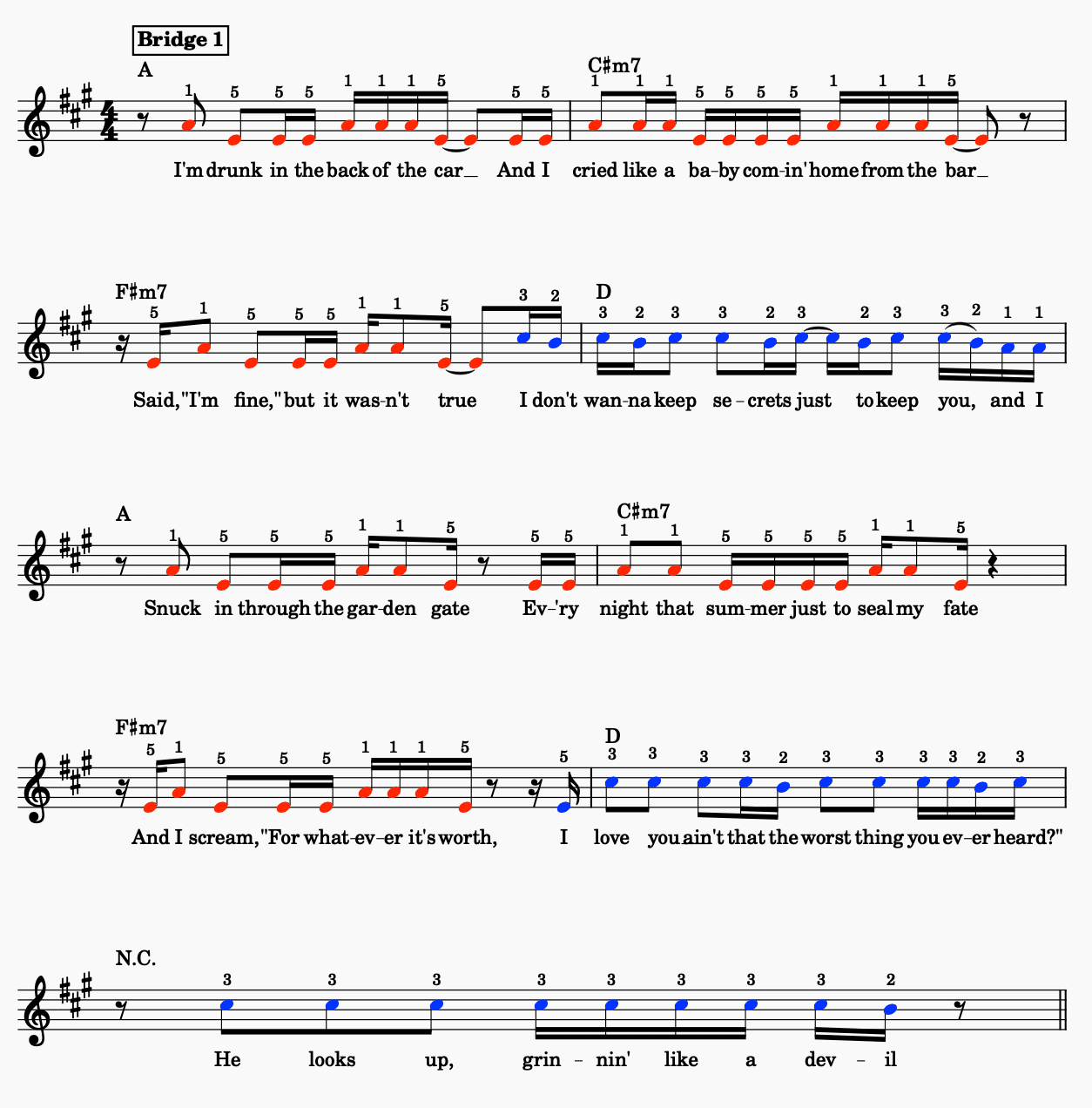

Melodic Structure Detail
Lines 1 & 2




Line 1
Part a1: I’m drunk in the back of the car
Line 1 is composed of subpart a1. It features simple, A.M.P.-like (alternating melodic pattern) motion that alternates between scale degrees 1 and 5 with an equally simple eighth and sixteenth note-driven rhythm.
Line 2
Part a2:
And I cried like a ba-by com-in’ home from the bar
Line 2 is composed of subpart a2. Highly similar to line 1, it keeps the listener locked in the catchy flow while its longer length and subtly altered rhythm accommodate the new lyrics and maintain interest.
Lines 3 & 4




Line 3
Part a1: Said, “I’m fine,” but it was-n’t true
Line 3 is composed of subpart a1. While it is highly similar to its line 1, a1 counterpart, it features subtle melodic and rhythmic differences that help to prevent redundancy and maintain interest.
Line 4
Part b1:
I don’t wan-na keep se-crets just to keep you, and I
Line 4 is composed of subpart b1. It provides engaging contrast against the other lines by leaping a sixth to scale degree 3 and then following a tight A.M.P. pattern across scale degrees 2 and 3 before stepping down to the root at the end. Driven with a vibrant eighth and sixteenth note rhythm, this variation takes the stanza to an emotionally excited peak that effectively serves the lyric along with Swift’s unique sung/shouted hybrid delivery.
Interesting to note is the conclusion on the root at the end. While this melodically resolves the first stanza, the lyric “and I” leaves it lyrically unresolved and maintains anticipation for the second stanza that follows.
Stanza 2
Lines 5 & 6




Lines 5 and 6 are nearly identical to their lines 1 and 2 counterparts, save for slight rhythmic differences. is composed of subpart a1. It is nearly identical to its line 1 counterpart, save for slight rhythmic differences.
Lines 7 – 9


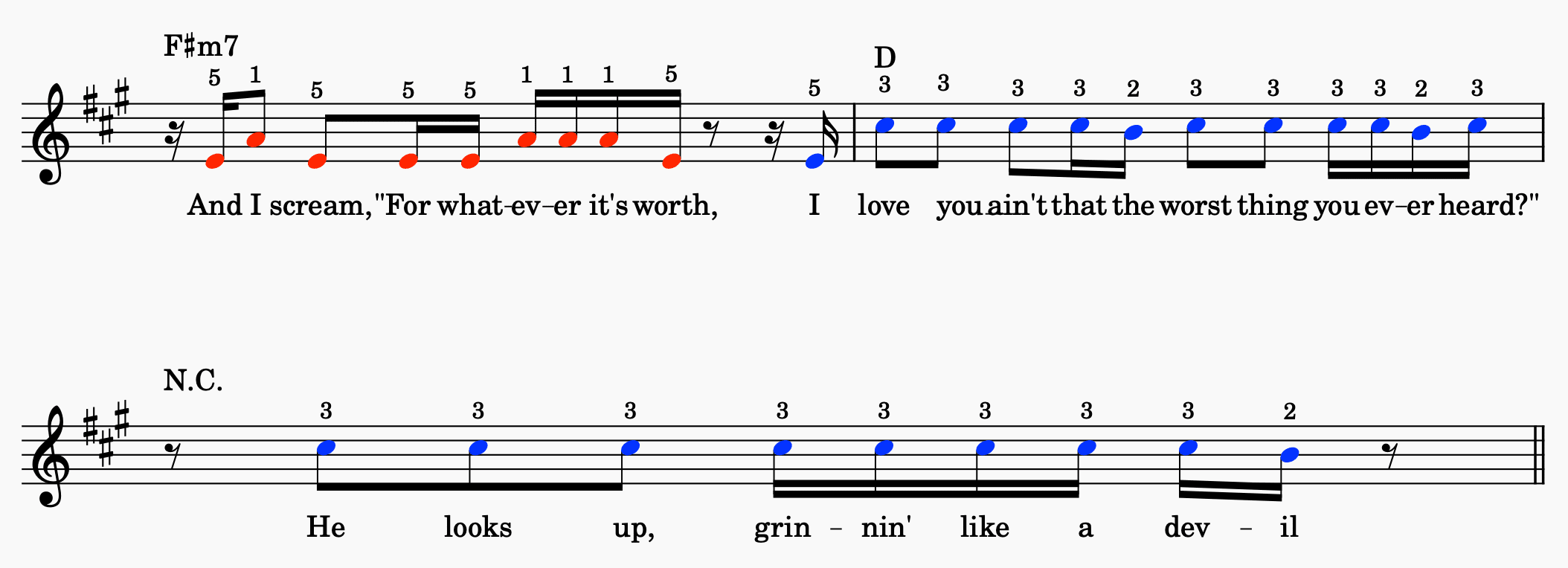

Line 7
Part a1: And I scream, “For what-ev-er it’s worth”
Line 7 is composed of subpart a1. It is nearly identical to its line 3 counterpart, save for slight rhythmic differences.
Line 8
Part b2:
I love you ain’t that the worst thing you ev-er heard?”
Line 8 is composed of subpart b2. While highly similar to its line 4 counterpart, it features rhythmic variation and more stagnant motion that serves to maintain interest and deliver the lyrics in a more direct manner. In addition, note that the rhythmic variation serves to subtly highlight the key lyrics, “love you” and “worst thing.” The line concludes on scale degree 3 as opposed to the root, which serves to transition into the unique line 9 that follows.
Line 9
Part b3:
He looks up, grin-nin’ like a dev-il
Line 9 is composed of subpart b3. The most direct line in the section, it is entirely centered on scale degree 3 and possesses a string of eighth and sixteenth notes. Along with heightening interest in the full accompaniment pull “Super S.I.A.” (section impact accentuator – see the instrumental arrangement and energy section for details), the varied rhythm across the “he looks up” and “grinnin’ like a devil” segments serve to highlight each lyrical aspect and bolster the line’s overall impact along with Swift’s sung/shouted hybrid delivery.
The line and section conclude on scale degree 2 as opposed the root, which heightens tension leading into the ensuing final chorus.
Lyrics & Rhymes
Rhyme Schemes
Overview
“Cruel Summer” features an abundance of expertly crafted rhymes and other lyrical connection accentuators that bolsters the song’s ability to connect and resonate. Among them are logically unfolding end-of-line rhyme schemes and a plethora of strategically placed internal rhymes, double rhymes, alliterations, lyrical repetitions, cross-section commonalities and unique pronunciations to make rhymes happen where they otherwise wouldn’t.
At-A-Glance: End-Of-Line Rhymes Section-By-Section
Key
A, B & C: End-of-line rhymes
X: Non-rhymes
Lyric/Syllable: The primary rhyme at the end of each line
Underline: Repetitive lyrics
Colors and rhyme schemes are unique to each section
*For simplicity of analysis, note that only lyrics connected by both rhyme and another notable characteristic (i.e., proximity, placement, melodic connection, etc.) are shown in each table. Lyrics that rhyme but are otherwise unconnected are not noted.


Intro, Turnaround & Outro


“Cruel Summer’s” intro, turnaround and outro simply feature the repetition of the lyric “yeah.”
Verse 1


End-Of-Line Rhymes
Verse 1 follows a two-line, AA rhyme scheme, both concluding with the lyric “it.”
Internal Rhymes, Alliteration & Other Connection Accentuators
In addition to its end-of-line rhymes, verse 1 features a host of other lyrical connection accentuators, including:
- The “caught” and “bought” rhymes, which create a double end-of-line rhyme with the lyric “it.”
- The “the night” and “a price” double rhymes at the end of the first segment in both lines.
- The similarly placed “EYE”-sounding internal rhymes within both lines.
- The “bad, bad boy” alliteration at the beginning of line 2, which is complemented by the “boy” / “toy” internal rhyme.
- The “you know that I” repetition in the second segment of both lines.
Verse 2


End-Of-Line Rhymes
Like verse 1, verse 2 follows a two-line AA end-of-line rhyme scheme. However, the rhyming lyrics differ with the “-ing” commonalities.
Internal Rhymes, Alliteration & Other Connection Accentuators
Also like verse 1, verse 2 features additional lyrical connection accentuators that serve to heighten cohesion and memorability. They include:
- The “dy-” and “try-” rhymes, which create double end-of-line rhymes in the lyrics “dy-ing” and “try-ing.”
- The “low” / “glow” internal rhymes in line 1. Note the similar positioning as “high” and “QUI-et” in verse 1, which creates structural familiarity across verse sections.
- The “just” / “up” rhyme in line 2, which features similar placement as “low” / “glow” in line 1.
- The alliteration in the lyrics “hang” and “head” at the beginning of line 1 and “try-ing times” in line 2.
- The similarly placed “-ing,” which appears at nearly the same spot internally and at the end of each line.
- The repetition of the lyric “not” preceding the two end-of-line rhymes. This is another commonality shared with verse 1, which features lyrical repetition preceding its end-of-line rhymes.
Pre-Chorus 1


End-Of-Line Rhymes
Pre-Chorus 1 follows a four-line AAXA rhyme scheme. Lines 1, 2, and 4 share the “OH”-sounding commonality in “win-dow,” “be-low,” and “more.” Note that Swift alters her pronunciation of “more” to emphasize the “OH” sound and bolster the connection to “win-DOW” and “be-LOW.”
Internal Rhymes, Alliteration & Other Connection Accentuators
Like the verses, the first pre-chorus features a host of other connection accentuators that bolsters its ability to connect and be remembered. They include:
- The strategic internal rhymes at the end of segmented phrases in lines 1 and 3. “Slow” in line 1 further bolsters the connection of the “OH” end-of-line rhyme, while the “dice” / “eyes” rhyme in line 3 heightens its connectability despite its lack of an end-of-line rhyme.
- Use of alliteration in lines 2 and 4, most notably with the line 4 lyrics “me, makes, me.”
- Two instances of repetitive lyrics: “waiting” in line 2 and the similarly placed “roll” in line 3.
Pre-Chorus 2


End-Of-Line Rhymes
Pre-Chorus 2 differs from pre-chorus 1 both in terms of its lyrics, save for line 3 (an atypical quality found in hit songs), and its rhyme scheme. Its four lines follow an ABAB scheme, with the A’s connected by the “EYE”-sounding rhyme in the lyrics, “knife” and “eyes,” and the B’s connected by the “OH”-sounding rhyme in the lyrics, “bone” and “oh.”
Internal Rhymes, Alliteration & Other Connection Accentuators
Further bolstering the connection value of pre-chorus 2 are the other following lyrical connection accentuators:
- The “EYE”-sounding internal rhymes at the end of the first segment in lines 1 and 3, both of which reinforce the end-of-line rhymes.
- The abundant “UH”-sounding rhymes across lines 1 and 2, which heighten cohesion against the different-sounding end-of-line rhymes.
- The double “know” / “oh” end-of-line rhyme in line 4.
- Alliteration in lines 2 and 3.
- Commonalities with pre-chorus 1, including the repetition of line 3; the use of the “OH”-sounding end-of-line rhyme; and the “EYE” end-of-line rhyme, which was initially featured as the sole non-end-of-line rhyme in both segments of line 3 in pre-chorus 1.
Choruses
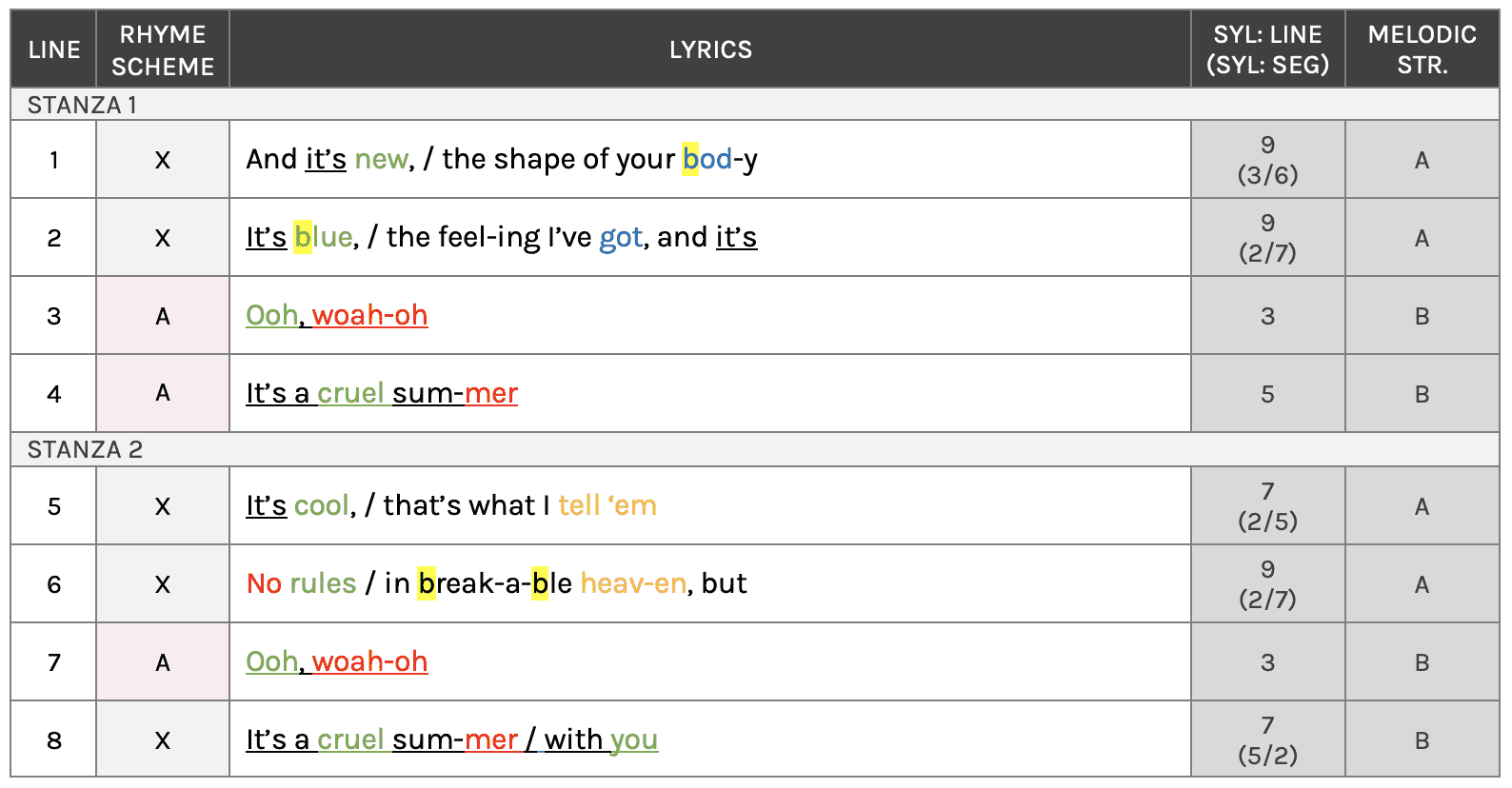

End-Of-Line Rhymes
The chorus interestingly goes against one’s likely expectations of a song’s primary “hook center” featuring the greatest degree of end-of-line rhymes. Instead, only two adjacent lines – lines 3 and 4 (“oh” and “sum-AH”, respectively) have an end-of-line rhyme connection, which is mainly due to Swift’s creative pronunciation of “summer” to make the rhyme happen. Note that this is well warranted since these two lines are the song’s main vocal hooks (along with the vocoder “yeah”). While lines 7 and 8 feature the same core lyrics, note that line 8 tacks on the lyric “with you” at the end, which breaks the end-of-line rhyme connection present in lines 3 and 4.
Internal Rhymes, Alliteration & Other Connection Accentuators
In lieu of strong end-of-line rhymes, the chorus features a host of internal rhymes, alliteration and repetitive lyrics that ensures it still fully connects and resonates. They include:
- The similarly placed “OOH”-sounding rhyme toward the beginning of each line. Note that the melodic variation against the melodies that precede and follow enables them to further stand out and connect.
- The “AH”-sounding rhyme toward the end of lines 1 and 2 in the lyrics “BOD-y” and “got,” which are close proximity to where an end-of-line rhyme would be.
- The similarly placed double rhymes “tell ‘em” and “heav-en” at the end of lines 5 and 6. Note that the lyric “but” at the end of line 6 prohibits this from being considered an end-of-line rhyme.
- Alliteration across lines 1 & 2 (“body” / “blue”), and line 6 (“break-a-ble”).
- The repetition of the lyric “it,” along with its similar placement at/near the beginning of lines 1, 2, 4, 5 and 8).
- The repetition of the nonsense lyric and song title hook across the last two lines of both stanzas.
Bridges
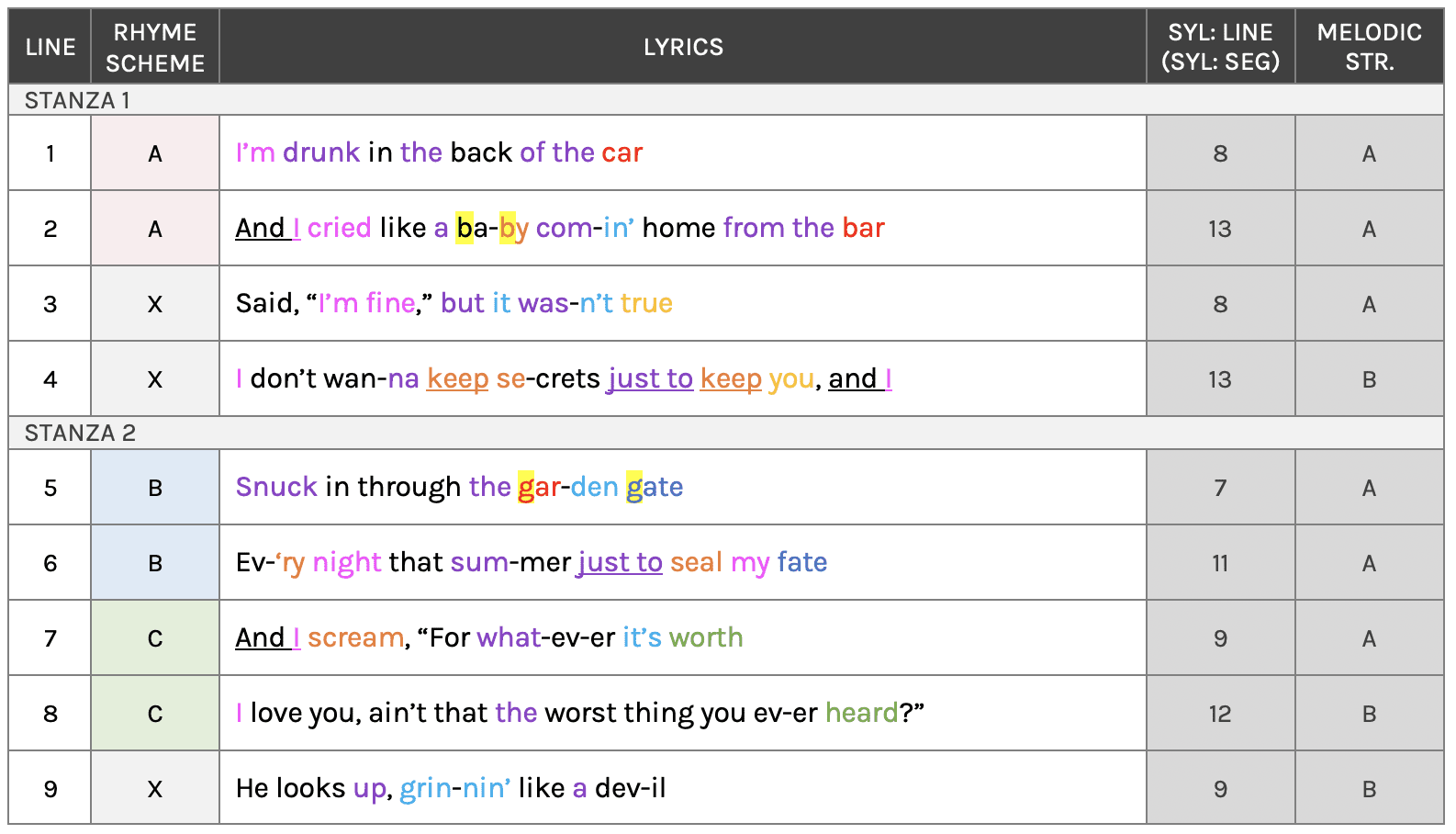

End-Of-Line Rhymes
Bridge 1 follows an AAXX/BBCCX rhyme scheme across its two stanzas. The A rhyme scheme features the “AR”-sounding commonality in the lyrics “car” and “bar,” the B scheme features the “AY”-sounding commonality in the lyrics “gate” and “fate,” and the C commonality features the “ER”-sounding commonality in “worth” and “heard.” Note that while lines 3 and 4 feature a close end-of-line rhyme in the lyrics “true” and “blue,” it is prevented by the inclusion of the lyric “and I” at the end of line 4.
Bridge 2 is identical to bridge 1, save for the omission of line 9.
Internal Rhymes, Alliteration & Other Connection Accentuators
In addition to its end-of-line rhymes, the bridge features a host of other connection accentuators, including a plethora of internal rhymes, strategic repetition and alliteration:
- The similarly placed “UH” internal rhyme, which appears in every line in lyrics including “the, “a,” “just,” “snuck,” and the creative pronunciation of the lyric “to” as “tUH” in lines 4 and 6, among others.
- The similarly placed “EYE” internal rhyme, which appears at or near the beginning of each line in stanza 1.
- The repetition of the lyrics “and I,” “just to” and “keep.”
- Alliteration in lines 2 and 5 in lyrics “ba-by” and “gar-den gate,” respectively.
Narrative
Overview
In addition, the lyricism and overarching story creates intrigue as to which boyfriend Taylor Swift is singing about and also cleverly relates to other songs within her body of work. An example is the standout lyric, “devils roll the dice, angels roll their eyes,” which appears on a board game in Swift’s “Lover” music video. While this reference will likely go unnoticed by the casual listener, for diehard Swift fans it’s an easter egg of a find.
Lyrical Theme Trends
In terms of its subject matter, breakup/love-gone-bad has nearly tripled in popularity since 2022, rising to 60% of songs in the first half of 2023. Conversely, romantic/being in love subject matter has been in decline over the same period, accounting for just 17% of songs in the first half of 2023.
Lyrical Themes In Non-Hip Hop Hot 100 Top 10 Hits: 2018 – Q2 2023
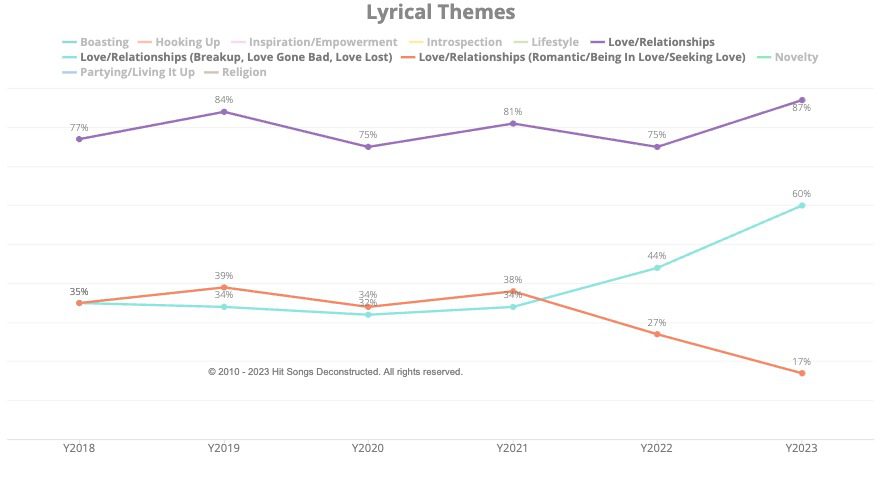

Narrative Flow: At-A-Glance


Key
Pers. (Perspective): The character whose perspective is most reflected in each line (Swift, lover, both, others)
Tone: The tone of the line, either positive (P) or negative (N)
Parentheses: P.O.V., Tone or A.I.D.E. component is implied and/or relates to the preceding line
A.I.D.E. Table: Reflects the type of lyricism being used in each line (action, imagery, detail devices, emotion) and whether the lyric is common or clever.
- Action: Describes a past, present or future physical action.
- Imagery: Describing something or someone that conjures up an image.
- Detail Devices: Enhancing the lyrics through notable descriptive adjectives, adverbs, idioms, metaphors and similes.
- Emotion: Lyrics that describe the way someone feels or elicit a feeling
Colors are specific to the table at hand
Intro & Outro


Verse 1




Overview
Verse 1 officially begins “Cruel Summer’s” love/relationships-themed narrative by establishing Swift’s intense desire for someone that may come with negative consequences over the course of two lines. It is communicated entirely from Swift’s point-of-view, using an effective combination of positive and negative tones and clever and common lyricism to impactfully convey the story while ensuring that the listener can still easily grasp what it’s all about.
Key Points
- While the song’s official opening line, “Fever dream high in the quiet of the night, you know that I caught it,” is captivating and intriguing, it means little without the important substantiation that follows on line 2, “Bad, bad boy, shiny toy with a price, you know that I bought it,” which puts it into perspective. This exemplifies the importance of always ensuring that the listener can grasp what is going on in the story.
- Both lines feature lyrics that possess a combination of positive and negative tones, which sets the tone for the overall story that lies ahead
- A “fever dream” is a highly vivid dream that is often distressing, which sets the stage for the problematic nature of the relationship. However, when taken into account with the “high in the quiet of the night” lyric that follows, it infers Swift’s intense desire for someone that she can’t get out of her head.
- “Bad, bad boy, shiny toy with a price” conveys a few key things. They include her love interest’s bad boy persona, insight into the kind of person Swift is attracted to along with his implied good looks (“shiny toy”), the beginning of the relationship (a “shiny toy” is also something that is new and desirable), and the fact that the relationship might not end well (“with a price”).
- The lyrics “you know that I caught it” and “you know that I bought it” cleverly convey Swift’s full desire and commitment to being with this person.
- The vocoder-processed background vocals, “oh yeah, you’re right, I want it,” convey Swift’s intense desire for this person in a straight-forward, embellishing, “nano hook” manner. Furthermore, note that the vocal’s processing and background positioning can be construed as Swift’s subconscious depicting what she really wants, despite the possible negative aspects conveyed in her lead vocal. This cleverly provides the narrative with increased clarity against the metaphorical lyrics.
Pre-Chorus 1




Overview
Pre-chorus 1 elaborates on the verse premise in a fresh, intriguing way. Communicated mainly from Swift’s point-of-view, it uses all A.I.D.E. components to further convey her intense desire to take a chance on her “bad boy” love interest, despite the likely repercussions. In addition, it serves to lyrically set up the chorus that follows, which is the main job of the pre-chorus.
Key Points
- Lines 1 and 2, “Killing me slow, out the window / I’m always waiting for you to be waiting below” function as a cohesive lyrical pair. Their metaphorical qualities cleverly and impactfully convey the intense anticipation and longing Swift feels when not around this person. However, when delving deeper, another even cleverer scenario comes to mind. These lyrics can also be likened to the balcony scene in the tragic love story of Romeo & Juliet, where Juliet awaits Romeo’s arrival outside her window to meet. This cleverly provides the story with more intrigue and depth while remaining in line with its overall message.
- Line 3, “Devils roll the dice, angels roll their eyes,” is one of the cleverest and most impactful lines in the entire song. Using all aspects of the A.I.D.E. principle, “Devils roll the dice” cleverly conveys the chance Swift is willing to take on her bad boy love interest, while “angels roll their eyes” reflects her going against her better judgement.
- Line 4, “What doesn’t kill me makes me want you more,” essentially summarizes Swift’s continued intense desire for her love interest despite the relationship’s negative qualities. This effectively sets the stage for Swift’s conflict that follows in the chorus summation. In addition, note that the lyric is also a clever play on “what doesn’t kill you makes you stronger.”
Chorus




Narrative Overview
The chorus is composed of two, four-line stanzas and delivers “Cruel Summer’s” lyrical summation. Stanza 1 summarizes both Swift’s exhilaration and pessimism toward the new relationship, while stanza 2 infers that she accepts the uncertainty and the seeming casualness of the relationship, even though it is taking a negative emotional toll on her.
Stanza 1 Key Points
Stanza 1 is communicated from Swift’s point-of-view, in the present tense, and uses an effective combination of detail devices, emotive lyrics, and clever and common lyricism to convey the summation in an impactful manner.
- Line 1, “And it’s new, the shape of your body,” cleverly substantiates that it is a new relationship while inferring Swift’s physical attraction to him. Note that this ties in with the “shiny toy” reference in verse 1.
- Line 2, “It’s blue, the feeling I’ve got,” conveys Swift’s underlying sadness and distress for the relationship’s likely negative outcome. This was previously intimated in the first verse with the lyrics “fever dream” and “shiny toy with a price.”
- Line 3, “Ooh, woah-oh,” is a nonsense lyric that serves a variety of purposes: Lyrically, the clever use of the lyric “woah” jibes with the section’s negative connotation, due to its homophonic relation to the lyric “woe” (i.e., “woe” is a word that communicates great sorrow or distress). In addition, “woah” is a highly common nonsense lyric used in a plethora of hit songs, creating mainstream familiarity. Melodically, it foreshadows and subsequently reinforces the song title hook melody that follows in line 4 along with showcasing Swift’s vocal chops (reference the Vocal Melody section of the report for details).
- Line 4, “It’s a cruel summer,” works hand in hand with the nonsense lyric that precedes it to encapsulate the entire essence of the narrative and the way that Swift feels about the situation – her intense desire for this person and the likely negative outcome. Furthermore, it provides the narrative with heightened depth by tying it into a summer fling scenario.
Stanza 2 Key Points
Stanza 2 is also delivered from Swift’s point-of-view and communicated using an effective combination of detail devices, emotive lyrics, and clever and common lyricism.
Lines 5 and 6 provide additional information into Swift’s psyche as it pertains to the overall situation. Line 5, “It’s cool, that’s what I tell ‘em,” reiterates her seeming acceptance of the way things are. Line 6, “No rules in breakable heaven,” builds off line 5 by providing additional detail into her mindset. The lyric is a clever way of stating that the relationship is casual, without stringent rules. While it can be great (“heaven”), it is also fragile and can lead to ruin (“breakable”).
Lines 7 and 8 conclude the section on a familiar and catchy note by reiterating the nonsense lyric and song title hook that close out stanza 1.
Verse 2




Narrative Overview
Where verse 1 focused on both the positives and negatives of the new relationship, the verse 2 development veers the story into more overtly negative territory with the relationship’s impending demise. However, the inclusion of the vocoder-processed background vocals, which are a commonality between both verse sections, continues to reinforce Swift’s inner-voiced desire for her love interest.
Key Points
- Line 1, “Hang your head low in the glow of the vending machine, I’m not dying,” utilizes an effective combination of imagery and emotion to impactfully depict Swift’s downtrodden yet persevering state. Note the clever tie-in with pre-chorus 1, “what doesn’t kill me makes me want you more.”
- Line 2, “We say that we’ll just screw it up in these trying times, we’re not trying,” conveys both character’s sentiments concurrently for the first time in the song, providing the narrative with heightened depth. Building off line 1, it communicates two key points: Surrounding circumstances (“trying times”) might be impacting the relationship’s ability to flourish, and they’re seemingly not trying to make the relationship work.
Pre-Chorus 2




Narrative Overview
Pre-chorus 2 goes against the grain of many hit pop songs by lyrically developing over its pre-chorus 1 counterpart. Lines 1, 2 and 4 provide development, while the reprise of the impactful line 3, “Devils roll the dice, angels roll their eyes,” maintains like-section familiarity and cohesion along with the similar melodies.
While this clever-leaning, A.I.D.E. principle-heavy pre-chorus can be interpreted in a multitude of ways, a likely interpretation following the “relationship heading south” development in the second verse is that Swift is expecting its inevitable end.
Key Points
- Line 1, “So cut the headlights, summer’s a knife,” uses all aspects of the A.I.D.E. principle to cleverly convey Swift’s inferred desire for her love interest to “turn the lights out” on the relationship because it’s becoming too difficult for her to bear (“summer’s a knife”). Additionally, the car reference can also be construed as relating to the bridge development, “I’m drunk in the back of the car.”
- Line 2, the somewhat cliché, “I’m always waiting for you just to cut to the bone,” solidifies line 1’s relationship-ending sentiment while completing the knife/cutting metaphor.
- Following the reiteration in line 3, line 4 closes out the section with the lyric, “And if I bleed, you’ll be the last to know.” Keeping cohesion with the “knife” and “cutting” references in the preceding lines, it conveys that when he finally does break up with her, and it hurts, that she won’t give him the satisfaction of knowing that it did.
Bridge 1




Narrative Overview
Following chorus 2, the song heads into the first of its two lyrically similar bridge “D” (departure) sections. Along with providing a melodic and instrumental departure in the scope of the song, they uniquely feature intriguing, emotive and vivid lyrical developments. This contrasts from the manner of Swift’s previous narration, providing the story with heightened depth while reiterating pre-established sentiments in a fresh and more direct manner:
- The relationship’s demise and Swift’s resulting heartbreak.
- The secretive nature of the relationship.
- Swift’s continued love for her love interest.
- Her love interest’s mischievous response to her love proclamation.
Compared to most of the other sections in the song, the bridge utilizes a greater degree of action and imagery-based lyricism, fewer detail devices (most notably metaphor), and leans more toward the common end of the spectrum as opposed to clever. Note that the latter two were necessary to ensure the listener easily and fully connects with the situations being illustrated. However, the bridge shares the commonality with the other song sections of every line featuring some degree of emotion.
Stanza 1 Key Points
Stanza 1 is communicated entirely from Swift’s point of view and depicts the aftermath of the breakup.
- Using all aspects of the A.I.D.E. principle, lines 1 and 2 paint a relatable scene of Swift “coping” with the breakup by self-medicating with alcohol, and the heartbreak she feels. However, note that the omission of specifics relating to the car and bar leave it open for the listener to interpret as they see fit
- Lines 3 and 4 shift to entirely emotive-based lyricism. They depict the confliction Swift feels about her emotions and her continued desire for her love interest despite the relationship’s demise. Furthermore, line 4 provides an intriguing development that the relationship was secretive, which is open to interpretation by the listener as to why (i.e., he’s cheating on her, she’s sneaking out at night, etc.).
Stanza 2 Key Points
Stanza 2 is communicated entirely from Swift’s point of view, save for the last line, which pertains directly to her love interest. It provides unique insight into the relationship’s history, Swift’s current feelings toward her ex, and her ex’s implied feelings towards her.
- Lines 5 and 6 follow suit with their line 1 and 2 counterparts by illustrating an actual scenario that Swift has gone through, using all aspects of the A.I.D.E. principle to convey it in a profound manner. Building off the secretive development brought to light in line 4, it illustrates the frequency of the tryst (“every night”), and the impending negative outcome (“seal my fate”). Essentially, this confirms what Swift alluded to all along – the relationship was never going to work.
- Lines 7, 8 and 9 bring the bridge to an impactful, emotive conclusion by depicting the only actual interaction between the two characters in the story. Lines 7 and 8 powerfully convey Swift’s intense desire and love for this person, while line 9 illustrates his zinger of a response, “he looks up grinnin’ like a devil.” However, it shouldn’t come as a surprise to Swift, as she seemingly understood the nature of the relationship as brought to light in the chorus, “no rules in breakable heaven.” All in all, these lines cleverly sum up what has been alluded to all throughout the song.
Song Title
Clever/Powerful or Universal/Generic
“Cruel Summer” falls on the attention-grabbing/powerful end of the spectrum through its use of adjective (“cruel”), time period (“summer”), and the intrigue it creates as it pertains to Taylor Swift.
Song Title Word Count
Song Title Word Count: Non-Hip Hop Hot 100 Top 10 Hits (2018 – Q2 2023)
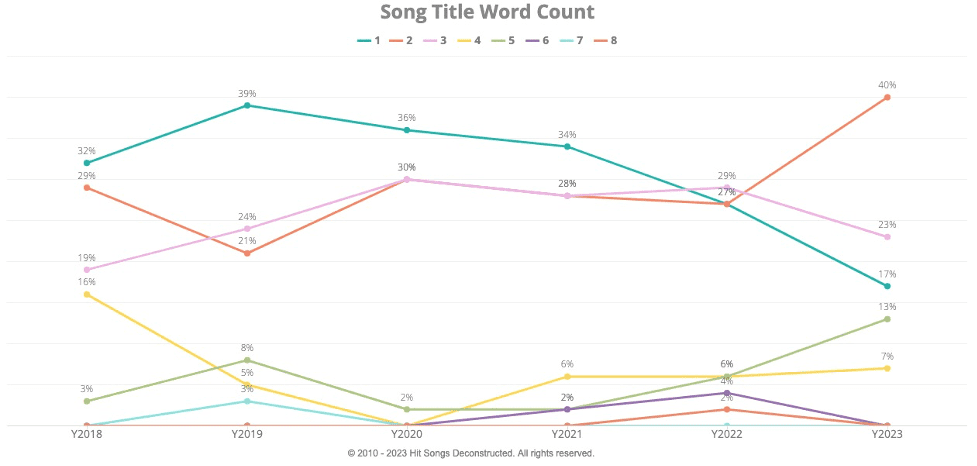

Song Title Appearances and Placement
In terms of placement, the chorus is by far the most popular section to feature the song title at 84% of non-hip hop hits over the past five years, with the outro trailing distantly at just under one-third (note that song titles can appear in multiple sections). Furthermore, the title is primly placed at the end of each stanza, where it provides the impactful narrative summation.
Song Title Appearances: Non-Hip Hop Hot 100 Top 10 Hits (2018 – Q2 2023)
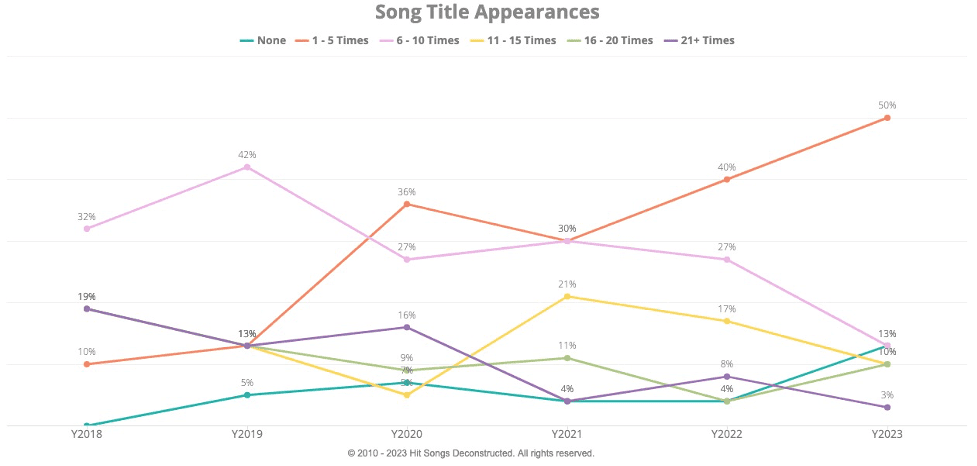

Song Title Placement: Non-Hip Hop Hot 100 Top 10 Hits (2018 – Q2 2023)
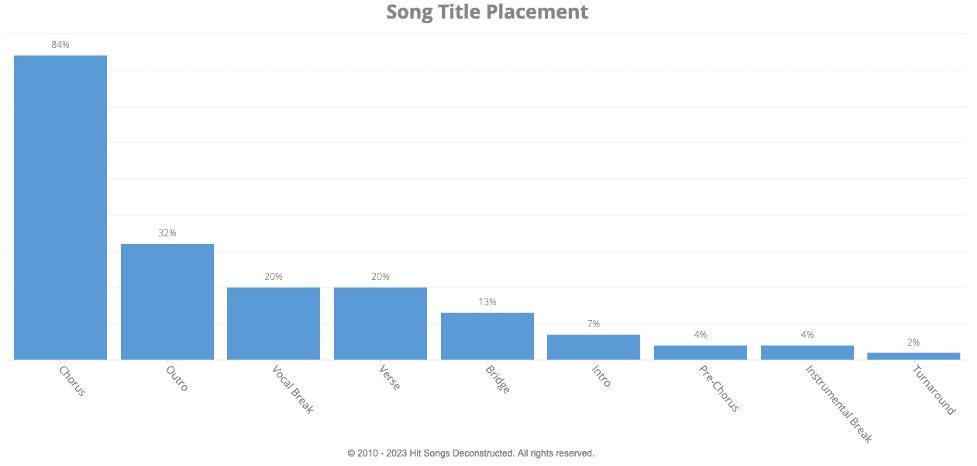

Word Cloud


Benchmark
This section spotlights “Cruel Summer’s” familiarity and standout factors relative to the Hot 100 Top 10, both as a whole and independently of the hip hop genre specifically, in the quarter before the song entered the Hot 100 Top 10 (Q2 2023). The familiarity factors enable “Cruel Summer” to connect with a mainstream audience more easily, while the more atypical factors help it to stand out from the pack.
Of the categories benchmarked in the table below, “Cruel Summer” is in line with 71% of the top characteristics in the overall Hot 100 Top 10 and 75% in non-hip hop hits specifically.


“D” Section: A section that provides a pronounced vocal, lyrical, instrumental and/or energy level departure around two-thirds of the way into a song. “D” sections can include bridges, bridge surrogates, and diversified recycled sections.
*Indicates a particular song characteristic falling within a 5% margin of error of the most popular compositional characteristic in a given category
Additional Familiarity & Standout Factors
In addition to the commonalities shown in the chart above, other factors that contributed to “Cruel Summer’s” ability to easily connect with mainstream audiences include its K.I.S.S. ME melodies (Keep It Simple, Singable and Memorable), catchy vocal hooks, strong, effective rhymes, logical, easy-to-follow structure, and engaging, relatable subject matter, to name a few.
Conversely, a few notable places where the song stood out among its contemporaries is its inclusion of two bridge sections as opposed to one, super short verse sections, relatively uncommon vocoder hook, and abundance of clever, metaphorical lyrics.
Companion
Logic Project
This file includes the correct meter, tempo and song arrangement displayed as empty MIDI regions for each instrument. Load your copy of the song to see when each instrument enters and leaves the mix, how the arrangement of like and cross-sections compare, how energy and dynamics are working from an arrangement point of view, and more.
Skip To:

